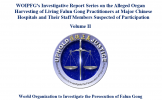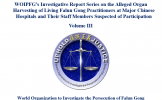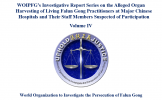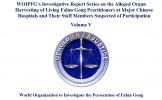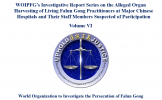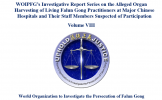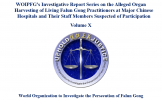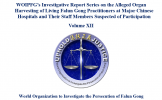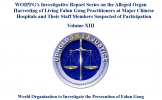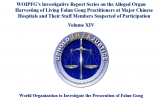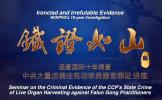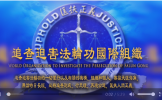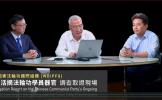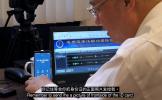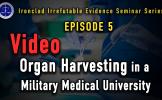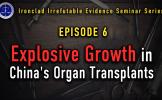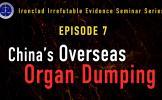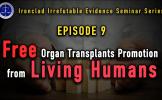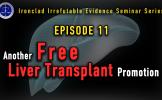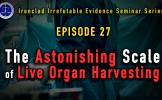WOIPFG’s Investigative Report on the Development Model of the CCP’s "Industrial Chain of Forced Organ Harvesting" along the One Belt, One Road Initiative
This investigative report aims to reveal the deep connection between the CCP’s organ transplant system, which has been industrialized, and the “One Belt, One Road” initiative, focusing on analyzing how the CCP uses the “One Belt, One Road” platform to spread its anti-human crime of forced organ harvesting to the international community. In recent years, the number of organ transplants in China has increased dramatically, the waiting time for organs is unusually short, and the source of donors is unusually sufficient, indicating that China may have a huge and highly concealed donor system for its anti-human crime of forced organ harvesting.
This investigative report focuses on how the CCP uses the "One Belt, One Road" initiative to promote the establishment of a transnational transplant cooperation network and export its questionable organ transplant model to countries along the route. Through extensive telephone investigations, data comparisons, document reviews, and field visits, this report has obtained a number of key evidences, clearly pointing out:
1. Many hospitals in China generally use Falun Gong practitioners as organ donors.
2. The waiting period for organ transplants is as short as a few days, which is much lower than the international average waiting time.
3. The actual transplant volume far exceeds the official data released by the CCP, and is seriously inconsistent with the number of voluntary donations by citizens.
The above facts constitute a strong accusation that the CCP's organ transplant system has a systematic, anti-human crime mechanism for its forced organ harvesting.
The connection between the CCP's persecution of Falun Gong started in 1999 and the organ transplant industry
In 1999, the CCP launched a full-scale persecution of Falun Gong. Since then, the number of organ transplants in China has exploded, and the two have a high degree of overlap in time, causing serious suspicions from the international community about the source of organs. Although the CCP first claimed that the organs mainly came from death row prisoners, and later stated that it would establish a voluntary donation system for citizens, no matter what channel, the source of organs is not transparent and cannot be traced, and it has never been able to explain the huge gap between donation data and large-scale transplant operations.
Numerous independent investigations have shown that persecuted Falun Gong practitioners are systematically used as the main organ donors for forced organ harvesting. Without consent and while the victims are still alive, their organs are harvested for transplantation. This behavior constitutes a serious crime against humanity and is a crime of genocide committed by the state.
Since 2006, many international agencies have begun investigating China's organ transplant system. In 2015, the CCP announced that it would "completely stop using organs from executed prisoners," but the number of transplants has not decreased, instead, it has reached a new high.[1] In the same year, the organ donation data released by the Chinese Red Cross was seriously inconsistent with the transplant volume, and some provinces with large transplant volumes even reported that the number of donations was close to zero.[2] These obviously contradictory data further confirm that the CCP's organ transplant system is very likely based on a forced organ harvesting mechanism that is led by the state and systematically operated.
"One Belt, One Road" initiative as a carrier for the internationalization of the organ transplant industry
In 2013, the CCP rolled out its "One Belt, One Road" initiative, aiming to expand its influence in Europe, Asia and Africa. As of 2023, the CCP has funded more than 20,000 projects in 165 countries. Since 2016, the CCP has gradually incorporated the organ transplant industry into the "One Belt, One Road" framework. By establishing the "One Belt, One Road" international organ transplant cooperation and development alliance, the CCP built a platform for exporting organ transplant technology, training doctors, and establishing cooperative hospitals to countries along the route.
In 2017, Huang Jiefu, then member at director level of the Chinese Human Organ Donation and Transplantation Committee, explicitly proposed that organ transplantation be included as part of the CCP's "One Belt, One Road" initiative to strengthen the CCP's ties with countries in Asia, Europe, East Africa and Oceania.[3] At the Fourth China-International Organ Donation Conference held in Kunming in December 2019, representatives from 62 countries jointly issued the "Kunming Consensus on International Cooperation and Development of Organ Donation and Transplantation along the One Belt, One Road" and established the "One Belt, One Road International Organ Donation and Transplantation Cooperation and Development Alliance" [4]
Including organ transplantation in the framework of the “ One Belt, One Road” initiative has essentially promoted the export of the CCP’s model of forced organ harvesting to other countries. What is more serious is that some One Belt, One Road Initiative projects, such as the KK Park in Myawaddy, Myanmar, are involved in serious criminal activities such as organ trafficking, and these projects are officially called "key projects" of the One Belt, One Road Initiative by the CCP. [5]
Research methods and sources of evidence used by the report
This investigative report uses a variety of research methods to collect and analyze evidence:
1. Public data collection and analysis: Systematically collect and analyze public data such as official media reports, hospital websites, medical journals, and government documents, and conduct comparative studies between official propaganda and actual conditions.
2. Telephone investigations: Conduct telephone investigations on hospitals suspected of participating in organ transplants in mainland China, Red Cross human organ donation agencies, and hospital OPOs (human organ procurement organizations), and record their responses to key questions such as organ sources, waiting times, and transplant volumes.
3. Data analysis: Compare and contrast the official organ donation data with the actual transplant volume, and analyze the gap between the two and its significance. Compare and contrast the differences in waiting times for organ transplants in China and internationally, and evaluate the abnormalities of China's organ transplant system.
4. Case studies: Through in-depth analysis of organ transplantation in specific hospitals and regions, such as Zhejiang University-affiliated First Hospital and Kunming City First People's Hospital, the operating model of China's organ transplantation industry is revealed.
5. International media and investigative reports: Comprehensive reference to international media reports and findings of investigation organizations, such as investigations on organ transplantation in China by media in South Korea, Japan, Taiwan, etc., to increase the diversity and reliability of evidence.
6. Cross-border investigation: Investigate relevant activities in countries along the "One Belt, One Road", especially in Southeast Asia, to reveal evidence of the overseas expansion of the CCP's organ transplantation model.
The main sources of evidence for this report include: public information on the official websites of hospitals, official media reports, academic papers published by doctors, telephone investigation recordings, patient testimonies, investigation reports of international organizations, and investigation reports of independent media.
Table of Contents
I. Overview of China’s organ transplantation system
1. Huge discrepancy between official and actual transplantation data
2. Claim that citizen organ donation is the only legal source contradicts reality
3. Contradictory remarks from officials such as Huang Jiefu on organ transplantation
4. Analysis of the phenomenon of abnormally short organ waiting time
1. The 2016 Beijing Conference: The starting point for the CCP to promote the internationalization of the crime of forced organ harvesting
2. The evolution of the seven international organ transplantation conferences (2016-2023)
3. The promotion of international organ transplantation cooperation by the top leaders of the CCP
4. The organizational structure of the "One Belt, One Road" Organ Transplantation Cooperation and Development Alliance
III. Regional organ transplant industry development model
1. Kunming model: border region radiates Southeast Asia
2. Typical case of Kunming City First People's Hospital
3. Content and impact of "Kunming Consensus"
4. Xi'an model: Central and western organ transplant demonstration center
5. Training network of the First Affiliated Hospital of Xi'an Jiaotong University
6. Scope of technology and personnel export
7. Guangzhou model: a hub for transplant tourism
8. International patients in hospitals affiliated to Sun Yat-sen University
9. Data analysis of Taiwanese patients going to mainland China for transplants
10. Hainan model: construction of an international organ transplant base
11. Special policies of Hainan Free Trade Port
12. Strategic layout of Hainan branch of 301 Hospital
13. Differences in organ donor ratios between Hainan and mainland China
IV. Case study of the First Affiliated Hospital of Zhejiang University School of Medicine
1. Organ transplantation strategy led by Zheng Shusen
2. Organ transplantation as the core of hospital development
3. Promoting the medical "One Belt, One Road" initiative
4. Cooperation with international authoritative organizations
5. Suspicious organ sources and investigation evidence
V. Establishment of an organ sharing mechanism between Hong Kong, Macao and Taiwan
1. China Organ Transplant Response System (COTRS)opens to Hong Kong, Macao and Taiwan
2. Analysis of major hospitals where Taiwanese go to mainland China for transplants
3.Establishment of mutual assistance mechanism for organ transplants between Hong Kong and mainland China
4. Shenzhen Hospital as an organ transplant center serving Hong Kong
5. Fujian Provincial Hospital's organ transplant services for Taiwan
VI. Current status of organ transplant tourism to China
1. Major hospitals have set up international medical departments to receive foreign patients
2. Patients from South Korea, Japan, and countries from the Middle East come to China for transplants
3. County and town hospitals also carry out a large number of transplants for foreign patients
4. International patients in second-tier city hospitals such as Sinopharm Dongfeng General Hospital
VII. The organ transplant chain in the One Belt, One Road countries
1. Investigation of organ trafficking in the KK Park in Myawaddy, Myanmar
2. Analysis of the price list for organ harvesting in Cambodia
3. The CCP exports transplant technology to less developed countries through the “One Belt, One Road” Initiative
4. The impact of international training programs and sharing of organ transplant technology
VIII. Key figures in the “One Belt, One Road” Organ Transplant Cooperation and Development Alliance
1. The background and controversy of Zheng Shusen as the Chinese chairman of the Transplant Cooperation and Development Alliance
2. Huang Jiefu promotes international organ transplant cooperation and advocates "transplant tourism"
3. The roles of major hospital directors and transplant experts in international expansion
4. Accountability of those involved
IX. Summary and analysis of investigation evidence
1. Evidence from telephone investigation recordings
2. Contradictions between official data and actual data
3. The correlation between hospital expansion and the increase of organ transplants numberss
4. Summary of reports from international media and investigation agencies
X. Conclusions and suggestions
1. Core issues found in the investigation
2. Actions that the international community should take
3. Suggestions for protecting the rights of victims
4. Directions for future investigations
1. Important telephone investigation recordings
2. Compilation of relevant official documents
3. List of hospitals and doctors involved
4. Relevant international legal documents
I. Overview of China’s organ transplantation system
1. Huge discrepancy between official and actual transplantation data
There is a huge difference between the organ transplant data officially released by the CCP and the actual transplant volume. According to public information, as of December 2023, the number of registered voluntary donors in China stood at 1,573 to 3,151, calculated based on international practice, while the official figures were as high as 49,857.[6] This gap cannot be explained by normal statistical errors allowed. Even with the total number of organ donations reported in various places including the hospital’s intensive care unit, the officially recognized transplant volume was still way too high.
What is even more concerning is that the number of official organ donations in cities where some hospitals with huge transplants is almost zero. For example, Beijing is a typical case of this situation. As an important center for organ transplantation in China, 23 large hospitals in Beijing have performed a large number of transplant surgeries, but the Beijing Red Cross Society has not carried out organ donation work.[7] Beijing is the capital of China and the city with the most organ transplant hospitals. Among the 178 organ transplant hospitals announced by the National Health and Family Planning Commission on February 11, 2018,[8] Beijing accounts for 23, doing the largest number of organ transplants. For example, Peking University People's Hospital revealed that it had completed more than 4,000 liver and kidney transplants in a year.[9]
In addition, the number of organ transplant hospitals in China is showing a rapid growth trend. Huang Jiefu revealed in March 2017 that in the next five years, the number of organ transplant hospitals in China will increase to 500;[10] in November 2020, he also stated that the number should increase to 300, and the number of organ transplants in China should gradually develop to 50,000 cases per year.[11] This scale of expansion plans is in sharp contrast to the actual number of voluntary donations from citizens in China.
2. The claim that citizen organ donation is the only legal source contradicts reality
On January 1, 2015, the CCP announced the suspension of the use of organs in death row, claiming that "voluntary donation of Chinese citizens is the only legal source for human organ transplant donor organs."[12] However, there is a serious contradiction in time in this transition. In 2010, the CCP began to promote the pilot program of citizens' organ donation in ten major cities, and the pilot results were not good. However, in 2015, the year after announcing the suspension of death row organs, the number of organ transplants not only did not decrease, but instead hit a new high.[13]
This situation is common across the country. For example, in provinces like Guizhou, where organ transplants were underdeveloped, the amount of organ donations reported by the local Red Cross was significantly lower than the number of transplant cases in hospitals in the province. In WOIPFG’s continuous telephone follow-up investigation of hospitals, Red Cross human organ donation institutions and hospitals suspected of forced organ harvesting of Falun Gong practitioners in mainland China, it was found that the number of organ donations in various places was far less than the officially announced transplant volume.[14]
Another noteworthy phenomenon is that organ transplant hospitals across the country have been expanding their scale in recent years. For example, the First Affiliated Hospital of Zhejiang University and the First People's Hospital of Kunming have both significantly increased the scale of transplant beds and transplant groups in a short period of time. This development speed is inconsistent with the normal growth rate of voluntary donations of citizens.
3. Contradictory remarks from officials such as Huang Jiefu on organ transplantation
As an important official in China's organ transplant system, Huang Jiefu is contradictory his remarks. In March 2017, Huang Jiefu said in an interview that "organ transplant tourism" disappeared in China last year (2016),[15] but the investigation of this report shows that organ transplant tourism in China is actually booming. In early 2024, Huang Jiefu even publicly expressed his hope that foreigners would come to China for transplant surgery, claiming that "China has rich resources"[16], which is directly inconsistent with his previous statement about stopping organ transplant tourism.
In addition, Huang Jiefu's statements about the origin of Chinese organs on different occasions have also inconsistencies. He once said that China has completely stopped using death row prisoners' organs, but has never provided a reasonable explanation for how to establish a citizen donation system that can support a large number of transplant surgeries in a short period of time. At the meeting of the Human Organ Distribution and Sharing Computer System (COTRS) organized by the Medical Emergency Department of the National Health Commission (Governmental Organization), Director Guo Yanhong made it clear that 2023 would be an important year for the development of the organ transplant industry, and the goal was to build China into a “strong nation for organ transplant".[17]
Zhao Hongtao, leader of the China Organ Transplant Foundation, even publicly stated that his biggest wish is to establish a complete organ donation and transplant system in China to meet people's needs for organ transplant medical care and make the world look up to China.[18] According to a special report by NetEase, mainland Chinese media in 2011, one million patients in China need kidney transplantation every year, and about 300,000 patients with liver disease need liver transplantation[19]. If this need is to be met, it means that China needs hundreds of thousands of people to be treated as donors for their organs every year,[20] a scale that is completely inconsistent with the reality of citizens' voluntary donations.
4. Analysis of the phenomenon of abnormally short organ waiting time
One of the most questionable phenomena of China's organ transplant system in the international community is the abnormally short organ waiting time. In Western countries, it usually takes 3-5 years to wait for a kidney transplant, and 2-3 years for a liver transplant. However, in China, many hospitals publicly claim that they can arrange transplant operations within a few weeks or even days.
According to a telephone investigation conducted by WOIPFG, many hospitals admit that the organ waiting time is short, and some even say that "it may be done as soon as you arrive" or "sometimes it can be done on the same day you arrive". For example:
• The hepatobiliary surgery department of Beijing You'an Hospital said that, concerning the waiting time for organs, "It can be done probably as soon as the patient arrives".
• The doctor on duty at the transplantation department of the Second Affiliated Hospital of Hainan Medical College said that, concerning the organ waiting time, "There were patients who had their surgeries done on the same day they arrived, or within about four or five days".
• The urology department of Beijing Friendship Hospital claims to be the largest kidney transplant center in Asia and can quickly arrange transplant operations.
What is even more shocking is that some hospitals have even seen cases of "organs looking for patients" and "organ surplus". For example, a special field investigation at Shulan (Hangzhou) Hospital showed that the hospital had cases of organs looking for patients and organ surplus, with a kidney source fee of more than 400,000 yuan and a guaranteed supply of young organ donors within one month.
In addition, many hospitals can arrange transplant surgeries on designated dates based on patient needs, which is almost impossible to achieve in a normal organ donation system because the timing of organ donation is unpredictable. A doctor from the Second Affiliated Hospital of Hainan Medical College said in a telephone investigation by WOIPFG that Hainan (an island province) gets organs faster than the mainland China, and the waiting time is about half of that of the mainland.
This abnormally short organ waiting time and the ability to arrange transplant surgeries based on patient needs are completely inconsistent with the way a normal citizen voluntary donation system works, a strong indication that China has a controllable, on-demand organ source. This phenomenon is extremely rare in the global organ transplant field, highlighting the abnormality of China's organ transplant system. Persecuted Falun Gong practitioners are the main source of living organ donors.
The "One Belt, One Road" International Organ Transplantation Cooperation and Development Alliance is an international organization led by the CCP with multiple parties. It aims to export the CCP's organ transplant model to countries along the route of "One Belt, One Road". Since China has committed large-scale crimes of forced organ harvesting, this export may spread such crimes overseas.
1. The 2016 Beijing Conference: The starting point for the CCP to promote the internationalization of the crime of forced organ harvesting
From October 17 to 19, 2016, the CCP held the "2016 China --- International Organ Donation Conference and International Organ Donation and Transplantation High-level Seminar" in Beijing, clearly proposing to incorporate organ transplantation cooperation into the "One Belt, One Road" initiative and put forward the strategic concept of establishing the "One Belt, One Road International Organ Transplantation Cooperation Development Alliance".[21]
The conference was co-organized by the China Human Organ Donation and Transplantation Committee, the China Human Organ Donation Management Center, the China Organ Transplantation Development Foundation, and the China Hospital Association, in partnership with the International Organ Donation and Procurement Association (DICG) and the International Transplantation Society (TTS), and hosted by Beijing Hospital. It was supported by the National Health and Family Planning Commission and the China Red Cross Society.[22] Margaret Chan, Director-General of the World Health Organization (WHO), also attended the conference by making a video speech.
Liu Yandong, member of the Political Bureau of the CCP Central Committee and Vice Premier of the State Council, sent a special written congratulatory message to the conference. Chen Zhu, President of the Chinese Red Cross Society, Li Bin, Director of the National Health and Family Planning Commission, and other senior officials attended the opening ceremony and delivered speeches. The high level of the conference further exposed that the crime of forced organ harvesting was directly supported by the CCP at its highest level.
Although there are major doubts about the source of organs, the participation of international organizations provides international endorsement for the CCP's forced organ harvesting and transplantation system.
During the conference, many medical institutions in Beijing demonstrated their large-scale transplant capabilities, including the Organ Transplant Center of Peking University International Hospital and the Urology Department of Beijing Friendship Hospital (which claims to be the largest kidney transplant center in Asia). These institutions are characterized by unusually short waiting times and a large number of transplant operations.
Existing data show that it is difficult to support such a large number of transplant operations under a normal organ donation system. These hospitals have in fact become the core execution units of the forced organ harvesting industry chain, and through this international conference, they have laid the foundation for attracting overseas patients, so that people from all over the world may be involved in this anti-human criminal system without knowing it.
The 2016 Beijing Conference is not only an important moment for the CCP to cover up the crime of forced organ harvesting and transplantation, but also the starting point for its planned expansion of this evil system to the world.
2. The evolution of the seven international organ transplantation conferences (2016-2023)
Since the first conference in 2016, the CCP has held seven international conferences on organ transplantation related to the “One Belt, One Road” Initiative, each of which has further promoted the internationalization of the CCP's dark organ transplant industry:
1) 2016 Beijing Conference: The idea of establishing the "One Belt, One Road" International Organ Transplantation Cooperation and Development Alliance was first proposed.[23]
2) 2017 Kunming Conference: Under the guidance of the National Health and Family Planning Commission, the National Human Organ Donation and Transplantation Conference was held in Kunming, Yunnan. Huang Jiefu, then chairman of the conference and member at director level of the Chinese Human Organ Donation and Transplantation Committee, formally proposed to make organ transplantation an integral part of the CCP's "One Belt, One Road" plan to strengthen China's political and economic ties with countries in Asia, Europe, East Africa and Oceania.[24]
3) 2018 Xi'an Conference: The Third China---International Organ Donation Conference and the "One Belt, One Road" International Organ Donation and Transplantation Cooperation and Development Alliance Conference were held in Xi'aniv, emphasizing the demonstration role of China’s central and western regions in the field of organ transplantation. The First Affiliated Hospital of Xi'an Jiaotong University was positioned as a demonstration center for organ transplantation in the central and western regions.
4) 2019 Kunming Conference: The 4th China-International Organ Donation Conference and the "One Belt, One Road" International Cooperation and Development Forum for Organ Donation were held in Kunming[25], attended by more than 1,000 representatives from the World Health Organization (WHO), the International Organ Transplantation Society (TTS), transplant associations from various continents and 62 national transplant associations. The conferences issued the "Kunming Consensus on the Development of International Cooperation in Organ Donation and Transplantation along the One Belt, One Road" and formally established the "One Belt, One Road" National Organ Donation and Transplantation Cooperation and Development Alliance.[26]。
5) 2020 Guangzhou Conference: The 5th China-International Organ Donation Conference (CIODC) and the "One Belt, One Road" International Cooperation and Development Alliance for Organ Donation and Transplantation conference were held in Guangzhou[27]. Guided by the National Health Commission and the Chinese Red Cross Society, Guangzhou's influence as a transplant center for foreign patients was expanded.
6) 2022 Online Conference: The 6th China-International Organ Donation Conference (CIODC) and the "One Belt, One Road" International Cooperation and Development Forum on Organ Donation and Transplantation were held online[28]. During the conference, the "China Organ Transplantation Development Training Website" was launched, aiming to achieve information management and data statistical analysis of training work, and further promote the internationalization of the CCP's dark organ transplantation industry chain.
7) 2023 Guangxi Conference: The 7th China-International Organ Donation Conference (CIODC) and the "One Belt, One Road" International Cooperation and Development Forum on Organ Donation and Transplantation were held in Guangxi.[29] The Guangxi Zhuang Autonomous Region Health Commission clearly stated that it would promote the high-quality development of human organ donation and transplantation in Guangxi, and strive to move from a large province for organ donations to a strong province for organ donations and transplants.
These conferences showed a clear evolutionary trend: from the initial international exchanges to the construction of specific cooperation mechanisms, from conceptual discussions to substantive project implementation, and from single medical technology cooperation to the construction of a comprehensive training, research and service system.
3. The promotion of international organ transplantation cooperation by the top leaders of the CCP
The CCP not only pushes to include organ transplantation in the framework of the “One Belt, One Road” Initiative, but also systematically promotes the international spread of the CCP's model of forced organ harvesting and transplantation. First, the central government's attention to this is shown through the attendance of high-level officials at relevant meetings, such as Vice Premier Liu Yandong's written speech for the first meeting. Second, the direct guidance and support of national-level institutions such as the National Health Commission and the Chinese Red Cross Society ensures the coordinated promotion of this strategy at the national level.
Huang Jiefu, as the member at the director level of the Chinese Human Organ Donation and Transplantation Committee and the chairman of the China Organ Transplant Development Foundation, is a key figure in the CCP's promotion of international cooperation in organ transplantation. In 2017, he clearly proposed to include organ transplantation as a component of the “One Belt, One Road” Initiative.[30]
In addition, the central government has promoted a series of related projects through policy and financial support. For example, in January 2023, the National Health Commission's Medical Emergency Department and the Chinese Human Organ Donation and Transplantation Committee held a meeting, emphasizing that promoting the development of "One Belt, One Road" organ transplant cooperation and implementing the 2019 "Kunming Consensus" are important tasks.[31]
The CCP also supports the establishment of organ transplant training bases for "One Belt, One Road" countries. For example, Huang Jiefu, Guo Yanhong, deputy director of the National Health Commission's Medical Administration and Management Bureau, and other CCP officials guided the Second Affiliated Hospital of Hainan Medical College to carry out large organ transplants such as heart, lung, liver, pancreas, and kidney in 2018, and built it into a "One Belt, One Road" transplant medical personnel training base.[32]
4. The organizational structure of the "One Belt, One Road" Organ Transplantation Cooperation and Development Alliance
The "One Belt, One Road" National Organ Donation and Transplantation Cooperation Development Alliance was officially established in Kunming in 2019. It is the CCP’s core organization to promote the internationalization of organ transplantation. The alliance was initiated by the China Organ Transplantation Development Foundation and co-organized by the China Human Organ Donation Management Center, the Spanish DTI Foundation, the Middle East Organ Transplantation Association, etc[33]. Zheng Shusen, former president of the First Affiliated Hospital of Zhejiang University and academician of the Chinese Academy of Engineering, serves as the Chinese chairman of the alliance.[34]
The organizational structure of the alliance mainly includes the following levels:
1) Decision-making level: With the Chinese Human Organ Donation and Transplantation Committee as the core, it is responsible for strategic planning and policy formulation. Members at director level of the committee (such as Huang Jiefu) serve as key leaders of the alliance.
2) Execution level: The China Organ Transplantation Development Foundation and the Chinese Human Organ Donation Management Center are responsible for the implementation and daily management of specific projects, including fund raising, project approval, international cooperation and coordination, etc.
3) Technical level: It is composed of experts from China's top transplant centers, such as the First Affiliated Hospital of Zhejiang University, the Affiliated Hospital of Sun Yat-sen University, and the First People's Hospital of Kunming, who are responsible for the formulation of technical standards, the compilation of training materials, and international exchanges.
4) Local branches: Establish alliance local centers in key cities, such as Kunming model, Xi'an model, Guangzhou model, Hainan model, etc. Each local center has different functional positioning.
5) International cooperation network: Establish cooperative relations with medical institutions in countries along the "One Belt, One Road" route to form a transnational network. For example, Kunming First People's Hospital signed cooperation agreements with Laos, Pakistan, Spain and other countries[35].
The working mechanism of the alliance mainly operates in the following ways:
• Regularly hold international conferences and forums, such as the seven international conferences on organ transplantation related to the One Belt, One Road Initiative
• Establish a computerized human organ allocation and sharing system (COTRS) and promote its international application
• Carry out international training programs to train transplant doctors in the One Belt, One Road Initiative countries
• Promote technical exchanges and experience sharing among member units
• Formulate unified technical standards and operating specifications to promote international mutual recognition
III. Regional organ transplant industry development model
The CCP has designed a variety of regional organ transplant industry models, which is essentially to establish a professional division of labor system for forced organ harvesting. The "Kunming Model" uses geographical advantages to expand into Southeast Asia, and the hospital recognizes the use of organs of Falun Gong practitioners; the "Xi'an Model" has become a training base for forced organ harvesting in the central and western regions, synchronizing with the time of persecuting Falun Gong; the "Guangzhou Model" specializes in overseas patients, especially Taiwanese people, and the frequency of surgery is inconsistent with the normal donation pattern; the "Hainan Model" establishes an international organ transplant base based on the free trade port policy, and military hospitals get involved. Under these models, the waiting time for organs is extremely short, the hospitals are rapidly expanding, and the amount of organ transplants far exceeds the official donation data, exposing the CCP’s organized and planned regional layout of organ harvesting.
1. Kunming model: border region radiates Southeast Asia
The Kunming model is the organ acquisition and transplant industry chain established by the CCP in border areas, and uses its geographic position to export the organ transplant industry chain to countries along the "One Belt, One Road" in Southeast Asia. Kunming First People's Hospital is the core implementation agency of this model, and after the CCP claimed to suspend the use of organs in the death row inmates in 2015, its liver and kidney transplant volume increased abnormally, and the waiting time for organs was as short as a few days or even one day, which was completely inconsistent with the normal donation system.
In a WOIPFG investigation, the hospital's medical staff directly admitted that they had used Falun Gong practitioners' organs, and the local official organ donation data is at great odds with their actual transplant volume. The hospital also took the initiative to sign cooperation agreements with Laos, Pakistan and other countries, making it a tool for the CCP to spread the crime of forced organ harvesting to Southeast Asia. The subsequent "Kunming Consensus" issued further provides a so-called "legal" framework for the export of this model.
2. Typical case of Kunming City First People's Hospital
Kunming City First People's Hospital is a key foreign cooperation hospital for the CCP's "One Belt, One Road" international project, and is also a typical representative of the Kunming model. After the CCP claimed that the use of organs from death row prisoners was suspended in 2015, the number of liver and kidney transplants in the hospital increased rapidly, which caused doubts about the source of their organs.[36]
The hospital has formulated a discipline construction strategy centered on organ transplantation and has built three national organ transplant centers (liver transplant, kidney transplant, and heart transplant)[37] .
According to data from WOIPFG’s telephone investigation, the number of kidney transplants in the hospital reached 400 to 500 and liver transplants reached more than 300 per year. What is more concerning is that the waiting time for organs is very short, usually only two or three weeks, and the fastest is even one day, which is hugely different from the waiting time in normal circumstances.
It is worth noting that the number of official organ donations in Yunnan Province is much smaller than the number of transplant cases in this hospital, indicating that the source of the organ is questionable. Especially in a telephone investigation in 2016, the nurse in the kidney transplant ward of the hospital's surgery department replied, "(Falun Gong's organs) have not been allowed to be used since last year." This answer indirectly acknowledged the use of Falun Gong practitioners' organs before.[38]
Kunming City First People's Hospital actively signed cooperation agreements with Laos, Pakistan, Spain and other countries to export organ transplantation to overseas as part of the CCP's "One Belt, One Road" international project.[39] This export not only includes technology transfer, but also includes in-depth cooperation such as organ sharing mechanisms and joint training, making Kunming an organ transplant center that radiates Southeast Asia.
3. Content and impact of "Kunming Consensus"
In December 2019, the 4th China-International Organ Donation Conference and the "One Belt, One Road" International Cooperation and Development Forum were held in Kunming.[40] This conference is an important turning point in the internationalization of the CCP’s dark organ transplant industry chain. More than 1,000 representatives from the World Health Organization (WHO), the International Organ Transplant Association (TTS), the continental transplant associations and 62 national transplant associations attended.
The conference published the Kunming Consensus on International Cooperation in Organ Donation and Transplantation of the “One Belt, One Road” Initiative, and under the initiative of the China Organ Transplantation Development Foundation, established the "One Belt, One Road Initiative" National Organization Donation and Transplantation Cooperation Alliance[41]. The core content of this consensus includes:
1) Promote cooperation among "One Belt, One Road" countries in the fields of organ donation and transplantation
2) Establish unified technical standards and operating specifications
3) Strengthen personnel training and technical exchanges
4) Co-construction of information sharing platform for organ donation and transplantation
5) Practice the concept of building a "community with a shared future for mankind" (the CCP's political slogan) in the field of organ transplantation
The "Kunming Consensus" is a tool for the CCP to globalize suspicious organ transplantation models. It established the CCP’s control over the “One Belt, One Road” organ transplant activities and created a camouflaged shell for exporting its opaque organ acquisition system. What is even more worrying is that it will pull more countries into this network of crimes against humanity, making them potential accomplices of the CCP's forced organ harvesting system.
In his speech in January 2023, Huang Jiefu clearly listed the implementation of the "Kunming Consensus" as an "important mission and task",[42] indicating that the CCP is systematically spreading its serious flawed organ acquisition model to the international community. Huang Jiefu's move is intended to use the "Kunming Consensus" to win the endorsement of the international community for the CCP's huge transplant industry maintained by forced organ harvesting. It also shows that the "Kunming Consensus" has been elevated to the level of a programmatic document for the CCP’s external strategy for organ transplant industry.
4. Xi'an model: Organ transplant demonstration center in Midwest China
The essence of the Xi'an model is to establish a central base for forced organ harvesting in China’s central and western regions, with the First Affiliated Hospital of Xi'an Jiaotong University as the core. The surge in organ transplant volume in the hospital is highly synchronized with the CCP’s persecution of Falun Gong in 1999[43]. By 2000, the number of kidney transplants exceeded 1,000, and afterwards the organ transplant research institute was established. The hospital guided 23 hospitals in 13 provinces and cities to carry out more than 10,000 kidney transplants[44], and the annual export of technology training has enabled the number of transplants in the other hospitals to reach thousands, forming a regional forced organ harvesting network. In 2023, the hospital completed 7,000 kidney transplants,[45] of which about 96.5% of the organ sources were unknown. Through the official support of the "One Belt, One Road", this model spreads the CCP's forced organ harvesting technology to the central and western regions and the international community, and conceals the essence of its establishment of a systematic organ acquisition network in the name of regional training centers.
5. Training network at the First Hospital of Xi'an Jiaotong University
The First Affiliated Hospital of Xi'an Jiaotong University is the leading institution as a model organ transplant center in the Midwest. In September 2018, the Third China-International Organ Donation Conference and the “One Belt, One Road” Countries Alliance for Cooperation and Development of Organ Donation and Transplant Conference was held in Xi'an[46], further establishing the hospital's core position in the Midwest region.
The hospital's development in organ transplant was highly synchronized with the CCP's persecution of Falun Gong. In 1999, with the beginning of the persecution, the number of kidney transplants in the hospital surged rapidly. By June 2000, the number of kidney transplants exceeded 1,000[47]. In 2001, the hospital set up the Organ Transplant Institute of Xi'an Jiaotong University, which has rapidly become one of the largest transplant centers in China, combining medical treatment, education and research[48], and is recognized as a national clinical key specialty[49].
The First Affiliated Hospital of Xi'an Jiaotong University established an extensive training network. As of December 2012, the hospital has guided 23 hospitals in 13 provinces and cities to carry out more than 10,000 kidney transplants, and has led to the development of liver, heart, lung and small intestine transplants, which created a clear demonstration effect on the organ transplant industry in Midwest China[50]. Every year, the hospital guides other hospitals to carry out thousands of kidney transplants, showing its great ability in technology export.
Official hospital data show the continued growth in organ transplants. As of December 2013, the hospital had performed 3,764 kidney transplants[51]. By June 26, 2021, 6,000 kidney transplants had been completed[52]. And by September 5, 2023, 7,000 kidney transplants had been completed[53]. This growth rate far exceeds the number of organs that may normally be available from citizen donations, with about 96.5% of the organs from unknown donors.
6. Scope of technology and personnel export
The First Affiliated Hospital of Xi'an Jiaotong University has a wide range of technology and personnel export, covering many provinces and regions in China. It even extends to the countries along the “One Belt, One Road Initiative”. Its export is mainly manifested in the following aspects:
1) Domestic technology radiation: As a demonstration center for organ transplants in the Midwest, the hospital has trained more than 500 technical backbones for other transplant centers in China. These personnel are scattered to medical institutions in many Midwest provinces, further expanding the influence of the hospital.
2) Establishment of training system: The hospital has established a systematic training system, including theoretical training, surgical demonstration, remote instruction and so on to provide comprehensive technical support for hospitals in the Midwest.
3) Promotion of multi-organ transplant technology: In addition to kidney transplant, the hospital expanded the types of organ transplants in the Midwest, leading other hospitals to develop multi-organ transplants including liver, heart, lungs and small intestine.
4) Cooperation with “One Belt, One Road Initiative” Countries: As the venue of the 3rd China-International Organ Donation Conference and the “One Belt, One Road" Countries Alliance for Cooperation and Development of Organ Donation and Transplant, the First Affiliated Hospital of Xi'an Jiaotong University actively participates in organ transplant cooperation with the “One Belt, One Road” countries, including carrying out technical training, academic exchanges and so on.
5) Exportation of standardized system: The hospital not only exports technology and personnel, but also exports a complete set of standardized system for organ transplant, including preoperative evaluation, surgical procedure, postoperative management, and follow-up system, enabling other hospitals to quickly establish a complete organ transplant system.
The core of the Xi'an model lies in the formation of a “center-periphery” pattern through a regional center to radiate and expand organ transplant throughout the whole region. At the same time, this model also expanded to countries along the One Belt, One Road Initiative, becoming an important channel for the export of the CCP’s organ transplant technologies and models.
It should be noted that there is a huge gap between the volume of organ transplants and the scale of its training export at the First Affiliated Hospital of Xi'an Jiaotong University and the CCP's officially published data on organ donations. In particular, the dramatic increase in organ transplants at the hospital began in 1999, which was highly synchronized with the timing when the CCP began the persecution of Falun Gong[54].
7. Guangzhou Model: a hub for transplant tourism
Guangzhou model embodies a special development path for the CCP's organ transplant industry for overseas patients. Its main feature is that it relies on Guangzhou's geographical advantages and medical resources, focuses on the development of organ transplant services for Hong Kong, Macao, Taiwan and Southeast Asia, and has gradually become one of the important centers for the CCP to receive overseas patients for organ transplants.
8. International patients in hospitals affiliated to Sun Yat-sen University
The hospital system affiliated to Sun Yat-sen University, especially the First Affiliated Hospital, has become a major destination for attracting overseas patients to China for organ transplant. In December 2020, the 5th China-International Organ Donation Conference and the “One Belt, One Road” Countries Alliance for Cooperation and Development of Organ Donation and Transplant Conference was held in Guangzhou[55], which further enhanced Guangzhou's position in CCP’s international organ transplant industry chain.
Sun Qiquan, the organizer of the conference, is the Executive Director of the Kidney Transplant Program of Guangdong Provincial People's Hospital. He is the leader of the CCP’s national “Ten Thousand People Plan”, (the only national-level person in the field of kidney transplant) [56]. He was formerly the Director of the Kidney Transplant Program of the Third Affiliated Hospital of Sun Yat-sen University[57]. Since the kidney transplant became an independent program in July 2021, under his leadership, the kidney transplant has experienced a “jumping” growth. 103 kidney transplants was performed in 2023, which was nearly three times the number of surgeries in the whole year before the kidney transplant program was established[58].
It is noteworthy that the Organ Transplant Institute of the Third Affiliated Hospital of Sun Yat-sen University has claimed that it will “achieve more than 200 kidney transplants per year and rank among the highest in China and Guangdong Province” [59]. According to testimony from doctors at the Guangxi Nationalities Hospital, the Third Affiliated Hospital of Sun Yat-sen University was “able to find Falun Gong donors” [60], which directly confirms that the organs originated from persecuted Falun Gong practitioners.
Of even greater concern is the case of Dr. Yuan Xiaopeng of the First Affiliated Hospital of Sun Yat-sen University. According to an investigation report released by Taiwan Control Yuan in March 2019, Yuan Xiaopeng had performed kidney transplants for 66 Taiwanese over a three-year period, including eight times for two patients on the same day, and five kidney transplants in three days in the most intensive case[61]. Such a surgical frequency would be nearly impossible to achieve in a normal organ donation system.
In addition, as early as the 1980s, the CCP used living donor organs harvested from prisoners for transplants at the “Southern Hospital” (the Affiliated Hospital of the First Military Medical University of the People's Liberation Army, which is known by its military code name, 157 Hospital), and provided services to international patients through overseas Chinese channels[62]. The hospital is still active in the international organ transplant market and continues to receive overseas patients, particularly from the diaspora community. WOIPFG’s 2019 phone investigation shows that the hospital has priority access to liver sources, and that its director, Zhou Jie, specializes in diaspora services (diaspora outpatient clinics) [63].
9. Data Analysis of Taiwanese Patients Going to mainland China for Transplants
Taiwan is one of the most important overseas markets for the CCP's organ transplant industry, and the data show the scale and character of this phenomenon:
1) Transplant scale: according to Taiwan Control Yuan's 2019 investigation report, between July 1, 2015 and September 19, 2018 alone, 368 people went abroad for organ transplants, of which 281 chose to get transplants in mainland China[64]. This number may only be the tip of the iceberg, as many cases may not have been fully documented.
2) Distribution of hospitals: The hospital with the largest number of Taiwanese receiving transplants in mainland China was the First Affiliated Hospital of Sun Yat-sen University in Guangzhou, with 78 patients, accounting for nearly one-third of the total number[65]. Among them, 66 patients received kidney transplants, and the attending surgeon for all of them was Yuan Xiaopeng.
3) Abnormal operation time: The investigation found that, eight times Yuan Xiaopeng had performed kidney transplants for two patients on the same day, and completed five kidney transplants in three days in the most intensive case. Such operation frequencies are almost impossible to be done in the normal organ donation system[66].
4) Lack of notification: Despite Taiwan regulation requiring overseas organ transplants be reported, there were still a large number of incomplete reports. For example, for 73 people, the information related to the country of transplant, the hospital, and the surgeon are all blank, and 57.14% of the 63 people who were followed up by the China Medical University-affiliated Hospital did not complete the report[67].
5) Special channels: 58 patients (about 88%) who received Yuan Xiaopeng's kidney transplant were all followed up by the Affiliated Hospital of Sun Yat-sen University, a concentration that is much higher than the norm, and there may be special channels and networks in existence[68].
These data highlight two issues: first, the existence of an organ transplant chain targeting Taiwanese patients in mainland China, especially in the Guangzhou area. Second, the operation of this industry chain (surgery frequency, concentration of specific doctors and hospitals) is incompatible with a normal system of voluntary citizen donations.
10. Hainan Model: construction of an International Organ Transplant Base
Hainan model represents a brand-new development direction for China's organ transplant industry, i.e., to utilize the special policy of Hainan's free trade port to build an internationally oriented organ transplant base, and to form a comprehensive organ transplant industry chain integrating medical treatment, tourism and rehabilitation.
11. Special Policies of Hainan Free Trade Port
The free trade port in Hainan provides a special policy environment for the development of the local organ transplant industry. The CCP sealed the customs on Hainan Island to establish a “free trade port”, where the organ transplant industry is considered an important supporting project[69].
Wang Yi, member at director level of the Fourth Organ Transplant Committee of Hainan Province and President of the Second Affiliated Hospital of Hainan Medical University, clearly stated that, efforts are necessary to make Hainan a training base of organ transplant doctors for the countries along the “One Belt, One Road” and an international transplant scientific research center[70].
This strategic goal is supported by the top leaders of Hainan Province. Huang Dongmeng, Vice President of Hainan Medical Association, emphasized in the meeting that, it is important to make good use of the preferential policies of Hainan Free Trade Zone (Port) to bring the organ transplant business in Hainan to a new height, and to make the organ transplant business as a new benchmark in Hainan's medical field[71].
The special policies of Hainan Free Trade Port are mainly manifested in the following aspects:
1)) Medical liberalization policy: Hainan's medical institutions are allowed to engage in wider international cooperation to attract international patients, especially overseas organ transplant patients through the “tourist transplant” model.
2) Personnel introduction policy: special introduction package is provided for high-end personnel in organ transplant, such as the appointment of Wang Yi, a well-known kidney transplant expert in mainland China, as the Party Secretary of the Second Hospital of Hainan Medical University and the Party Secretary of the Second Clinical College of Hainan Medical College, which is uncommon nationwide.
3) Facilitating international exchanges: Facilitating international medical exchanges and cooperation, allowing Hainan's medical institutions to establish more in-depth partnerships with international organizations.
4) Concentration of medical resources: Through policy support, medical resources are concentrated to build organ transplant centers, such as the fourth Organ Transplantation Professional Committee of Hainan Province, which is jointly formed by a number of hospitals to promote the development of the organ transplant industry in the province.
12. Strategic layout of Hainan Branch of 301 Hospital
The establishment of the Hainan branch of the PLA General Hospital (301 Hospital) is an important part of Hainan's organ transplant industry. On August 5, 2009, the PLA General Hospital's Hainan branch held a groundbreaking ceremony in Haitang Bay, Sanya, which was the first time that the PLA General Hospital set up a local branch in 56 years, demonstrating its strategic significance[72].
The project, with a total investment of 1.32 billion yuan, would have more than 500 beds upon completion. Wen Degong, political commissar of the PLA General Hospital, made it clear that “building a branch in Hainan means moving the medical resources and technical advantages of the PLA General Hospital to Hainan”[73]. In April 2012, the Hainan Hospital of the PLA General Hospital was officially opened, and a large number of Beijing's experts were subsequently stationed there, including top experts in organ transplant.
Hainan Hospital of 301 PLA General Hospital has the leading skill level of liver transplant and strong strength of transplant personnel[74]. Huang Houbin serves as the member at deputy director level of the Fourth Organ Transplant Committee of Hainan Province[75], showing the important position of military hospitals in the organ transplant system in Hainan.
At the same time, the organ transplant capacity of local medical institutions is also vigorously developed in Hainan. In 2017, Hainan Medical College formally approved the establishment of “Transplant Medical Research Institute of Hainan Medical College” with basic division and clinical division, and clearly put forward the need to “create a teaching and research hospital which is well-known domestically and in Southeast Asia”[76]. In April 2018, Huang Jiefu and Guo Yanhong, Deputy Director of the Medical Administration and Management Bureau of the National Health Commission, came to the hospital to provide organ transplant guidance. They clearly stated that the Second Hospital of the Hainan Medical College should carry out transplant of large organs such as heart, lung, liver, pancreas, and kidney, and build it into a training base for transplant medical personnel for the "One Belt, One Road" countries[77].
13. Differences in organ donor ratios between Hainan and mainland China
According to WOIPFG’s phone investigation and public information, the wait time for organ transplants in Hainan is significantly shorter than in mainland China, and the efficiency of organ acquisition is higher. Hainan's organ transplant system shows a significantly different organ donor ratio from that of mainland China.
In 2023, a doctor on duty at the transplant program of the Second Affiliated Hospital of Hainan Medical College admitted in a telephone investigation, “Our organs are also from Zhejiang, and our hospital president also came from Zhejiang.” This suggests that Hainan's organ transplant technology and model relies heavily on experts from the mainland.
More noteworthy is that in 2023, Zhu Xiaodan, former director of the liver transplant program of the Armed Police General Hospital (now the director of the organ transplant program of the Hainan Provincial People's Hospital), said in a telephone investigation: “Now the country built Hainan into a base, and provinces such as Guangxi, Guizhou all have connections with them. We’ll see where it is available, and we'll take care of him and get it done in advance. I'll just take him over there to do it and that is all.” This statement implies that Hainan has become a regional center for organ transplants, able to coordinate resources across multiple provinces.
The doctor on duty at the Liver Transplant Program of the Second Affiliated Hospital of Hainan Medical College directly admitted in another telephone investigation, “Hainan should get faster organ distribution compared to the mainland. Hainan is definitely faster than the mainland (mainland China), that’s for sure. There are more donors here than the mainland, that is, the ratio, the ratio is higher. The wait time is shorter by half than that in the mainland.” This testimony directly confirms the abnormal organ donor ratio in Hainan.
In terms of the actual development of the hospital, since July 31, 2018 when the Organ Transplant Program of the Second Affiliated Hospital of Haixi Medical College was formally established, there has been a significant increase in both liver and kidney transplants in the hospital. As of March 2022, the hospital's Liver Transplant group had done 106 liver transplants[78]. From the beginning of 2022 to September, 154 organ failure patients have completed their transplants[79], which is a phenomenal growth.
There may be the following several reasons for the differences in the organ donor ratio between Hainan and mainland China:
1) Policy favoritism: Due to the special policy of Hainan's Free Trade Port, the local area may be given more priority for organ allocation.
2) Regional coordination: As Zhu Xiaodan said, Hainan became a regional organ coordination center and was able to obtain organ resources from neighboring provinces such as Guangxi and Guizhou.
3) Special channels: There are some special channels for obtaining organs in Hainan that are not available on the mainland, especially given the importance of military hospitals in the area.
4) Targeting position: Hainan has been positioned as an international organ transplant base, and therefore receives more resources and policy support.
The abnormal development growth and donor ratio of Hainan's organ transplant system can hardly be explained by normal voluntary donations from citizens, especially when local doctors openly admit that Hainan's organ donor ratio is “higher than that of the mainland” and that the wait time is “shorter by half”, which is extremely rare in the field of organ transplant globally. All such facts indicate there are non-conventional channels for obtaining organs.
IV. Case study of the First Affiliated Hospital of Zhejiang University School of Medicine
1. Organ transplantation strategy led by Zheng Shusen
The First Affiliated Hospital of Zhejiang University School of Medicine (ZJU First Hospital), under the leadership of Zheng Shusen, has made organ transplant a core strategy for the development of the hospital, and is an example of the CCP's organ transplant system. Zheng Shusen became the president of the First Hospital of Zhejiang University in 1997.
Under Zheng Shusen's leadership, the First Hospital of Zhejiang University experienced a 20-year period of rapid development in organ transplant (from 1997 to 2017), and reached a leading position in the country in terms of the volume of organ transplant business and technical level. Of particular note is that Zheng Shusen served as vice chairman and chairman of the Zhejiang Anti-cult Religion Association from 2007 to 2017[80], which is a governmental body established specifically for the persecution of Falun Gong. Zheng Shusen's dual roles as president of the First Hospital of Zhejiang University and vice president and chairman of the Zhejiang Anti-cult Religion Association clearly reveal his special role in the organ transplant field, directly linking the medical system to the official government agency for persecuting Falun Gong.
The organ-acquisition program planned by Zheng Shusen is manifested on the following aspects:
1) Comprehensive Organ Transplant Layout: the First Hospital of Zhejiang University has developed into one with the most complete organ transplant qualifications in China, capable of performing various organ transplants such as liver, kidney, heart, lung, pancreas, etc., and has constructed a comprehensive organ transplant system.
2) High-intensity transplant capacity: the hospital demonstrated a very high capacity for organ transplant, for example, in 2016, it completed five major organ transplants in six hours, and in 2017, it completed 14 major organ transplants in less than 48 hours, including one heart transplant, one lung transplant, four liver transplants, and eight kidney transplants[81].
3) Multicenter Expansion Network: Under Zheng Shusen's deployment, the First Hospital of Zhejiang University dramatically expanded the scale of organ acquisition and transplant through a multi-campus layout, such as the Qingchun Road Campus focusing on the operation of liver disease and liver transplant, and the Zhijiang Campus concentrating on the handling of urological and kidney transplants, which formed of a multicenter organ-acquisition network with a clear division of labor.
4) Internationalization Layout: Zheng Shusen actively promoted the questionable organ transplant model of the First Hospital of Zhejiang University to the international institutions, establishing partnerships with UCLA, Stanford University and other internationally renowned medical institutions, and therefore got endorsement for its organ procurement system in the international academic community.
During the implementation of Zheng Shusen's organ transplant strategy at the First Hospital of Zhejiang University, he personally performed more than 3,300 liver transplants[82], a figure that far exceeds the possible number of organs from normal citizen donation.
2. Organ transplantation as the core of hospital development
The First Hospital of Zhejiang University made organ transplant a core strategy for its development, making it a leading organization in organ transplant in China. The hospital's official data shows its huge scale of organ transplant:
As of 2017, the total number of kidney transplants at the First Hospital of Zhejiang University had exceeded 5,200, the number of liver transplants had exceeded 2,200, and bone marrow transplants had exceeded 1,000[83].
However, the hospital's actual transplants far exceed the official report, according to WOIPFG’s investigation[84]. As of March 8, 2017, the First Hospital of Zhejiang University had completed 5,000 kidney transplants, which ranks among the highest in China[85]. Both the quality and quantity of kidney transplant from 2011 to 2016 ranked first in the country. As of May 2, 2023, the Kidney Disease Center of the First Affiliated Hospital of Zhejiang University School of Medicine had completed 8,000 kidney transplants which made it the first center reaching such result in the world[86].
Organ transplant as a core development strategy of the First Hospital of Zhejiang University is mainly manifested in the following aspects:
1) Prioritized allocation of resources: The hospital prioritizes the allocation of medical resources to organ transplant-related programs, including the introduction of talents, the purchase of equipment and the allocation of beds.
2) Discipline-driven effect: Organ transplant serves as the leader, drives the development of other related disciplines, such as hepatological surgery, urological surgery, cardiothoracic surgery, and intensive care medicine.
3) Expansion Scale Increase: Since 2014, the First Hospital of Zhejiang University has initiated the construction of Yuhang hospital campus and Zhijiang hospital campus, each of which covers more than 200 acres with more than 2,000 beds. Most of the facility is used to support the expansion of organ transplant business.
4) Technological Innovation Platform: The hospital took organ transplant as a key platform for technological innovation, and carried out several innovative research and surgical techniques, such as multi-organ combined transplant. These innovations not only enhanced the hospital's academic status, but also increased the volume of surgeries and revenues.
5) Talent aggregation effect: Through the focused development of organ transplant, the hospital attracted and trained a lot of high-level transplant professionals, forming a strong talent team.
It is worth noting that the speed and scale of organ transplant at the First Hospital of Zhejiang University is far beyond the supply capacity of China's voluntary organ donation system. The average annual volume of kidney transplants at the hospital is 200 to 250[87], which is significantly different from the official organ donation data.
3. Promoting medical “One Belt, One Road Initiative”
With the CCP’s introduction of the “One Belt, One Road” initiative, the First Hospital of Zhejiang University responded actively and launched the medical “One Belt, One Road” program, which exported its organ transplant technology and model to the international community[88].
The “One Belt, One Road” program of the First Hospital of Zhejiang University is mainly manifested in the following aspects:
1) Membership in international alliances: The hospital became a member of the Executive Committee of the China-Central and Eastern European Countries Hospital Cooperation Alliance, a member of the China-ASEAN Hospital Cooperation Alliance, a member of the Shanghai Cooperation Organization Hospital Cooperation Alliance, and the vice president of the “One Belt, One Road” Medical Personnel Training Alliance.
2) International personnel exchanges: The hospital signed joint training agreements with the University of Semves in Hungary and the Singapore Polytechnic Institute to send high-level medical personnel to each other, accelerating the internationalization of the CCP's organ transplant industry.
3) International cooperation in scientific research: Medical cooperation in the fields of liver disease and infectious disease with the Ujoki Hospital in Hungary, the Institute of Bioengineering and Nanotechnology in Singapore, and the Clinical Research Institute of the Ministry of Health in Malaysia.
4) Technology Export and Demonstration: The hospital has been invited to Indonesia several times to carry out living donor liver transplants, pioneering living donor liver transplants in Indonesia. As early as 2010 and 2011, the First Hospital of Zhejiang University led the liver transplant team, including 20 experts in surgery, anesthesiology, intensive care, imaging and nursing, to perform five living donor liver transplants in Indonesia. Later, it also performed living donor liver transplant for the Royal Doctor of Thailand, demonstrating its technology export capability.
5) Construction of international cooperation centers: The hospital established 16 high-level clinical research centers and international scientific and technological cooperation bases with international institutions such as UCLA, Cleveland Medical Center in the US, the Pasteur Institute in France, and the University of Kiel in Germany, forming an extensive international cooperation network.
Zheng Min, the former executive president of the First Hospital of Zhejiang University, has stated clearly that “international cooperation will definitely become a new highlight for the hospital, and we will further enhance the hospital's influence in the international arena. ‘One Belt, One Road’ must be led by China, and we must play such a role.”
4. Cooperation with international authorities
The First Hospital of Zhejiang University actively develops cooperative relationships with international medical authorities, the most representative of which is the in-depth cooperation with the University of California, Los Angeles (UCLA) Medical Center[89].
In March 2005, Prof. Ronald Busuttil, Director of UCLA Liver Disease and Liver Transplant Center, visited the First Hospital of Zhejiang University for the first time and accepted the position of Editorial Board Member of the International Journal of Hepatobiliary and Pancreatic. Academician Zheng Shusen was the chief editor of this journal. This marked the beginning of the cooperation between the two parties.
In July 2009, Professor Busuttil of UCLA Medical Center served as the President of the 15th Annual Meeting of the International Liver Transplantation Society (ILTS), while Zheng Shusen, as a leader in liver transplant in China, served as a member of the International Liver Transplantation Society (ILTS) and a member of the Organizing Committee.
In June 2010, at the 16th Annual Conference of the International Liver Transplant Society (ILTS), Zheng Shusen, as the only member in the Chinese region of the ILTS Organizing Committee, was invited to serve as the Co-Chair of the Conference, becoming the first Co-Chair of the ILTS Conference from mainland China.
In August 2010, Professor Busuttil visited the Liver Disease and Liver Transplant Center of the First Hospital of Zhejiang University again. The two parties decided on formally establishing a comprehensive partnership to build the Joint Liver Disease Center of the First Hospital of Zhejiang University and UCLA. The establishment of this center enables the First Hospital of Zhejiang University to have direct access to the most advanced international liver transplant technology and experience, and at the same time provides an internationally recognized cover for the CCP's organ transplant model.
In addition to the partnership with UCLA, the First Hospital of Zhejiang University also established partnerships with several top international healthcare institutions[90]:
1) The hospital established a comprehensive strategic partnership with Stanford University Medical Center. In particular, the Yuhang Campus established synchronous medical cooperation with Stanford University in the US and has an international medical center to provide convenience for transplant tourists to China.
2) It has established 16 high-level clinical research centers and international science and technology cooperation bases, including the collaborative innovation center and the joint research center for liver diseases, with the Cleveland Medical Center, the Institute Pasteur in France, the University of Kiel in Germany, the University of Western Australia, the University of Toronto, the University of Hong Kong, and the Chinese University of Hong Kong.
3) As a member of China--Central and Eastern European Countries Hospital Cooperation Alliance, it launched in-depth cooperation with medical institutions in Central and Eastern European countries. At the same time, it drew together more than 30 top medical institutions and renowned higher education institutions around the world to establish long-term cooperative relationships.
4) The establishment of the “One Belt, One Road” International School of Medicine and the International Institute of Health Medicine at Zhejiang University has further promoted the expansion of the CCP's model of organ transplant to the international community, in which Hu Zhenhua, the chief surgeon of the regeneration and repair of organ-damaging diseases program of the hospital, also holds an important position in international liver transplant[91].
5. Suspicious organ sources and investigation evidence
Various independent investigations have clearly revealed evidence that the hospital systematically violated medical ethics and the law during the organ procurement process, including abnormally short wait times for organs, serious discrepancies between transplant volumes and official donation data, and the scheduling of transplants on specified dates, all of which are completely contrary to the normal rules of organ donation. All such facts point to the hospital's suspected involvement in the state crime of forcible seizure of organs.
Most controversially, Zheng Shusen, while serving as the president of the First Hospital of Zhejiang University, also served as vice chairman and chairman of the Anti-cult Association in Zhejiang, a CCP’s government functional organization, specifically designed to persecute Falun Gong.
According to an WOIPFG’s investigation, Zheng Shusen attended meetings on the persecution of Falun Gong as vice-chairman or chairman of the “Anti-cult Association in Zhejiang” at least in 2007, 2009, 2010 and 2012. He was also in charge of the publication of the “Selected Academic Papers on the Prevention and Research of Cults in the New Era” as chairman of the editorial board to defame Falun Gong in public opinion. This dual role points to his involvement in the crime of forced organ harvesting of Falun Gong practitioners by using his role in the anti-cult association[92].
WOIPFG investigation of the First Hospital of Zhejiang University also found the following anomalies:
1) Transplant volume does not match the donation volume: During the six-month period from December 12, 2017 to May 20, 2018 alone, Zheng Shusen’s own surgical group performed up to 545 liver and kidney transplants (306 livers and 239 kidneys) at Shulan Hospital in Hangzhou (a private hospital run by Zheng Shusen and his wife, Li Lanjuan) [93], consuming 560 organs (with 15 organs discarded). Considering that this is data only for half a year for one surgical group, and it includes the holiday off-season, the hospital's annual transplants could be over 2,000, far exceeding the number of officially announced organ donations[94].
2) The wait time is abnormally short: Investigation shows that the wait time for organs at the First Hospital of Zhejiang University is one to two weeks, with the shortest wait time one day, and there are even cases of organs looking for patients and surplus organs. This is in stark contrast to the normal wait time (several months to several years) for organ transplants worldwide[95].
3) Suspicious organ sources: After 2015, when the CCP officially announced the end of the use of organs from death row inmates, the number of transplants at the First Hospital of Zhejiang University not only didn't decline, but also continued to grow. The explanation for the source of organs is obviously suspicious.
4) Abnormal organ donor age and quality: Investigation found that the First Hospital of Zhejiang University was able to provide “young” organ donors and could guarantee the availability in a short period of time (1 month), which is virtually impossible in a normal organ donation system[96].
5) High frequency of simultaneous multi-organ transplants: The hospital could perform multiple organ transplants in a very short period of time (e.g., five operations in six hours and 14 operations in 48 hours). It not only shows a high level of technical skill, but also demonstrates the predictability and controllability of organ sources, which is inconsistent with randomized citizen donation[97].
6) International academic controversy: Zheng Shusen’s papers had been removed from the International Journal of Liver Transplantation due to data and ethical issues, which heightened questions about his research and clinical practice[98].
7) Rapid Expansion of Hospital Scale: While the organ transplant business is booming at the First Hospital of Zhejiang University, the size of the hospital is also expanding rapidly. It built Yuhang campus (1,200 beds) and Zhijiang campus (1,000 beds), and such expansion rate does not match the normal growth of organ donation[99].
These investigation evidences suggest that there are serious issues with organ sources at the First Hospital of Zhejiang University and the organ transplant system led by Zheng Shusen. In particular, Zheng Shusen's dual role as both hospital president and leader of the Anti Cult Association, in addition to such anomalies as large organ transplant volumes, short wait times, and controllable donors, strongly point to the hospital's involvement in the crime of forced organ harvesting of living Falun Gong practitioners.
In 2019, Zheng Shusen was appointed as the Chinese chairman of the “One Belt, One Road” Countries Alliance for Cooperation and Development of Organ Donation and Transplant[100], signaling that the CCP may export the controversial organ transplant model to more countries through the One Belt, One Road platform.
V. Establishment of an organ-sharing mechanism between Hong Kong, Macao and Taiwan
1. China Organ Transplant Response System (COTRS) opens to Hong Kong, Macao and Taiwan
The CCP established a mechanism of organ sharing with Hong Kong, Macao and Taiwan. This mechanism began in 2014, when Huang Jiefu, then member at director level of China's Organ Donation and Transplant Committee, traveled to Taiwan to lobby for the establishment of a “cross-strait organ transplant platform”, with the purpose of exporting organs directly from the mainland China to Taiwan, so that “patients will not need to travel from Taiwan to mainland China to receive organ transplants” [101].
Subsequently, in 2015, Huang Jiefu sold the “CCP's organ transplant model” to overseas markets through the media, claiming that “the cost of organ transplants in China in the future will be the cheapest, the most accessible and the highest quality one by comparison to the world.” [102]
In November 2017, the China Organ Transplant Development Foundation signed an organ allocation and sharing agreement with the Macao Health Bureau. According to Macao health officials, this will significantly alleviate the current situation of organ shortage in Macao. Under the agreement, residents of Macao, Hong Kong and Taiwan can obtain organs through the China Organ Transplant Response System (COTRS) [103].
In January 2018, the CCP trained Macao's medical personnel on the “China Model” organ donation and transplant System. By the end of 2017, 519 Hong Kong and 50 Macao residents had received organ transplants from mainland China through COTRS[104].
As an CCP’s official organ allocation system, the COTRS’ opening to Hong Kong, Macao, and Taiwan implies the inclusion of these regions into the organ transplant system of mainland China. In December 2022, Lo Chong-mau, Director of Medical and Health Bureau of the Hong Kong Special Administrative Region, expressed his hope in an interview with Xinhua News Agency to establish a long-term mechanism to include Hong Kong Special Administrative Region's hospitals in COTRS and maximize the use of organs donated by citizens after death to save the lives of Hong Kong and mainland residents. He pointed out that at that time, more than 3,500 Hong Kong residents were already waiting for organ transplants in COTRS, and nearly 1,000 Hong Kong residents had received transplants through organ allocation and sharing[105].
In January 2023, Huang Jiefu, in his role as member at director level of the Chinese Organ Donation and Transplantation committee and director of the COTRS Scientific Committee, emphasized in a working meeting, that it’s important to promote the establishment of a long-term mechanism for organ sharing between the mainland, Hong Kong and Macao, and at the same time, actively promote the organ sharing mechanism between the mainland and Taiwan[106].
2. Analysis of major hospitals where Taiwanese go to mainland China for transplants
It has become a common phenomenon for Taiwanese patients to travel to mainland China to receive organ transplants, which are mainly concentrated in a few specific hospitals. According to an investigation report in March 2019 by Taiwan's Control Yuan, the First Affiliated Hospital of Sun Yat-sen University in Guangzhou is the hospital with the most Taiwanese going to the mainland to receive transplants.
The investigation showed that during the period from July 1, 2015 to September 19, 2018, a total of 368 Taiwanese went abroad for organ transplants, of which 73 had all the relevant information about the country of transplant, the hospital, and the surgeon blanked out, while 281 out of the remaining 295 people received organ transplants in mainland China. Among these cases, the First Affiliated Hospital of Sun Yat-sen University in Guangzhou received 78 people, accounting for the highest percentage[107].
Of particular note is that the attending surgeon for 66 Taiwanese patients of kidney transplant at the hospital was Yuan Xiaopeng. Doctor Yuan Xiaopeng's work pattern raises serious questions: he had performed 8 kidney transplants for 2 patients on the same day, and the rest of the transplants were quite intensive, with the shortest being 5 surgeries March 15 through 17, 2016, and the longest being just over 5 months apart[108].
In addition, 58 people (about 88%) of Yuan Xiaopeng’s kidney transplant patients were followed up by the hospital affiliated to Sun Yat-sen University. This percentage was much higher than the norm, and there may be a specific patient referral network.
In addition to the First Affiliated Hospital of Sun Yat-sen University in Guangzhou, the Fuzhou General Hospital of the Nanjing Military Region is also an important destination for Taiwanese patients going to the mainland for organ transplant. According to the report “Bloody Organ Harvesting”, Tan Jianming, director of urology surgery, performed a kidney transplant for a Taiwanese patient in 2003, using eight back up kidneys within more than two months, and the eighth kidney was successful[109]. According to Taiwanese organ brokers, the number of kidney transplants for Taiwanese performed by Tan Jianming was as high as “40,000” [110], a figure that, although probably exaggerated, reflects the scale of Taiwanese patients going to mainland China to receive organ transplants.
In 2006, Taiwan's China Times reported that Chang Gung Hospital in Xiamen, a new hospital in invested by two major Taiwanese companies, planned to make organ transplants a key focus of its development. Taiwanese businessmen in Xiamen revealed that the 175th Hospital of the Nanjing Military Region (Southeast Hospital affiliated to Xiamen University), a tertiary hospital in Zhangzhou, Fujian Province close to Xiamen, completed at least 3,000 kidney transplants annually, with at least one-quarter of kidney patients from Taiwan[111].
These data suggest that a large industrial chain has been formed by Taiwanese patients going to mainland China for organ transplant, and it is concentrated in the hands of a few hospitals and doctors who are able to obtain multiple matching organs in a short time.
3. Establishment of mutual assistance mechanism for organ transplants between Hong Kong and the mainland China
The mutual assistance mechanism for organ transplants between Hong Kong and Mainland China has developed rapidly in recent years. On May 22, 2023, the Hong Kong Government News reported that the Medical and Health Bureau (MHB) and the Hospital Authority (HA) are exploring with the Mainland to establish a constant mutual assistance mechanism for organ transplants, taking into account the successful experience of the first cross-boundary organ donation and transplant case between the two places last year. According to the report, the government is considering setting up a second tier of mutual aid allocation mechanism, i.e. when either side of the two places has an organ to donate but there is no matching patient to receive it locally, cross-border matching will be possible so that the organs can be used by each of the two places in the absence of a local matching recipient[112].
On May 25, 2023, Hong Kong Medical and Health Bureau Director Lo Chong-mao further confirmed at the Legislative Council meeting that mainland China currently accepts residents of Hong Kong, Macao and even Taiwan as nationals and allows them to choose to join the mainland's mechanism to wait for organ transplants.[113] This shows that Hong Kong residents can already obtain organs directly through the mainland's organ allocation system.
4. Shenzhen Hospital as an organ transplant center serving Hong Kong
Shenzhen is a city in mainland China bordering Hong Kong, and its hospital system has become an organ transplant center that radiates to Hong Kong. The Third People's Hospital of Shenzhen has developed the fastest in the field of organ transplantation, and has become an important channel for Hong Kong residents to get organ transplants from mainland China.
The Third People's Hospital of Shenzhen obtained the "license" for liver and kidney transplantation in 2017, and the "license" for lung and pancreas transplantation in 2023. The hospital has hired a number of well-known transplantation teams and directors in China, and the organ transplantation business has developed by leaps and bounds, with a huge number of transplants. Since obtaining the transplant qualification in 2017, the Department of Organ Transplantation of the hospital was approved as a key medical discipline in Shenzhen in 2020, including the Department of Liver Transplantation, the Department of Kidney Transplantation and the Institute of Organ Transplantation, with 93 beds and an average annual volume of more than 600 surgeries. Their services cover the entire nation, including the neighboring Hong Kong Special Administrative Region.[114]
It is worth noting that the hospital has hired China's top transplant team, and Lin Zhong, director of the liver transplantation department, is from Shanghai First People's Hospital, leading the team to carry out various types of liver transplantation.[115] In November 2021, the hospital brought in Fu Yingxin, director of kidney transplantation, from Tianjin First Central Hospital (an organ transplant center in Tianjin) to serve as the director of the Department of Kidney Transplantation and the director of the Institute of Organ Transplantation at the Third People's Hospital of Shenzhen.[116] Tianjin First Central Hospital is one of the largest organ transplant centers in China and has been repeatedly questioned by international investigative agencies about its involvement in the CCP's systematic forced organ harvesting.
In July 2018, the Third People's Hospital of Shenzhen also hired the team led transplantation Professor Qiu Haibo from Zhongda Hospital affiliated to Southeast University and the lung transplant team led by Professor Chen Jingyu from Wuxi People's Hospital. Chen Jingyu is known as "No. 1 in China in lung transplantation", and Qiu Haibo is an expert in critical care medicine in China, and their participation has strengthened the hospital's comprehensive transplant capacity.[117]
The transplant data of this hospital shows alarming rate of increase. As of August 2023, a total of 858 organ transplants had been completed, including 496 liver transplants and 362 kidney transplants. It can carry out conventional liver and kidney transplantation, living donor liver and kidney transplantation, split liver transplantation, etc., realizing the full coverage of transplant surgery.[118] There are even data showing that the average annual number of surgeries in the hospital has reached more than 600,[119] which far exceeds the number of organ donations released by Shenzhen authorities.
Since Shenzhen Hospital is an organ transplant center that radiates to Hong Kong, Hong Kong patients can easily travel between Shenzhen and Hong Kong for preoperative assessment, surgery and post-operative examination, while maintaining their life and work in Hong Kong. This convenience has made Shenzhen one of the most popular places for Hong Kong patients seeking organ transplants.
5. Fujian Provincial Hospital's organ transplant services for Taiwan
Due to its geographical proximity to Taiwan, Fujian Province has become an important destination for Taiwanese patients to receive organ transplants in mainland China. A number of hospitals in Fujian Province are actively expanding their organ transplant capacity, especially for Taiwanese patients.
Xiang'an Hospital of Xiamen University is one of the fastest-growing organ transplant centers in Fujian Province. The hospital officially opened on April 6, 2019, and quickly obtained the qualification for liver and kidney transplantation, becoming the only hospital in southwest Fujian with both liver and kidney transplantation qualifications.[120] The hospital has hired the top organ transplantation expert teams from the affiliated hospitals of key universities in China, with a construction land of 2,500 square meters and 90 open beds, including 6 ICU beds and 6 transplant care units.[121]
The development speed of Xiang'an Hospital of Xiamen University is amazing. As of April 2024, the hospital had completed more than 450 liver and kidney transplants, and once 26 liver and kidney transplants within 30 days.[122] In May 2020, the hospital's kidney transplant team completed eight kidney transplants and three liver transplants in just over a week,[123] which is almost impossible to achieve in a normal organ donation system. As of November 2023, the Organ Transplant Center of the hospital had completed 193 liver transplants, 212 kidney transplants, and 240 organ procurement organizations (OPO), with 822 organs procured.[124]
What is most noteworthy is that there is a serious controversy about Peng Zhihai, director of the hospital's organ transplant center. Peng Zhihai is a former vice president of the Shanghai First People's Hospital and director of the Shanghai Organ Transplant Center.[125] As revealed by Li Wengang, a hepatobiliary surgeon at Xiamen 174 Hospital,in a WOIPFG telephone investigation, Peng Zhihai "has done more than 5,000 cases [of liver transplants], and in previous years he was able to do more than 400 cases a year.[126]" In a telephone investigation in 2018, when directly asked whether Falun Gong practitioners were used as healthy donors, Peng Zhihai replied: "Definitely healthy, how could we use unhealthy ones!" And when the investigator sought verification that it was "the donor of Falun Gong," Peng Zhihai replied: "No problem, no problem."[127] This recorded evidence directly proves that the hospital was involved in the criminal act of harvesting organs from living Falun Gong practitioners.
Another important institution is the Organ Transplant Center of Union Hospital Affiliated to Fujian Medical University, which was established in July 2020 and is a long-term fixed-point follow-up center for organ transplant recipients in China. The center is headed by Director Cai Jinzhen, and its team members include liver transplant specialists, kidney transplant specialists, transplant intensive care medicine specialists, and transplant anesthesia specialists. Cai Jinzhen has been engaged in adult liver transplantation for 21 years and pediatric liver transplantation for 8 years, and is said to have managed more than 2,500 liver transplant patients, presided over more than 1,100 liver transplant surgeries, and more than 400 pediatric liver transplants.[128]
The hospital was qualified for liver and kidney transplantation in August 2022, and has achieved an astonishing pace of development in just a few months: from October 2022 to June 2023, the department has completed a total of 58 transplants, including 18 liver transplants, 39 kidney transplants, and 1 combined liver and kidney transplant. Since 2023, 14 cases of liver transplantation and 30 cases of kidney transplantation have been completed, ranking first in the province in terms of the number of liver transplants and kidney transplants in the same period.
Fujian Provincial Hospital's organ transplant services to Taiwan go beyond medical technology to the establishment of a complete service system, such as providing Chinese language services, arranging a special international department to receive Taiwanese patients, providing postoperative follow-up and drug support, etc. These measures have made Fujian Province one of the top destinations for Taiwanese patients to go to the mainland for organ transplants.
However, the organ transplant business of Fujian Provincial Hospital is also suspected of being involved in organ harvesting from living Falun Gong practitioners. In the case of Xiang'an Hospital of Xiamen University, for example, the answer of Peng Zhihai, director of its organ transplant center, answered in a telephone investigation, confirmed the use of Falun Gong practitioners as organ donors.
In general, the CCP has opened up organ transplantation to Hong Kong, Macao and Taiwan through the COTRS system, and has set up organ transplant service centers for patients from Hong Kong, Macao and Taiwan in coastal areas such as Shenzhen and Fujian, expanding its dark organ transplant industry chain to Hong Kong, Macao and Taiwan.
VI. Current status of organ transplant tourism to China
1. Major hospitals have set up international medical departments to receive foreign patients
It is common that major hospitals in China have dedicated international medical departments to provide services to organ transplant patients from all over the world. These international medical departments are usually staffed with multilingual medical staff and provide a one-stop organ transplant service system from preoperative consultation, immigration arrangements, surgical implementation to post-operative rehabilitation.
The Organ Transplantation Center of Peking University International Hospital is a typical case, with Zhu Jiye, director of the Institute of Organ Transplantation at Peking University, as the director[129]. The center is currently one of the largest and high level academic organ transplant medical institutions in China, and is in a leading position in China in many aspects.[130] In a 2013 interview with China Economic Weekly, Zhu Jiye said: "Before the pilot project was launched in 2010, organs from executed prisoners accounted for almost all the organ sources for transplantation in China. Our hospital has performed 4,000 liver and kidney transplants in one year."[131] This figure far exceeds the official number of organ donations.
Beijing Friendship Hospital also actively carries out international diagnosis and treatment services. The hospital claims to be the largest kidney transplant center in Asia,[132] having completed 2,300 kidney transplants as early as October 2000,[133] more than 3,000 in November 2004,[134] and more than 3,900 kidney transplants as of 2014.[135] In 2018, Beijing Friendship Hospital opened its Tongzhou campus, further expanding its reception capacity.[136] In June 2020, the hospital's kidney transplant center was relocated, with an addition of an international medical department,[137] and nearly 5,000 kidney transplants have been completed as of December 2023[138].
The Organ Transplantation Center of Beijing Tsinghua Chang Gung Hospital is a total organ integrated transplant center that integrates liver transplantation, pancreas transplantation, kidney transplantation, small intestine transplantation, heart transplantation and lung transplantation, with an average annual operation volume of about four to five hundred. The center also launched a transplant bionic hospital project, and its related events were attended by the Secretary for Health of the Hong Kong Special Administrative Region Government, Lo Chung-mao, and others, reflecting the close ties between the center and Hong Kong and Macao.[139]
In addition, large hospitals in Shanghai, Guangzhou, Hangzhou and other places have also set up international medical departments, for example, the First Affiliated Hospital of China Medical University has the China International Transplant Network Support Center to provide special services, including allowing international patients to have priority to pick donors for their second surgery, and enabling transplant surgery again within a week, and advertising on the Internet featuring organs from living donors. According to WOIPFG’s investigative reports, the majority of the patients at the center are from Japan.[140]
It is worth noting that these international medical departments not only provide medical services, but also provide a series of services such as translation, accommodation, transportation, visas, etc., forming a complete organ transplant tourism industry chain. Although Huang Jiefu claimed in 2017 that "organ transplant tourism" had disappeared in China in 2016,[141] WOIPFG’s investigations show that organ transplant tourism in China is actually booming.
2. Patients from South Korea, Japan, and countries from the Middle East come to China for transplants
Patients from South Korea, Japan, the Middle East and other countries are the main source of organ transplant tourism in China. In October 2017, a reporter from TV Chosun Chosun Ilbo, a subsidiary of South Korea's largest daily newspaper, conducted a field survey of China's largest Oriental Organ Transplant Center in Tianjin, and found that the center has an international medical treatment center and a dedicated transplant ward for foreigners. A large number of Koreans and Middle Easterners come here every year for transplant surgery, and in 2017 there were more Middle Eastern patients than Korean patients.[142]
The survey also found that patients from the Middle East, South Korea and other countries could receive matching organ transplants within days or weeks waiting in hotels near the hospital; If a special donation is made to the hospital foundation, the organ transplant process will be accelerated. A map in the center's lobby clearly shows that there are multiple international organ transplant wards, and a nurse of the International Transplant Department revealed to an investigative reporter that the department completed eight transplants on the previous day. The investigation team observed that more than a dozen operating rooms in the center were used throughout the day, and after more than 500 dedicated transplant beds were filled, foreign patients were placed in nearby hotels, which means that the center performs thousands of organ transplants every year, providing Chinese and foreign patients with organ transplants as needed.[143]
Japan is one of the largest recipients of organ smuggling in China. According to a survey conducted by Mr. Suzuki, president of the Japan Association of Organ Transplant Patients, a Chinese hospital performed 2,000 transplants in 2005 alone. Ravi, an Israeli medical expert, also pointed out that Chinese hospitals advertise that the waiting times for organ transplants are only a few weeks, compared to months or years in Western countries. Chinese hospitals have advertised on the Internet in English, Russian and Arabic to sell organs to transplant tourists, but the advertisements do not indicate where the organs come from.[144]
Huang Zhongsheng, the county magistrate in central Taiwan, suffered from hepatitis C, his condition deteriorated at the end of November 2010, and he went to mainland China to wait for an organ transplant, waited for more than one month, and had his liver replaced in Tianjin First Hospital on the afternoon of January 27, 2011. Huang Weijie, director of the Kaohsiung Optometry Association, runs an optical shop, is a patient with double infection of hepatitis B and C, waiting for a liver replacement for more than ten years, and once had the opportunity to get a liver donation from his brother-in-law in 2010, but on the day before the scheduled operation, it was stopped due to liver inflammation of the donor, Huang Weijie nearly died in a coma a month later, and was arranged by his family to go to a hospital in Tianjin in mainland China to replace his liver after being discharged from the hospital. Huang Weijie said that he spent more than 4 million yuan on the liver from a 21-year-old death row inmate, of which 20,000 yuan was the "donor fee" that the hospital should transfer to the donor's family. But he admitted that it was not clear whether the hospital had transferred it. At that time, the hospital still had a red envelope culture (underhand tipping practice), and "some doctors only take US dollars".[145]
In 2017, former Kaohsiung legislator Wang Shixiong went to Shanghai Renji Hospital to undergo liver replacement surgery through a friend in Taiwan because he had two tumors in his liver, and the overall cost was about 8 million yuan (NT$), for a “fresh liver” from a 28-year-old young man.[146]
Taiwanese artist Tank (Lv Jianzhong) told the public that he has successfully completed a "heart and liver simultaneous joint transplant" in China. Born in 1982, Tank suffers from a heart disease run in the family. He pointed out that at the end of March 2024, he was admitted to the Second Affiliated Hospital of Zhejiang University School of Medicine ("Zhejiang University Second Hospital") for treatment, and soon after, his heart was weakening and liver deteriorating, and in November Tank underwent an organ transplant, and netizens questioned the source of the organs.[147] Dr. Tu Xingzhe, a former director of Taiwan's Department of Health and mayor of Chiayi, questioned China's recent claim to have completed "Asia's first simultaneous heart-liver transplantation" from a medical perspective. Tu Xingzhe said that although this kind of difficult transplant surgery is medically challenging, it is not impossible to achieve, and the key question is "how can Chinese hospitals obtain two organs that can be matched in a very short time"?[148]
During his visit to Beijing in 2024, Malaysian Prime Minister Anwar Ibrahim thanked the CCP for the special treatment accorded to the late Tunku Abdul Jalil, the third prince of Johor, when he traveled to China for medical treatment. "Even though my son is a foreigner, the CCP government has granted him a special exemption to receive a liver transplant in China, and I am forever grateful," Ibrahim said.[149] According to reports, the third prince, who suffered from liver cancer, went to the First Affiliated Hospital of Sun Yat-sen University in Guangzhou in 2015 to undergo transplant surgery, and Ibrahim's statement confirmed that there was a special arrangement by the CCP behind this.
These cases show that despite the CCP's official announcement that it has stopped "organ transplant tourism", in fact, patients from South Korea, Japan, the Middle East, Southeast Asia and other countries and regions are still traveling to China to undergo organ transplant surgery, and they are able to obtain matching organs in a very short time, and some even receive special treatment and special attention at the government level.
3. County and town hospitals also carry out a large number of transplants for foreign patients
An anomaly in China's organ transplant tourism industry is that not only are tertiary level-A hospitals in big cities carrying out a large number of transplants for foreign patients, but some township-level hospitals are also actively involved in receiving a large number of international patients. This phenomenon is extremely rare in the global healthcare system, as organ transplants are often difficult and high-risk surgeries that require top-notch medical teams and equipment.
Dongguan (Tiger Gate) Taiping People's Hospital is a typical example of this phenomenon. As a township hospital[150], the hospital has an astonishingly large number of organ transplants. By 2007, more than 3,000 kidney transplants had been performed[151]. More than 300 kidney transplants were performed in the first three months of 2006, equivalent to the number of transplants in the past year.[152] The hospital has close ties with the Zhujiang Hospital of Southern University and the Kunming Forensic Hospital, which have military backgrounds, and employs Gao Wei, a professor at the Zhujiang Hospital of Southern University, as its director.[153] Most of the other doctors are retired professors from Zhujiang Hospital, such as Li Jie, who had participated in more than 4,000 kidney transplants and more than 50 liver transplants by 2010.[154] The hospital also helped several hospitals in Kunming, Yunnan Province, establish kidney transplant centers and provide technical support, and in return, Taiping Hospital received a large number of organ donors from Kunming.[155]
What is even more concerning is that Taiping People's Hospital has been actively soliciting patients in Southeast Asia. On January 9, 2004, Minsheng Daily reported: "Taiwan's kidney transplant group 'reach mainland' every month, and Dongguan Taiping People's Hospital in Guangdong Province is one of their destinations, which is famous for kidney transplantation. The hospital has performed kidney transplants for 425 patients from more than 10 countries and regions, including South Korea, Singapore, Malaysia, Vietnam, Hong Kong and Taiwan[156].
Yantai Yuhuangding Hospital is another example. According to a May 21, 2018 WOIPFG’s telephone investigation, Dr. Li Dapeng of the hospital's nephrology department said that 300 kidney transplants were done last year; "We have patients from all over the country, including Hong Kong, Macao and Taiwan.[157]" This prefecture-level city hospital is able to take transplant patients from all over the country and even from Hong Kong, Macao and Taiwan, reflecting the extensive nature of China's organ transplant tourism industry.
The fact that these township and prefecture-level hospitals are able to carry out a large number of international organ transplant surgeries reflects the chaos in China's organ transplant field on the one hand, and on the other, exposes the abundant organ donors in China, and the possible existence of a large and hidden pool of living organ donors.
4. International patients from hospitals in second-tier cities such as Sinopharm Dongfeng General Hospital
In addition to large hospitals and township hospitals in first-tier cities, hospitals in some second-tier cities are also actively participating in the international organ transplant market, receiving patients from different countries and regions.
Sinopharm Dongfeng General Hospital is a typical case. In 1992, the hospital established the Institute of Organ Transplantation and carried out a variety of organ transplantation surgeries.[158] In 2009, the Institute of Organ Transplantation was awarded the "Organ Transplantation Research Center of Yunyang Medical College",[159] and in the same year, the Organ Transplantation Research Center of Hubei University of Medicine was established in the General Hospital[160]. As of November 2022, Sinopharm Dongfeng General Hospital was the only hospital in northwest Hubei that has passed the national access qualification for organ transplantation, and the only municipal and state-level hospital in Hubei Province to carry out organ transplantation, and has completed more than 1,000 organ transplant surgeries.[161]
Uremia patients from Hong Kong, Tibet, Xinjiang, Heilongjiang, Fujian and other places came to the hospital for organ transplants. In August 2000, Dongfeng General Hospital performed 10 kidney transplants, 1 parathyroid transplant and 3 corneal transplants on the same day.[162] This high frequency of intensive transplant surgeries raises questions about the origins of the organs.
From February 26 to March 2, 2024, four experts from Henan Provincial Chest Hospital went to the Institute of Cardiac Surgery and Organ Transplantation under the Ministry of Health of Kyrgyzstan to screen cases, and finally identified 10 seriously ill children to come to China for treatment. In March, the hospital received 10 children with congenital heart disease from Kyrgyzstan to come to China to receive free "heart repair" treatment. This is called by the CCP "the embodiment of the humanitarian spirit under the 'One Belt, One Road' initiative"[163]. This event reflects the close cooperation between Chinese hospitals and countries along the "One Belt, One Road" in the field of organ transplantation and heart surgery.
These cases show that the CCP's organ transplant tourism industry has extended to hospitals in second- and even third-tier cities, covering the whole country. These hospitals are able to receive patients from different countries and regions and provide services comparable to those of first-tier hospitals. At the same time, however, there are serious doubts about the source of organs in these hospitals, especially given that they are far from large cities and face greater challenges in organ procurement and transshipment, yet they are able to provide timely transplants, which is inconsistent with the way a normal voluntary citizen donation system works.
Overall, China's organ transplant tourism industry for foreign patients is characterized by large scale, wide distribution, short waiting time, and abundant organ donors. From top hospitals in first-tier cities to township hospitals to specialized hospitals in second-tier cities, they are actively participating in the international organ transplant market, receiving patients from South Korea, Japan, the Middle East, Southeast Asia, Hong Kong, Macao and Taiwan. This reality completely negates the CCP's argument that "organ transplant tourism is extinct".
VII. The organ transplant chain in the One Belt, One Road countries
Assisted by the One Belt, One Road Initiative, the CCP exported organ transplant technology to underdeveloped countries, promoted the rapid development of the local black organ transplant industry, fueled organ trafficking and other criminal activities, and seriously trampled on the bottom line of human morality.
1. Investigation of organ trafficking in KK Park, Myawaddy, Myanmar
Myanmar's Myawaddy KK Park has become one of the most egregious examples of crime under the One Belt, One Road Initiative, revealing human and organ trafficking under the guise of economic cooperation. The Myawaddy KK Park has been officially described by the CCP as a "key project" of the One Belt, One Road Initiative, but the investigation found that the park has actually become a hotbed of serious criminal activity.
Since the early stage of construction, KK Park has brought together the participation of many large state-owned enterprises in China: Xi'an Construction Engineering, China Real Estate Group, China Railway 20th Bureau, China Metallurgical Group and other enterprises have settled in and become the main force of construction. The China Federation of Returned Overseas Chinese stands behind the project, and the China Center for International Economic Exchanges under the National Development and Reform Commission has also established a cooperative relationship with it. In 2017, the project claimed to have an investment of US$15 billion to build an "Asia-Pacific Smart Industry New City" on the Thai-Myanmar border, with a number of online gambling companies, and claimed to rely on the "China-Thailand-Myanmar Economic Corridor" to become a "demonstration flagship project in the construction of the 'One Belt, One Road'".[164]
According to Radio Free Asia, the "mastermind" behind the KK park is closely related to the Chinese Communist government and the China-Myanmar "One Belt, One Road" investment cooperation plan. Duan Zhengli, the founder of the park, was introduced in an April 2019 report by the Global Times as a Chinese entrepreneur who was building a special zone in the "barren land of Myanmar", and people familiar with the matter revealed that Duan Zhengli is actually the spokesperson of the CCP in Myanmar, and has the backing of the Ministry of State Security’s second generation of revolutionaries.[165]
Even worse, the Myawaddy KK complex has become a terminal for fraud syndicates throughout Southeast Asia to resell victims. Sammy, a member of the global anti-fraud group, was quoted by Ta Kung Pao as saying that the "KK Park" has about 10,000 people, and if not the largest, it is the most brutal. People who are deceived into going to Westport, Cambodia, will not be killed, because they still have resale value, but when they arrive at the "KK Park" in Myanmar, it means that they do not have to stay alive, and once they are useless, they will be sent for forced organ harvesting immediately, and they will be sold abroad using the huge organ trafficking channels in the park.[166]
A number of Taiwanese media have reported that Myanmar's "KK Park" is known as "Piggy Purgatory", and the foreign migrant workers who have been abducted here are commonly known as "Piggy Boys", most of whom are Chinese, and some are Malaysian and Taiwanese. The "piggy boy" with no use value will be anesthetized and brought on board the ship, and when they arrive on the high seas, they will be harvested for their organs live on the operating table and sold to Dubai and other places, and the corpses will be thrown directly into the open sea.[167]
The "People's Daily" reported that Chinese and Taiwanese who were deceived into Cambodia by high salaries would not be released when they had no use, but would be resold to the KK park in Myanmar, and after the organs were taken, their bodies were thrown into the sea. The open sea off the coast of Myanmar is reported to be the mooring place for organ transplant medical ships. According to the investigation, more than 4,000 Taiwanese in Cambodia are still stranded in Cambodia and have not returned, and many young people who had been deceived have been lying dead at the bottom of the sea or imprisoned.[168]
In October 2023, Radio Free Asia reported that despite the high-profile propaganda by the CCP of its official four-nation joint crackdown on telecom fraud, these fraud parks did not disappear quickly, and the forces from the CCP government fully intervened in the actual work of these parks, and tried to build a strategic stronghold on the Myanmar-Thailand border with the Myawaddy KK Park as a strategic bridgehead on the Myanmar-Thailand border. According to reports, as many as 12 CCP state security personnel were deeply involved in the Asia-Pacific City case, and the person who’s put in charge of the archives was a relative of Pan, director of the Hainan Provincial State Security Department[169].
These evidences show that the KK Park is not only a fraud center, but also involves systematic human trafficking and organ trafficking activities, and the scale, organization, and involvement of the official background of the CCP all point to the fact that the KK Park is an organized and systematic criminal network, which is suspected to be a "One Belt, One Road" deep economic cooperation project.[170]
2. Analysis of the price list for forced organ harvesting in Cambodia
Cambodia's human organ trafficking has attracted widespread attention from the international community, especially a "price list for forced organ harvesting" reprinted by several Taiwanese media outlets, revealing the scale and systemic nature of this dark industry. According to this price list, all organs of the human body are listed, including "large items" such as the heart, liver, kidneys and pancreas, which can be sold for a total of 840,000 US dollars. The pancreas is the most expensive, with a unit price of $350,000, and others such as the scalp, skull, small intestine, skin, teeth, blood, etc. are all individually priced.[171]
Taiwan's "Minbao" reported that Cambodia is loyal to the CCP, the “One Belt, One Road” initiative has entered Phnom Penh, and a China Town has been built in Sinoukville (also known as Westport). In 2018, Sinoukville Port became the world's paramount corruption zone. In 2019, after the outbreak of the pandemic, the local mafia transformed into a fraud and human trafficking syndicate, and colluded with the Myawaddy KK Park on the border with Myanmar to become a terminal for human trafficking for organ transplants.[172]
Organ trafficking in Cambodia has potential links to the organ transplant industry in mainland China. On the one hand, criminal groups in countries such as Cambodia and Myanmar may provide organs to China and other countries; On the other hand, China's organ transplantation technology and models may have been introduced into these regions, facilitating the development of organ trade on the black market.
The One Belt, One Road Initiative for the Development of Organ Transplantation, promoted by the CCP, ostensibly promotes medical cooperation, but in fact provides technical support and network channels for such crimes. At the same time, assisted by the "One Belt, One Road", the CCP exported black organ transplant models and transplant industry chain to Southeast Asia.
3. The CCP exports transplant technology to less developed countries through the “One Belt, One Road” Initiative
According to WOIPFG’s investigative report, Zheng Shusen, an academician of the Chinese Academy of Engineering, once made it clear that liver transplantation should be introduced into the “One Belt, One Road" initiative. He stressed that some countries in the “One Belt, One Road region are still underdeveloped, and medical training needs to be strengthened in these countries and regions so that local people can also master advanced liver transplantation techniques. From 2009 to 2016, dozens of medical staff from Indonesia studied in the medical team led by Zheng Shusen.[173]
This technology export is not limited to teaching and training. On March 17, 2022, the China-Sri Lanka Friendship and Sri Lanka National Nephrology Hospital (hereinafter referred to as the China-Sri Lanka Friendship Hospital), which was built with the assistance of the CCP government, carried out a living donor kidney transplant, which was the first organ transplant completed after the official opening of the hospital.[174]
Located in the Polonnaruwa area of central Sri Lanka, the China-Sri Lanka Friendship Hospital was built by Shaanxi Construction Engineering Group (formerly Huashan International Engineering Company) and officially opened in June 2021. The hospital has a construction area of 25,000 square meters, with 200 general inpatient beds and 100 hemodialysis beds, and currently receives about 200 patients per day in the outpatient clinic.
On April 2, 2023, the kick-off meeting of the "One Belt, One Road" National Minimally Invasive Liver Technology Training Program was held in Chengdu, with a total of 30 surgeons from 16 countries participating in the training. The kick-off meeting was hosted by the Department of International Cooperation of the CCP’s Ministry of Science and Technology, and undertaken by West China Hospital of Sichuan University and Western Sichuan Medical Technology Transfer Center. During the event, Dong Jiahong, academician of the Chinese Academy of Engineering, Fan Jia, academician of the Chinese Academy of Sciences, Zheng Shusen, academician of the Chinese Academy of Engineering, Yan Lunan, tenured professor of West China Hospital, Wu Hong, vice president, Wen Tianfu, director of liver surgery, Yang Jiayin, director of the organ transplant center, and other experts were scheduled to conduct 22 surgical simulcasts.[175]
It is worth noting that, according to the report of WOIPFG, West China Hospital and many of the above-mentioned experts have been included on WOIPFG’s black list and are suspected of participating in the organ harvesting of living Falun Gong practitioners. In this context, when the CCP exports organ transplant technology to the "One Belt, One Road" countries, it may also export unethical and even inhuman organ procurement models.
Anthropologist Hughes wrote in The Lancet as early as 2003 that "organ transplant tourism" in poor countries has become an economic model. In South Asian countries such as India and Pakistan, where there are many impoverished people, there is a practice of "going under the knife" to sell organs, including the notorious kidney trade.[176]
The CCP has also exported organ transplant capacity to the One Belt, One Road countries through the construction of hospitals. In the Sri Lankan case mentioned above, the CCP not only provided infrastructure construction, but also medical technology training and support to enable local hospitals to carry out organ transplant operations[177]. This model is also applied to other "One Belt, One Road" countries, such as Malaysia, Pakistan, etc.
4. The impact of international training programs and the sharing of organ transplant technology
The CCP has promoted the spread of organ transplantation technology to the "One Belt, One Road" countries through international training programs and technology sharing, which has had an extremely negative and far-reaching impact on the global organ transplantation field.
On November 15, 2019, the "One Belt, One Road" International Forum on Organ Protection Industry-University-Research and the China Drone Organ Transport Test Flight Conference were held in Hangzhou, hosted by Sanjefi Technology and co-organized by the Key Laboratory of Multi-Organ Transplantation Research of the CCP’s National Health Commission and the International Organ Protection Society (IOPS). The conference is an initiative in response to the CCP's efforts to build a green channel for inter-state organ transplantation, shorten the time of organ transportation, and improve the utilization rate of organs. During the conference, the joint unveiling ceremony of the "One Belt, One Road" Organ Protection Innovation Industry Alliance, the "One Belt, One Road" China-India Joint R&D Center for Organ Protection, and the "One Belt, One Road" UAV Organ Transport Advanced Technology R&D Base was held. Under the guidance of the CCP’s "One Belt, One Road" strategy, the international conference brought together Chinese researchers in the field of medical engineering and the doctoral returnees from India, Switzerland, Japan, Canada, and Harvard University in the United States.[178]
In November 2017, Tahoe Investment Group, which donated RMB 100 million to the China Organ Transplantation Development Foundation, signed a strategic cooperation memorandum with the University of Pittsburgh Medical Center (UPMC) to introduce UPMC's cutting-edge technologies, including organ transplantation.[179]。
International training programs have played a key role in the CCP's organ transplant expansion. For example, the First Hospital of Zhejiang University has been invited to Indonesia for many times to carry out living-donor liver transplantation, creating a precedent for living-donor liver transplantation in Indonesia. In 2010 and 2011, the First Hospital of Zhejiang University led a liver transplant team of 20 experts, including in surgery, anesthesiology, intensive care, imaging and nursing, to carry out 5 living-donor liver transplants at Cipto Mangunkusumo Hospital and Puri Indah Hospital, affiliated to the University of Indonesia Medical College, and carried out the first 4 adult living-donor liver transplants in Indonesia's history and the first living-donor liver transplantation in children in Jakarta.[180]
In March 2024, Henan Provincial Chest Hospital received 10 children with congenital heart disease from Kyrgyzstan for free "heart repair" treatment.
These international training programs and technology-sharing activities have had multifaceted impacts:
First, they have enhanced the CCP's status and influence in the international organ transplant field. By providing training and technical support to One Belt, One Road countries, the CCP has established a self-centered international organ transplant cooperation network.
Second, the CCP exported organ transplant technology to countries along the One Belt, One Road Initiative, which promoted the rapid development of the local black organ transplant industry and the crime of trafficking human organs.
Third, international cooperation has provided a certain degree of international recognition and legitimacy for the CCP's black organ transplantation system.
Lastly, these training programs and technology sharing may inadvertently facilitate the black market for organs in less developed countries. When advanced transplant technologies are introduced into areas where legal and ethical regulation is relatively weak, they can be used for illegal organ procurement and transplant activities.
Through the "One Belt, One Road" initiative, the CCP exported organ transplantation technology and models to less developed countries, on the one hand, it has enhanced its own position in the international medical field and sought international endorsement for its black transplant industry; On the other hand, the CCP has also spread its unethical organ procurement mechanism to a wider region, triggering a deeper ethical crisis and human rights disaster. In particular, when these technologies are introduced into areas with weak legal regulation and large numbers of poor people, they may exacerbate criminal activities such as organ trafficking and trample on the bottom line of human morality[181]
1. The background and controversy of Zheng Shusen as the Chinese chairman of the Transplant Cooperation and Development Alliance
As an academician of the Chinese Academy of Engineering and a well-known liver transplant expert, Zheng Shusen officially started to serve as the Chinese chairman of the "One Belt, One Road" Organ Donation and Transplant Cooperation and Development Alliance in December 2019, marking a new stage in the internationalization of the CCP’s organ transplantation. However, Zheng Shusen's status and background are not without controversies.
Zheng Shusen's career is closely linked to the development of the CCP's organ transplant industry. In 1997, he served as the president of the First Affiliated Hospital of Zhejiang University School of Medicine, and immediately established organ transplantation as the core strategy of the hospital's development, leading the First Hospital of Zhejiang University in opening a "20-year golden period". Under his leadership, the First Hospital of Zhejiang University has developed into a hospital with the most qualified and comprehensive organ transplantation qualifications in China, capable of transplanting liver, kidney, heart, lung, pancreas and other organs.
What is most controversial is that Zheng Shusen served as the vice chairman and chairman of the Zhejiang Anti-Cult Association from 2007 to 2017. This association is a government functional body set up by the CCP specifically for the persecution of Falun Gong. According to the investigation of WOIPFG, Zheng Shusen attended meetings on the persecution of Falun Gong at least in 2007, 2009, 2010, and 2012 as the vice chairman or chairman of the "Zhejiang Anti-Cult Association".[182]
The WOIPFG’s investigation also found that Zheng Shusen, in his capacity as the director of the editorial board, was responsible for publishing the "Selected Academic Papers on the Prevention and Control of cult in the New Era", which was published in 2009 and slandered Falun Gong in terms of public opinion.[183] During his tenure at the "Zhejiang Anti-Cult Association", Zheng Shusen had unshirkable responsibilities for the persecution of Falun Gong practitioners in Zhejiang Province and the related cases behind it.
The number of organ transplants by Zheng Shusen is also a cause for concern. According to the results of a special investigation conducted by WOIPFG, given the problems of Zheng Shusen's paper taken down by "International Liver Transplantation" and another paper, as well as the investigation and recording of several doctors in the First Affiliated Hospital of Zhejiang University School of Medicine, it was revealed that Zheng Shusen's hospital was an important base for suspected organ harvesting of living Falun Gong practitioners, and that he himself was also a major organizer of the CCP's large-scale organ harvesting of living Falun Gong practitioners and the executor of the persecution of Falun Gong practitioners.[184]
As of 2019, Zheng Shusen had personally performed more than 3,300 liver transplants,[185] which far exceeds the number of organs that normal citizen donations may provide. Taking Shulan (Hangzhou) Hospital led by Zheng Shusen as an example, in the six months from December 12, 2017 to May 20, 2018, Zheng Shusen's own surgical team completed 545 liver and kidney transplants (306 livers and 239 kidneys), and consumed 560 organs (15 organs were discarded). Considering that this is only half-year data, and includes the New Year's Day and Chinese New Year holiday off-seasons, the number of cases may exceed 1,000 throughout the year, which is significantly different from the official organ donation data released by the CCP.[186]
In 2019, Zheng Shusen began to serve as the Chinese chairman of the "One Belt, One Road" Organ Donation and Transplant Cooperation and Development Alliance, and became the core figure of the CCP's strategy to promote the internationalization of organ transplantation[187]. Given that he is both a "top transplant expert" and “an official involved in the persecution of Falun Gong” and has been questioned for his alleged involvement in organ harvesting of living Falun Gong practitioners, his appointment to this international position has raised serious concerns about the CCP's exportation of controversial organ transplant models under the One Belt, One Road Initiative.
2. Huang Jiefu promotes international organ transplant cooperation and advocates for "transplant tourism"
Huang Jiefu, former vice minister of the CCP’s health ministry and member at director level of the Chinese Human Organ Donation and Transplantation Committee, is another key promoter of the CCP's organ transplantation internationalization strategy. He has played an important role in promoting the international recognition of the CCP's organ transplant system and exporting it to the "One Belt, One Road" countries, but there are many contradictions and controversies in his words and deeds.
In December 2014, Huang Jiefu went to Taiwan to lobby and promote the establishment of a "cross-strait organ transplant platform", proposing to export human organs directly from mainland China to Taiwan, so that "patients will not need to go from Taiwan to mainland China to receive organ transplantation."[188] In August 2015, he used the media to sell the "CCP organ transplant model" to overseas markets, claiming that "in the future, the cost of organ transplantation in China will be the cheapest, most accessible, and high-quality compared to that of the world."[189]
In a March 2017 media interview, Huang Jiefu said that "organ transplant tourism" had disappeared in China by last year (2016), but an investigation by WOIPFG showed that organ transplant tourism in China was actually booming. At the beginning of 2024, Huang Jiefu even publicly expressed his hope that foreigners would come to China for transplant surgery, claiming that "China has abundant resources".[190]
At the 2017 National Conference on Human Organ Donation and Transplantation, Huang Jiefu officially proposed organ transplantation as part of the CCP's "One Belt, One Road" strategy to strengthen the CCP's political and economic ties with countries in Asia, Europe, East Africa and Oceania.[191] This proposal marks the formal integration of the CCP's organ transplant internationalization strategy with the One Belt, One Road Initiative.
In December 2019, at the 4th China-International Organ Donation Conference held in Kunming, under the promotion of Huang Jiefu, the conference issued the “Kunming Consensus on the Development of International Cooperation in Organ Donation and Transplantation along the One Belt, One Road”, and established the One Belt, One Road Organ Donation and Transplant Cooperation and Development Alliance. In January 2023, Huang Jiefu, as the member at director level of the Chinese Human Organ Donation and Transplantation Committee and the director of the COTRS Scientific Committee, stressed the need to promote the establishment of a long-term mechanism for organ sharing between mainland China and Hong Kong and Macao, and actively promote the construction of an organ sharing mechanism between mainland China and Taiwan.
It is also worth noting that Huang Jiefu said in March 2017 that "the number of organ transplant hospitals in China will increase to 500 in the next five years",[192] and in November 2020 he said that the number should be expanded to 300, and the number of organ transplants in China should gradually grow to 50,000 a year[193]. There is a huge gap between this massive expansion plan and the actual situation where Chinese citizens are voluntarily donating organs, and the source of the organs is highly questionable.
The analysis of Huang Jiefu's words and deeds shows that on the one hand, he actively promotes the internationalization of the CCP's organ transplant system and cooperation with the "One Belt, One Road" countries, and on the other hand, there are obvious contradictions on key issues such as organ sources and organ transplant tourism. These contradictions have exposed the serious problems in the source of organs in the CCP's organ transplantation system, and the "One Belt, One Road" has spread the CCP's black transplant industry overseas.
3. The role of the presidents of major hospitals and transplant experts in international expansion
In the internationalization of organ transplantation in China, the presidents of major hospitals and transplant experts have played a key role. They have promoted the expansion of the Chinese organ transplant model to the countries along the One Belt, One Road through technology exports, international cooperation and training programs.
Zhu Jiye, director of the Peking University Organ Transplantation Institute and director of the Peking University International Hospital Organ Transplant Center,[194] leads the Peking University Organ Transplant Center, which is currently the largest and most academically advanced organ transplant medical institution in China[195]. In an interview with China Economic Weekly in 2013, he said: "Before the pilot work was launched in 2010, organs from death row prisoners accounted for almost all sources of organ transplantation in our country. Our hospital once performed 4,000 liver and kidney transplants in one year"[196]. This number far exceeds the official number of organ donations. Zhu Jiye's International Hospital Organ Transplant Center actively receives international patients and is an important window for the internationalization of organ transplantation in China.
Peng Zhihai, former vice president of Shanghai First People's Hospital and director of Shanghai Organ Transplant Center, is currently the director of the Organ Transplant Center of Affiliated Xiang'an Hospital of Xiamen University and vice president of Organ Transplant Surgeon Branch of the Chinese Medical Association. He established an organ transplant center for Taiwan at Affiliated Xiang'an Hospital of Xiamen University, being actively promoting organ transplant cooperation with Taiwan.
In 2018, during a telephone investigation, an investigator from World Organization to Investigate the Persecution of Falun Gong (WOIPFG) directly asked Peng Zhihai whether Falun Gong practitioners were used as healthy organ donors, Peng Zhihai said, "It must be healthy people, how can it be an unhealthy ones?!" When the investigator tried to confirm it is ‘Falun Gong donor’, he replied, "No problem, no problem."[197] This recording evidence clearly demonstrates Peng Zhihai's involvement in the crime of harvesting organs from living Falun Gong practitioners.
Tan Jianming, former vice president and director of the Department of Urology of the Fuzhou General Hospital of the Nanjing Military Region, is currently a professor and doctoral supervisor in the Department of Organ Transplantation of the Fifth Affiliated Hospital of Sun Yat-sen University. According to a Taiwan agency, the number of kidney transplants conducted by Tan Jianming for Taiwanese is as high as 40,000, reflecting his important role in international tourism for organ transplants.
In 2011, All-Army Kidney Transplantation and Dialysis Treatment Center of the Fuzhou General Hospital of the Nanjing Military Region, which was led by Tan Jianming, was upgraded to the All-Army Cell and Organ Transplantation Research Institute[198]. As of June 2014, he presided over more than 4,200 kidney transplants and completed a variety of complex combined transplant operations[199]. After Tan Jianming was transferred from the military hospital to a civilian hospital, he continued to exert influence in the field of organ transplantation, especially in organ transplantation services for Hong Kong, Macao and Taiwan.
Pan Guanghui, former director of the Organ Transplantation Center of the Second Affiliated Hospital of Guangzhou Medical College, is currently the director of the Organ Transplantation Department of the Affiliated Hospital of Guizhou Medical University. He has been engaged in organ transplantation for nearly 30 years with an experience of managing more than 2,000 kidney transplants, and has personally completed more than 1,000 kidney transplants. In a telephone investigation in 2006, he admitted to using Falun Gong donors, saying that "Falun Gong practitioners are in good health, and the kidneys donors are all young, 20 to 30 years old, without infectious diseases, AIDS, or syphilis."[200] From March to October 2017, under the leadership of Pan Guanghui, the Affiliated Hospital of Guizhou Medical University had successfully completed nearly 70 transplant operations (including corneas), which exceeded the total number of major organ transplant operations in Guizhou Province over the years.[201] He actively promoted the establishment of a major organ transplant center in Guizhou Province, a key border province of the One Belt, One Road Initiative and expanded the CCP's organ transplant model to border areas.
Wang Yi is the president of the Second Affiliated Hospital of Hainan Medical College and member at director level of the Fourth Organ Transplant Professional Committee of Hainan Province. He stated explicitly that it’s important to make Hainan a training base for organ transplant doctors in countries along One Belt, One Road Initiative route and establish an international transplant science research center. Under his leadership, since the official establishment of the Organ Transplant Department of the Second Affiliated Hospital of Hainan Medical College on July 31, 2018, its liver and kidney transplant numbers had increased significantly. As of March 2022, its liver transplant team had performed a total of 106 liver transplants.[202] From January to September in 2022, 154 people with organ failure had organ transplants[203]. Wang Yi actively promotes the special policy advantages of Hainan Free Trade Port and develops an international organ transplant industry.
These hospital directors and transplant experts have promoted the internationalization of organ transplantation in China in different ways. Firstly, establish an international cooperation network and conduct exchanges and cooperation with foreign medical institutions and experts; secondly, train international transplant personnel, especially doctors from the countries related to One Belt, One Road Initiative; thirdly, receive international patients and develop organ transplant tourism; fourthly, export technologies and models to help the countries related to One Belt, One Road Initiative to establish organ transplant systems. These experts have played an important role in promoting the overseas expansion of organ transplantation in China, and their words and deeds have also exposed serious problems. Multiple telephone investigations have shown that some experts directly or indirectly admitted to using healthy Falun Gong practitioners as organ donors and are suspected of participating in the crime of forced organ harvesting.
4. Accountability of those involved
Although plenty of evidence show that the organ transplant system in China has serious ethical and legal problems, especially the suspected crime against humanity of forced organ harvesting from living Falun Gong practitioners, the accountability of those involved in the case still faces huge challenges. At present, the following methods are mainly used to seek accountability of those involved.
The international investigation list is one of the important accountability mechanisms. Organizations such as WOIPFG investigate hospitals, doctors, and officials suspected of participating in the forced organ harvesting of living Falun Gong practitioners and list them on the international investigation List. For example, experts from West China Hospital, such as Dong Jiahong, Fan Jia, Zheng Shusen, Yan Lvnan, Wu Hong, Wen Tianfu, and Yang Jiayin, have been included in the international investigation list for suspected involvement in the forced organ harvesting of living Falun Gong practitioners.[204] Although this method cannot directly punish the people involved, it can have a certain impact on them through international public opinion pressure and public exposure.
International sanctions are another possible way to hold them accountable. Some countries have begun to consider sanctions such as visa restrictions and asset freezes on CCP officials and doctors suspected of participating in forced organ harvesting. In 2023, the U.S. House of Representatives passed the Anti-forced organ harvesting Act, requiring the U.S. government to impose sanctions on the CCP's forced organ harvesting. Such bills provide a legal basis for the international community to hold them accountable.
Prosecution in a third country is also a possible way. According to the principle of universal jurisdiction, courts in some countries can accept criminal proceedings against Chinese suspects involved in the case, although there are difficulties in actual implementation. In Spain, Argentina and other countries, there were such cases against CCP officials.
Academic sanctions are another way to hold them accountable. International medical journals and academic organizations can refuse to publish papers of doctors involved in organ harvesting, cancel their membership, and restrict their participation in international academic activities. For example, an article of Zheng Shusen had been withdrawn by the International Liver Transplantation Journal. This academic sanction had a substantial impact on his career development.[205]
The supervision and reporting of international human rights organizations also play an important role. Human Rights Watch, Amnesty International and other organizations continue to pay attention to and report on China's organ transplant violations, and try to hold them accountable through international public opinion pressure.
However, effective accountability still faces multiple difficulties. Firstly, the CCP government denies the existence of forced organ harvesting and refuses international investigations; secondly, evidence collection is difficult, and many key information is strictly controlled; thirdly, the international legal mechanism is imperfect and lacks effective enforcement means; finally, international political and economic factors affect accountability decisions, and some countries are reluctant to actively promote accountability due to concerns about their relationship with the CCP.
Nevertheless, as the international community pays more attention to China's organ transplant issues and more evidence is made public, the accountability mechanism can be further developed. For example, the United Nations Special Rapporteur on Human Rights has repeatedly expressed concerns about China's organ transplant field, and the expert organization Independent People's Tribunal (i.e. China Tribunal) has also concluded that there is a large-scale crime of forced organ harvesting against Falun Gong practitioners in China. These international concerns and investigations have laid the foundation for future accountability efforts.
It is particularly noteworthy that as the CCP exports its organ transplant model along with the One Belt, One Road Initiative, the international community is also paying more attention to the ethical and legal issues of the CCP's organ transplant system. This brings new pressure and opportunities for accountability, especially when the CCP's organ transplant model affects other countries, the legal and ethical supervision of these countries may become a new way to hold them accountable.
Overall, although there are still huge challenges in effectively holding those involved in the crime accountable, with the increase of international pressure and the improvement of legal mechanisms, the possibility of seeking accountability in the future still exists. Meanwhile, public exposure and international public opinion will continue to play an important role in limiting the international activities and influence of those involved.
IX. Summary and analysis of investigation evidence
1. Evidence from telephone investigation recordings
The telephone investigation recordings are important direct evidence revealing the actual operation of China's organ transplant system. WOIPFG obtained a large amount of key evidence through telephone investigations of hospitals, Red Cross human organ donation agencies and hospital OPO organizations (human organ procurement organizations) across the country.
The most direct evidence comes from the statements of hospital medical staff about the source of organs. As of October 2023, the WOIPFG had released to public 866 audio recordings of its investigation and more than 4,000 documentary evidences. Among them, there are 66 audio recordings that clearly acknowledge or directly testify to the forced organ harvesting of living Falun Gong practitioners.
The 66 pieces of direct evidence include five members of the Politburo Standing Committee of the Communist Party of China (Zhang Gaoli, Li Changchun, Zhang Dejiang, Zhou Yongkang, and Zeng Qinghong), Vice Chairman of the Central Military Commission Guo Boxiong, Politburo member and Minister of Commerce Bo Xilai, Minister of National Defense Liang Guanglie, and Minister of Health of the General Logistics Department of the People's Liberation Army Bai Shuzhong; eyewitnesses at the scene of forced organ harvesting at the Shenyang Military Region General Hospital testified to the entire process of forced organ harvesting from living Falun Gong practitioners;[206] on April 28, 2019, the testimony of a dying Falun Gong practitioner Zhang Xiuqin from Harbin after her organs were harvested alive revealed her tragic experience of being tortured and her organs being harvested while she was alive by the CCP[207]; in January 2020, when a WOIPFG investigator was collecting evidence through telephone calls of Li Guowei, a kidney transplant doctor at the Xijing Hospital affiliated to the Air Force Medical University of the Communist Party of China, the doctor did promise that he could provide organs from Falun Gong practitioners, and also claimed, "As long as you are brave enough and dare to look, I can take you to the bedside and let you have a look, so that you can see with your own eyes that this person is only in his twenties."[208]; Chinese American Lu Shuheng testified about the tragic scene of his family members participating in the forced organ harvesting of Falun Gong practitioners without anesthesia at the Shanghai Armed Police Hospital[209]; Japanese economic commentator Ushio Sugawara testified that he personally witnessed in the liver transplantation division of the Beijing Armed Police General Hospital that the tendons of a Falun Gong practitioner in his 20s were cut off and he was tied to the bed to prepare for the forced liver harvesting[210]; Chen Qiang, the organ transplant contact person of the PLA 307 Hospital, emphasized that the government, police, and prisons cooperated systematically on harvesting Falun Gong practitioners' organs, and can also provide materials on the identity of Falun Gong organ donors; Zhu Jiabin, the head of the General Affairs Section of the 610 Office in Mudanjiang City, Heilongjiang Province, publicly admitted that the organs of Falun Gong practitioner Gao Yixi were forcibly harvested and sold; there are also 45 deans, directors, and chief surgeons of 41 organ transplant hospitals (transplant centers); and in the cases investigated in the past three years, there are still Falun Gong practitioners as donors. Multiple evidences prove that the CCP has not stopped the forced organ harvesting of Falun Gong practitioners.[211] [212]
Another key type of evidence is the statement about the unusually short waiting time for organs:
1) The doctor on duty at the transplantation department of the Second Affiliated Hospital of Hainan Medical College said on the phone, "Compared with the mainland, Hainan should have faster organ distribution. The waiting time is definitely shorter in Hainan than that in the mainland, it must be like this. There are more donors here than in the mainland, that is, the ratio is higher. The waiting time is shorter by half than that in the mainland."
2) Zhu Xiaodan, former director of the liver transplantation department of the General Hospital of the Armed Police Force (currently director of the organ transplantation department of Hainan Provincial People's Hospital), said in a telephone investigation, "Now (organ donors in) the country are based in Hainan, places like Guangxi and Guizhou all have contacts with Hainan. If there is any (donor) in a certain place, we will take him there to have the issue resolved in advance. I will take him there to have it done, and that’s it."
3) A nurse in the kidney transplantation department of the Affiliated Hospital of Guiyang Medical College said in a telephone investigation on October 27, 2021, "We have many surgeons. Our hospital has quite a lot of kidney sources. So far, more than 600 cases have been done this year.[213]"
The third important type of evidence is the statement about the huge number of transplants:
1) A nurse from the Hepatobiliary Department III of Guizhou Provincial People's Hospital said in a telephone investigation on October 22, 2019, "Our beds are full. There are 45 formal beds, and there are nearly 60 beds including added beds. Now there are even no extra beds."[214]
2) In a telephone investigation on March 1, 2022, when asked if they could do about 100 cases a year, a doctor from the Transplant Department of Guizhou Provincial People's Hospital answered: "Well, it's about that many."
3) A special on-site investigation at Shulan (Hangzhou) Hospital showed that from December 12, 2017 to May 20, 2018 alone, Zheng Shusen's own surgical team performed 545 liver and kidney transplants (306 livers and 239 kidneys) within half a year, consuming 560 organs (15 organs were discarded).[215]
These telephone recordings directly reveal three key facts. Firstly, the use of Falun Gong practitioners as organ donors is common in hospitals across China; secondly, the waiting time for organs is abnormally short, far below the normal international level; thirdly, the actual number of transplants far exceeds the officially published data and does not match the number of voluntary donations by citizens.
2. Contradictions between official data and actual data
The huge discrepancies between the official data of the Chinese Communist Party and the actual data are the key basis for questioning the legitimacy of China's organ transplant system. These inconsistencies are mainly reflected in the following aspects:
Firstly, there is a huge gap between the official organ donation number and the actual transplant number. As of December 2023, the number of registered voluntary donors in China calculated according to international practice was 1573 to 3151, while the official number was as high as 49,857,[216] a difference of more than ten times. Even if the total number of organ donations reported by various places, including hospital intensive care units, is added, still it cannot support the transplant number officially admitted.
Secondly, the organ donation number reported by the Red Cross Societies of various provinces and cities does not match the actual transplant number of local hospitals. For example, the Beijing Red Cross Society has almost no registered organ donation cases,[217] but many large hospitals in Beijing, such as Beijing Friendship Hospital and Peking University International Hospital, have conducted a large number of organ transplants. Similarly, a nurse in the kidney transplant department of the Affiliated Hospital of Guizhou Medical University admitted that "more than 600 cases have been conducted this year", [218] while the official organ donation number in Guizhou Province is much lower than that.
Thirdly, the transplant number publicly disclosed by hospitals also far exceeds the official donation data. For example, the Kidney Disease Center of the First Affiliated Hospital of Zhejiang University had completed 8,000 kidney transplants by May 2023;[219] the First Affiliated Hospital of Xi'an Jiaotong University had completed 7,000 kidney transplants by September 2023;[220] these figures are far more than the official organ donation data released by the local authorities.
Fourthly, the contradiction of organ waiting time is more prominent. In Western countries, it usually takes 3-5 years to wait for a kidney transplant, and 2-3 years for a liver transplant. However, in China, many hospitals publicly claim that they can arrange organ transplant within a few weeks or a few days. For example, a doctor on duty at the transplantation division of the Second Affiliated Hospital of Hainan Medical University said that "sometimes (organ transplant) was done on the same day one arrived, and it can be done in about four or five days (after arrival)." Such short waiting time is almost impossible to achieve in a normal organ donation system.
Fifthly, in Chinese hospitals, appointments for transplant can be made on specific dates, which is impossible in a random organ donation system. Many hospitals can arrange transplant for international patients within a specific time period, and can even provide multiple back up organs when needed. For example, Tan Jianming of the Fuzhou General Hospital of the Nanjing Military Region used eight back up kidneys for a Taiwanese patient in about two months.[221]。
Sixthly, since the official announcement of the cessation of the use of organs from death row prisoners in 2015, the number of organ transplants has not decreased but increased, reaching a new peak. For example, the number of liver and kidney transplants in Kunming First People's Hospital has increased rapidly since 2015;[222] since the official establishment of the organ transplantation division of the Second Affiliated Hospital of Hainan Medical College on July 31, 2018, the number of liver and kidney transplants in the hospital has increased significantly.[223] This trend contradicts China's official policy of declining death penalty executions year by year.
Finally, the rapid growth in the number of organ transplant hospitals in China is also inconsistent with the current situation of organ donation. Huang Jiefu once said that in the future, the number of China's organ transplant hospitals will increase to 300 or even 500,[224] and the number of organ transplants should gradually develop to 50,000 cases a year[225]. This scale of expansion plan is in sharp contrast to the actual number of voluntary organ donations by Chinese citizens.
These contradictory data demonstrate that there must be systematic illegal and abnormal organ acquisition channels in China's organ transplant system, and persecuted groups such as Falun Gong practitioners may be the main source of involuntary organ donations.
3. The correlation between hospital expansion and the increase of organ transplants numbers
There is a clear correlation between hospital expansion and the increase of organ transplants numbers, which further supports the argument that there are abnormal sources of organs in China's organ transplantation system. Across the country, many hospitals have significantly expanded transplant-related facilities and increased the number of beds in a short period of time. This expansion rate is inconsistent with the normal growth rate of voluntary organ donations by citizens.
The expansion of the First Affiliated Hospital of Zhejiang University is a typical case. In 2014, the Yuhang branch of the First Affiliated Hospital of Zhejiang University University started construction. The first phase of the project covers an area of 202 mu and has a designed capacity of 1,200 beds. In 2015, the Zhijiang branch of the First Affiliated Hospital of Zhejiang University started construction, covering an area of 200 mu with a designed capacity of 1,000 beds. The two campuses were officially put into use in 2019. Qingchun Road branch mainly carries out the diagnosis and treatment of liver diseases, liver transplantation, and digestive system diseases, while Zhijiang branch focuses on urinary system and kidney transplantation. This large-scale expansion clearly points to the expectation of a substantial increase in organ transplantation in the future.
Beijing Friendship Hospital has also carried out a similar expansion. In December 2018, the Tongzhou branch of Beijing Friendship Hospital opened for trial operation, with a total planned capacity of 1,050 beds[226] and an extra international medical division. In June 2020, the hospital's kidney transplant center completed its overall relocation and introduced international medical services,[227] becoming the only medical institution in the Jingdong area that can conduct kidney transplants. After the expansion, the total number of kidney transplants in the hospital remains on the top in Beijing.[228]
The development of Shenzhen Third People's Hospital also reflects this trend. The hospital obtained liver and kidney transplant qualifications in 2017, and lung and pancreas transplant qualifications in 2023. Their organ transplant division includes the liver transplant department, kidney transplant department and organ transplant research institute, with 93 beds and an annual average of over 600 surgeries.[229] The hospital has also introduced a number of well-known transplant teams and directors in China, bringing the organ transplant business a leapfrog development.
Xiang'an Hospital of Xiamen University officially opened in April 2019. The organ transplantation division occupies 2,500 square meters of land and has 90 open beds, including 6 ICU beds and 6 transplantation intensive care units[230]. Within just a few years, the hospital had completed more than 450 liver and kidney transplants, and 26 liver and kidney transplants were once completed within a period of 30 days.[231]
Hepatobiliary Division III (Organ Transplantation) of Guizhou Provincial People's Hospital was established in March 2019. The ward is located on the 5th floor of the surgical building and has 45 beds.[232] In a telephone investigation in October 2019, a nurse at the hospital said, "There are 45 formal beds, and with added beds counted, nearly 60 beds in all. But now there are no beds available, not even added beds." This saturated state of beds reflects the huge demand for organ transplants.
There is a clear planning and expectation between the expansion of these hospitals and the expansion of the scale of organ transplantation, suggesting that hospital managements expected a stable and large supply of organs in the future, which is inconsistent with the normal, random, and unpredictable citizen voluntary donation system. In particular, the CCP only announced in 2015 that it would completely stop using organs from death row prisoners and turn to voluntary donations from citizens, however, major hospitals carried out large-scale expansion in just a few years afterwards and achieved a rapid increase in transplant volume. This rapid transformation is extremely unusual in the field of organ transplantation.
These expansion plans were usually strongly supported by the government, such as the Hangzhou Municipal Government's investment in supporting the expansion of Zhejiang University First Hospital and the Shenzhen Municipal Government's support for the development of Shenzhen Third People's Hospital, which reflected that organ transplantation had elevated to a national strategic level. This government-led expansion is closely linked to the CCP's strategy of making organ transplantation a part of the One Belt, One Road Initiative, further indicating that the CCP government has clear expectations and plans for a significant increase in organ transplant volume in the future.
4. Summary of reports from international media and investigative agencies
Investigative reports on China's organ transplant system by international media and investigative agencies provide important external evidence and supplement the findings of this report. These reports come from different countries and regions and confirm the problems in China's organ transplant system from multiple aspects.
The investigation by the Korean media is particularly detailed. In October 2017, reporters from TV Chosun, a TV station affiliated with Chosun Ilbo, the largest daily newspaper in South Korea, conducted an on-site investigation of Tianjin Oriental Organ Transplant Center, the largest organ transplant center in China[233]. They found that the center has an international diagnosis and treatment center all year round and a dedicated transplant ward for foreigners. Every year, a large number of Koreans and Middle Easterners come here for transplant surgeries. In 2017, there were more Middle Eastern patients than Korean patients.[234] The investigators also found that patients from the Middle East, South Korea and other countries can get organ transplants within a few days or weeks while waiting in hotels near the hospital;[235] if a special donation is made to the hospital foundation, the organ transplant process can be accelerated.
Japanese media also conducted relevant investigations. The investigation by Mr. Suzuki, chairman of the Japan Organ Transplant Patients Association, showed that a Chinese hospital conducted 2,000 transplant operations in 2005[236]. These investigations found that Japan is one of the largest recipient countries of organs smuggled from China. The First Affiliated Hospital of China Medical University provides special services for Japanese patients, and most of the patients in the center are from Japan.[237]
Reports from Taiwanese media provide another important perspective. According to the investigation report released by the Taiwan Control Yuan in March 2019, 368 people went abroad for organ transplants between July 1, 2015 and September 19, 2018, of which 281 chose mainland China for their transplants, mainly in the First Affiliated Hospital of Sun Yat-sen University in Guangzhou.[238] It is particularly noteworthy that Doctor Yuan Xiaopeng of the hospital conducted kidney transplants for 66 Taiwanese within three years, including eight times of conducting surgeries for two patients on the same day. On the most intensive cases, five kidney transplants were done within three days, which is almost impossible to achieve in a normal organ donation system[239].
Israeli medical expert Ravi did a research that pointed out that Chinese hospitals advertised that the waiting time for organ transplants was only a few weeks, while in Western countries it was several months or years. The CCP had successively advertised in English, Russian and Arabic on the Internet to sell organs to transplant tourists, but did not explain the sources of the organs.[240]
The report of the international investigation agency provided more systematic evidence. In June 2019, the China Tribunal, chaired by international human rights lawyer Sir Geoffrey Nice, announced in London that the main victims of the CCP's forced organ harvesting from prisoners of conscience are, "beyond reasonable doubt", Falun Gong practitioners, which constitutes a crime against humanity. The tribunal reviewed a large amount of evidence, including medical reports, witness testimonies, and expert analysis, and its conclusions were highly credible[241].
The U.S. Congressional-Executive Commission on China (CECC) has repeatedly expressed concerns about China's organ transplant system in its reports. In July 2023, CECC issued a statement pointing out that China's organ transplant system lacks transparency and there are serious allegations of forced organ harvesting, especially against Falun Gong practitioners and other detained groups.[242]
Several international human rights organizations, such as Amnesty International and Human Rights Watch, have also published investigative reports and declarations on China's organ transplant issues, expressing serious concerns about the source of organs in China and calling on the Chinese government to allow independent investigations.
Academic research also provides important evidence. In 2019, a study published in the journal BMC Medical Ethics showed that there were anomalies in China's organ transplant data, and the official donation data did not match the predictions of the statistical model, pointing to data fraud. Another study published in the journal BMJ Open Access analyzed China's liver transplant data and found an inexplicable gap between the number of surgeries and the number of citizen organ donations.[243]
These reports from international media and investigative agencies verified the main findings of this report from different aspects, and together formed a strong chain of evidence, indicating that there are systematic illegal and abnormal organ acquisition issues in China's organ transplant system, especially the forced organ harvesting of persecuted groups such as Falun Gong practitioners. Meanwhile, these reports also confirmed the trend of the illegal organ transplant model exportation through CCP's One Belt, One Road Initiative.
X. Conclusions and suggestions
1. Core issues found in the investigation
Based on extensive telephone investigations, data analysis, literature review and field investigations, this report reveals the deep connection between the CCP's organ transplant industry and One Belt, One Road Initiative, and found the following core issues:
Firstly, there is a serious problem of unknown organ sources in China's organ transplant system. The huge gap between the official organ donation data and the actual transplant numbers cannot explain the large-scale organ transplant activities across the country. The actual transplant numbers of many hospitals far exceed the official donation numbers reported in their regions.
Secondly, the organ waiting time is abnormally short, which is seriously inconsistent with the global organ transplant practice. In Western countries, patients usually have to wait for months to years to obtain matching organs, while many Chinese hospitals publicly claim that they can arrange transplant surgeries within weeks or even days. This extremely short waiting time is almost impossible to achieve in a normal organ donation system.
Thirdly, the investigation found that many doctors and medical workers directly or indirectly admitted to using Falun Gong practitioners as organ donors. Evidence directly points to the existence of an involuntary organ procurement system in China that mainly targets Falun Gong practitioners.
Fourthly, the CCP is actively exporting its illegal organ transplant model to the international community through its One Belt, One Road Initiative, which means that the CCP's unethical organ procurement model may be spread to a wider area.
Fifthly, China has formed multiple regional organ transplant centers that specialize in serving international patients in different regions. The Kunming model is aimed at Southeast Asia, the Shenzhen and Guangzhou models are aimed at Hong Kong, Macao and Taiwan, and the Hainan model uses the special policies of the free trade port to build an international organ transplant base.
Finally, the investigation found that One Belt, One Road projects such as the KK Park in Myawaddy, Myanmar, have potential links with organ trafficking. The KK Park, which is officially called a key project of One Belt, One Road Initiative, has been reported to be involved in serious criminal activities including organ trafficking.
These findings together form a terrifying conclusion that China has a large-scale organ transplant system with involuntary donors (mainly Falun Gong practitioners) as the source of organs, and is spreading this model to the international community through One Belt, One Road Initiative, posing a serious challenge to the global organ transplant ethical standards and the bottom line of human morality.
2. Actions that the international community should take
In view of the serious issues found in the investigation, the international community should take the following actions:
1) Strengthen the international legal framework. The United Nations and its specialized agencies should strengthen the existing international legal framework, establish an international trial and punishment convention for crimes such as organ harvesting against humanity, and establish an effective supervision and enforcement mechanism for criminals of organ harvesting against humanity. Existing international instruments such as Protocol to Prevent, Suppress and Punish Trafficking in Persons and Convention Against Trafficking In Human Organs should be more widely ratified and implemented.
2) Establish an independent investigation mechanism. The United Nations Human Rights Council should establish an independent investigation team to conduct comprehensive investigations into China's organ transplant system and its connection with One Belt, One Road Initiative. The investigation team should have sufficient mandate and resources and have access to relevant facilities and key personnel.
3) Implement targeted sanctions. Governments should consider imposing targeted sanctions on Chinese institutions and individuals suspected of participating in illegal organ procurement, including asset freezes and travel restrictions. The US Anti-forced organ harvesting Act provides a possible template.
4) Restrict medical tourism. Countries should strengthen supervision of their citizens traveling to China for organ transplant tourism, requiring mandatory reporting and tracking of such activities. Israel, Taiwan, Spain and other places have implemented relevant legislation to prohibit citizens from traveling abroad to receive organ transplants without confirming the legal source of the organs.
5) Self-regulatory measures in the medical community. International medical organizations should refuse to cooperate with Chinese institutions and individuals suspected of illegal organ procurement, including refusing to publish relevant research papers, canceling membership, and restricting participation in international academic activities. Organizations such as the Transplantation Society (TTS) should reassess their partnerships with China.
6) One Belt, One Road cooperation review. Countries participating in One Belt, One Road Initiative should conduct strict reviews of cooperation projects in the medical field, especially those related to organ transplantation. They should require China to provide transparent proof of organ sources and ensure that all cooperation meet international ethical standards.
7) Establish a warning system. The international community should establish a warning system to monitor and report suspicious cross-border organ transplant activities, especially those involving China and One Belt, One Road countries. This can include establishing hotlines and creating safe reporting mechanisms.
8) Support victims and their families. International organizations and governments should provide legal, medical and psychological support to possible victims and their family members, and assist them in seeking justice and compensation.
9) Raise public awareness. Governments, international organizations and non-governmental organizations should carry out extensive public education activities to raise awareness of organ trafficking and forced organ removal, as well as the potential ethical issues of going to China for organ transplantation.
10) Strengthen financial supervision. Financial regulators should strengthen monitoring of organ transplant-related capital flows, identify and block capital channels that may be involved in illegal organ transactions, especially cross-border transactions.
These actions require coordinated and sustained attention from the international community to effectively address the challenges posed by China's organ transplant system and its outward expansion through the One Belt, One Road Initiative.
3. Suggestions for protecting the rights of victims
Protecting the rights of victims is a key part of addressing China's organ transplant issue. Based on the findings of this report, we give the following suggestions:
1) Establish an international victim database. Create a secure and confidential international database to record information on possible victims of organ harvesting, including missing Falun Gong practitioners and other possible victim groups. The database should be managed by an independent international organization and allow family members to submit information.
2) Provide legal assistance. International legal expert groups should provide free legal advice and representation services to victims' families to assist them in filing lawsuits in international tribunals or third-country courts. Consider using the principle of universal jurisdiction to bring criminal charges against those involved in the case in countries that allow it.
3) Psychological support services. Provide professional psychological support services to possible victims' families to help them cope with the trauma of losing their loved ones and the psychological pressure caused by long-term uncertainty. These services should take into account cultural differences and language barriers and provide appropriate forms of support.
4) Economic assistance program. Establish an international fund to provide financial assistance to families who may have suffered financial difficulties due to forced organ harvesting of their family members, especially those who have lost their main source of income.
5) Establish a safe asylum channel. Provide special asylum channels for witnesses who are willing to testify but are worried about their safety, including measures such as temporary residence, identity protection and safe housing.
6) Establish an international compensation mechanism. Explore the possibility of establishing an international compensation mechanism to provide some form of recognition and compensation to the families of victims even if compensation cannot be obtained from the responsible party in the short term.
7) Health monitoring and support. Provide health monitoring and support, including medical consultation, ethical guidance and psychological support, to patients who may have received organs from suspicious sources to help them cope with possible health and psychological effects.
8) Commemoration and reconciliation. Support the establishment of memorial activities and projects to recognize the suffering of victims, promote social understanding and reconciliation, and ensure that such human rights violations will not be forgotten or repeated.
9) Right to obtain information. Strive to establish the right of victims' families to obtain information, including key information such as the truth about their loved ones' experiences and the whereabouts of their organs, which is crucial for families to gain psychological peace.
10) Long-term follow-up investigation. Establish a long-term follow-up investigation mechanism to continuously follow up on possible cases of organ harvesting, so as not to let time dilute the attention paid to the victims and ensure that even many years afterwards, family members of victims can still receive legal assistance and have opportunities to seek justice.
The recommendations are aimed at protecting the rights and interests of victims from multiple perspectives, focusing on the psychological, legal and economic needs of victims' families, but also emphasizing the importance of public awareness and international cooperation. Their implementation requires the joint efforts of the international community, Governments, non-governmental organizations and professional agencies.
4. Directions for future investigations
In order to further expose the links between China's organ transplant industry and the One Belt, One Road Initiative, as well as related human rights issues, future investigations should focus on the following directions:
1) In-depth study of the COTRS system: The China Organ Transplant Response System (COTRS) is the core platform for organ allocation used by the CCP, and has been opened to Hong Kong, Macao and Taiwan. Future investigations should analyze in depth how the system operates in practice, its data accuracy and transparency, and in particular, how it interfaces with the organ allocation systems of the “One Belt, One Road” countries.
2) Tracking the development of organ transplantation in the One Belt, One Road countries: systematically tracking the One Belt, One Road countries that have established cooperation with the CCP on organ transplant, especially those that have received training and technical support from the CCP, and paying attention to the changes in the local volume of organ transplants, waiting time, and sources of organs.
3) Analysis of Cross-border Patient Flow: establish methods to more systematically track the flow of cross-border organ transplant patients, including the number, distribution, and surgical outcomes of patients traveling to China for transplant from South Korea, Japan, the Middle East, Southeast Asia, and Hong Kong, Macao, and Taiwan.
4) Investigation of Drug Supply Chain: investigate the sale and use of immunosuppressive drugs related to organ transplant in China and the “One Belt, One Road” countries, which may provide indirect evidence of the actual volume of transplants.
5) Analysis of Hospital Finances: An in-depth analysis of the financial situation of China's major organ transplant hospitals, particularly revenues from international patients and government investment in organ transplant programs, which may reveal the actual size of the organ transplant industry.
6) Application of new technologies in forced organ harvesting: Investigate new technologies that may be used for illegal organ harvesting, such as organ preservation technologies, remote matching systems, etc., with a special focus on how these technologies may be used in cross-border organ transshipment and in cooperative projects in “One Belt, One Road” countries.
7) Analysis of legal loopholes: Identify and analyze loopholes in the organ transplant laws of countries along the One Belt, One Road, assess how these loopholes can be exploited for illegal organ harvesting and trading, and propose targeted legal reforms.
8) Collection of testimonies from victims' families: systematically collect and analyze more testimonies from possible victims' families, especially those cases where family members whose loved ones had disappeared were told that their organs had been harvested, to create a more complete chain of evidence.
9) Tracking the construction of medical facilities along the One Belt, One Road: Track the medical facilities built by the CCP in the One Belt, One Road countries, especially those hospitals with organ transplant capabilities, and analyze the actual use and impact of these facilities.
10) Investigation of Organ Trafficking Networks in Cambodia, Myanmar and Other Places: In-depth investigation of organ trafficking networks reported in Cambodia, Myanmar and other countries along the “One Belt, One Road” route, especially in connection with Chinese-funded projects such as the KK Park, to reveal the organizational structure and modus operandi of these activities.
11) Evaluation of Medical Ethics Review Mechanisms: assess the effectiveness of the medical ethics review mechanisms of the CCP and the One Belt, One Road countries in the field of organ transplant, and identify procedures and loopholes that may be abused.
12)Review of International Academic Collaboration Programs: Investigate collaboration programs between international academic institutions and Chinese organ transplant organizations to assess whether these collaborations follow international ethical standards and whether they indirectly support controversial organ transplant activities.
These future investigations cover a wide range of legal, medical, technical, economic and human rights dimensions, with the aim of building a more comprehensive body of evidence to reveal the deeper links between the CCP's organ transplant industry and the One Belt, One Road Initiative, and their impact on global organ transplant ethics. These investigations require the participation and support of the international community, including independent research institutions, medical experts, legal experts, human rights organizations and the media.
1. Important recordings of telephone investigations
Recording 1: Doctor on Duty, Transplant Department, The Second Affiliated Hospital of Hainan Medical College (2023)
Investigation Respondent: the doctor on duty at the Transplant Department of the Second Affiliated Hospital of Hainan Medical College
Summary: The doctor admitted: "Ours is also from Zhejiang province, like, the dean is also from Zhejiang."
Complete transcript: pdf16
Recording download: MP3
Recording 2: Zhu Xiaodan (2023)
Investigation Respondent: Zhu Xiaodan, Former Director of Liver Transplant Department, Armed Police General Hospital
Summary: Zhu Xiaodan stated, "I'm now the director of the Organ Transplant Department at Hainan Province People's Hospital. Now Hainan served as the base for the country. We have contact with Guangxi, Guizhou and other places. If we know which place has (organ source), we'll take him there to solve the problem in advance. I'll just take him there to have it done, and that’s it."
Complete transcript: pdf10
Recording download: MP3
Recording 3: Doctor on Duty, Liver Transplant Department, The Second Affiliated Hospital of Hainan Medical College (2023)
Investigation Respondent: Doctor on duty at the Liver Transplant Department of the Second Hospital of Hainan Medical College
Summary: The doctor said, "Hainan should have a faster allocation of organs in comparison to the mainland. Hainan is definitely faster than the mainland. It must be so. There are more donors here than the mainland. The ratio (of donors), the ratio is higher. The waiting time is shorter than the mainland by half."
Complete transcript: pdf15
Recording download: MP3
Recording 4:Li Wengang, a doctor with Hepatobiliary Surgery, Xiamen 174 Hospital (April 2017)
Investigation Respondent: Li Wengang, a doctor with Hepatobiliary Surgery, Xiamen 174 Hospital
Summary: Li Wengang said, "Peng Zhihai from the Shanghai Jiaotong University Transplant Center has been here for a few days and is preparing for surgery at Xiamen University. Dean Peng Zhihai has done more than 5,000 (liver transplants) and in previous years, he could do more than 400 a year."
Complete transcript: Attachment 87
Recording download: MP3
Recording 5:Peng, Zhihai (November 16, 2018)
Investigation Respondent: Peng Zhihai, Vice President of Shanghai First People's Hospital and Director of Organ Transplant Center
Summary:
Investigator: You are still using Falun Gong, that is, healthy donors, right?
Pang Zhihai: It's definitely healthy. How can the unhealthy ones be used!
Investigator: The main issue is still that you make sure about the donor issue, the Falun Gong donor!
Peng Zhihai: No problem, no problem.
Complete transcript: pdf 9
Recording download: MP3
Recording 6:Nurse, Kidney Transplant Unit, Affiliated Hospital of Guiyang Medical College (October 27, 2021)
Investigation Respondent: Nurse with Kidney Transplant Unit, Affiliated Hospital of Guiyang Medical College
Summary: The nurse claimed, "We have many chief surgeons. We have quite a lot of kidney sources in our hospital. We have done more than 600 cases so far this year."
Complete transcript: pdf78
Recording download: MP3
Recording 7:Nurse, Department III of Hepatobiliary, Guizhou Province People's Hospital (October 22, 2019)
Investigation Respondent: Nurse with Department III of Hepatobiliary, Guizhou Province People's Hospital
Summary: The nurse stated, "Our beds are all occupied. There are 45 beds originally, and we have 60 beds in total now counting in the added beds. There is no extra bed even if you come now. A lot of liver transplants are done by Director Zhang, who has been in our hospital for many years."
Complete transcript: pdf
Recording download: MP3
Recording 8:Doctor with Transplant Department, Guizhou Province People's Hospital (March 1, 2022)
Investigation Respondent: Doctor with Transplant Department, Guizhou Province People's Hospital
Summary:
The doctor said: "Liver transplant is all done by Director Zhang Yi. You ask him directly. Just ask him if you have any questions. At the hospital, our department is the only one that does liver and kidney transplants, and it’s all done by this Director Zhang Yi."
The investigator asked, “You can do about 100 cases a year, right?”
The doctor replied, "Well, almost. Ask him yourself for specifics."
Complete transcript: pdf90
Recording download: MP3
Recording 9:Dr. Li Dapeng, Department of Nephrology, Yantai Yuhuanding Hospital (May 21, 2018)
Investigation Respondent: Dr. Li Dapeng with the Department of Nephrology, Yantai Yuhuanding Hospital
Summary: Dr. Li Dapeng stated, “Last year, we did 300 kidney transplants; I'll give you a phone call, and I'll tell you the price on the phone; we have patients from all over the country, even Hong Kong, Macao, and Taiwan.”
Complete transcript: pdf
Recording download: MP3
2. Compilation of relevant official documents
1) Kunming Consensus on the Development of International Cooperation on Organ Donation and Transplantation along the One Belt, One Road (December 2019) [244]
The document is a consensus document jointly issued by representatives from the World Health Organization (WHO), the International Society for Organ Transplantation (TTS), transplant associations of various continents and 62 national transplant associations at the Fourth China-International Organ Donation Conference held in Kunming. The main contents of the consensus document include promoting cooperation in the field of organ donation and transplantation among the “One Belt, One Road” countries, establishing unified technical standards and codes of practice, strengthening personnel training and technical exchanges, and building a platform for sharing information on organ donation and transplantation.
2) Regulations of the People's Republic of China on Human Organ Transplantation (implemented as of July 1, 2007) [245]
These are the basic regulations governing human organ transplants in China, stipulating the basic procedures and ethical requirements for organ procurement, distribution and transplantation. The regulations explicitly prohibit the sale of organs and require that the acquisition of a citizen's organ should have the written consent of the person concerned during his or her lifetime; in the absence of a written expression of disagreement, the written consent of his or her next of kin should be obtained.
3) Regulations on the Administration of the Acquisition and Distribution of Human Organs (for Trial Implementation) (2010)
The document stipulates the conditions for the establishment of China's human organ-acquisition organizations (OPOs), their operational mechanisms and management requirements, as well as the priority principles for organ allocation. [246]
4) Circular on Improving the Registration of Human Organ Transplant Treatment Subjects (2007 Ministry of Health document)
The document contains a list of the first batch of hospitals that have passed the audit of the Committee on Clinical Application of Human Organ Transplantation Technology of the Ministry of Health, which is an important basis for confirming the hospitals' qualification for organ transplantation. [247]
5) Regulations governing the Computerized System for the Distribution and Sharing of Human Organs (COTRS) (2011)
It sets out the principles, operational mechanisms and management requirements for China's computerized system for the allocation and sharing of human organs, and is the foundation document for the “fair, just and transparent” organ allocation system proclaimed by the CCP authorities. [248]
6) Circular on the Issuance of Administrative Regulations on the Acquisition and Allocation of Human Donor Organs (for Trial Implementation) (National Health and Medical Development [2013] No. 55)
This document sets the procedures for organ donation after the death of a Chinese citizen, the technical specifications for organ procurement, and the principles of organ allocation, and is an important management document after China's shift to “voluntary citizen donation”. [249]
7) Circular on the Issuance of Guidelines on Organ Donation for Cardiac Death (for Trial Implementation) (National Health and Medical Development [2014] No. 6)
The document stipulates the specific procedures and technical requirements for organ donation after brain death and after cardiac death in China. [250]
8) Regulations on the Administration of Clinical Application of Human Organ Transplantation Technology (Revised by NHMRC in 2023)
The document stipulates the entry conditions, technical requirements and quality control standards for medical institutions to carry out organ transplants, and is the latest regulation on the management of organ transplantation technology in China. [251]
3. List of hospitals and doctors involved
Major hospitals involved
1) The First Affiliated Hospital of Zhejiang University School of Medicine
Address: No. 79, Qingchun Road, Hangzhou, Zhejiang Province, China
Transplant program: Liver, kidney, heart, lung, pancreas transplants
Transplant volume: Total number of kidney transplants reached 8,000 by May 2023
2) The First Affiliated Hospital of Sun Yat-sen University
Address: No.58, Zhongshan 2nd Road, Guangzhou, Guangdong, China
Transplant program: Liver and kidney transplants
Features: The hospital with the highest number of Taiwanese receiving transplants in China
3) Kunming City First People's Hospital
Address: No. 504, Youth Road, Xishan District, Kunming, Yunnan Province, China
Transplant program: Liver, kidney, heart transplants
Features: Major Foreign Cooperation Hospital under “One Belt, One Road” International Program
4) Xi'an Jiaotong University-affiliated First Hospital
Address: No. 277 Yanta West Road, Xi'an, Shaanxi Province, China
Transplant program: Mainly kidney transplant
Features: Midwest Organ Transplant Demonstration Center; trained more than 500 technical backbones
5) The Second Affiliated Hospital of Hainan Medical College
Address: No. 368, Coconut Sea Avenue, Longhua District, Haikou City, Hainan Province, China
Transplant program: Liver and kidney transplants
Features: Training Base for Transplantation Medicine Professionals in “One Belt, One Road” Countries
6) Shenzhen Third People's Hospital
Address: No.29, Bujibulan Road, Longgang District, Shenzhen, Guangdong, China
Transplant program: Liver, kidney, lung, pancreas transplants
Features: Organ transplant center covering Hong Kong
7) Xiamen University-affliated Xiang'an Hospital
Address: No. 2000 Xiang'an East Road, Xiang'an District, Xiamen, Fujian Province, China
Transplant program: Liver and kidney transplants
Features: The only hospital in Southwestern Fujian Province qualified to practice liver and kidney transplants
8) Guizhou Medical University-affiliated Hospital
Address: No.28, Guiyi Street, Yunyan District, Guiyang City, Guizhou Province, China
Transplant program: Mainly kidney transplant
Features: Over 600 kidney transplants per year
9) The Second Affiliated Hospital of Guangxi Medical University
Address: No. 166, University East Road, Nanning, Guangxi Zhuang Autonomous Region, China
Transplant program: Five organ transplants: heart, lung, liver, kidney, and pancreas
Features: 1,468 transplants completed from November 3, 2019 to January 2023
10) 301 PLA General Hospital Hainan Branch
Address: Haitang Bay District, Sanya, Hainan Province
Transplant program: Mainly liver transplant
Features: Military hospital, leading in liver transplant
Major doctors involved
1) Zheng Shusen
Position: Former Director of the First Hospital Affiliated to Zhejiang University School of Medicine, Chinese President of the “One Belt, One Road” Countries Organ Donation and Transplant Cooperation and Development Alliance
Evidence of Involvement: He also serves as the chairman of the Anti-Cult Association of Zhejiang Province and is suspected of organ harvesting from living Falun Gong practitioners
2) Huang Jiefu
Position: Former Vice Minister of Health, member at director level of China Human Organ Donation and Transplant Committee
Evidence of Involvement: Promoting international cooperation on organ transplants, with multiple contradictions in his words
3) Peng Zhihai
Position: Former Vice President of Shanghai First People's Hospital, now Director of Organ Transplant Center, Xiamen University-affiliated Xiang'an Hospital,
Evidence of Involvement: Admitted using Falun Gong practitioners as organ donors in the telephone investigation
4) Zhu Jiye
Position: Director, Peking University Institute of Organ Transplant; Director, Peking University International Hospital Organ Transplant Center
Evidence of Involvement: Admitted the hospital had done 4,000 liver and kidney transplants in one year
5) Tan Jianming
Position: Former Vice President of Fuzhou General Hospital of Nanjing Military Region; currently Professor of Organ Transplant Department of the Fifth Affiliated Hospital of Sun Yat-sen University
Evidence of Involvement: Taiwanese transplant agent claims that he has performed up to “40,000” kidney transplants.
6)Pan Guanghui
Position: Former Director of Organ Transplant Center of the Second Affiliated Hospital of Guangzhou Medical College; currently Director of Organ Transplant Department of the Affiliated Hospital of Guizhou Medical University
Evidence of Involvement: admitted using Galun Gong donors in the telephone investigation
7) Wang Yi
Position: Director of the Second Affiliated Hospital of Hainan Medical College, member at director level of the Fourth Organ Transplant Specialized Committee of Hainan Province
Evidence of Involvement: Promoting Hainan as a training base for organ transplant doctors from countries along the “One Belt, One Road” route
8) Zhu Xiaodan
Position: Former director of Liver Transplant, Armed Police General Hospital; currently director of Organ Transplant, Hainan Province People’s Hospital
Evidence of Involvement: He stated in the telephone investigation that “now the government treats Hainan as the base,” implicating cross-province organ coordination
9)Yuan Xiaopeng
Position: Transplant doctor at the First Affiliated Hospital of Sun Yat-sen University in Guangzhou
Evidence of Involvement: Performed kidney transplants for 66 Taiwanese in 3 years and had operated on two patients on the same day eight times
10) Dong Jiahong, Fan Jia, Yan Lunan, Wu Hong, Wen Tianfu, Yang Jiayin
Position: Organ transplant specialists at different hospitals
Evidence of Involvement: Placed on the tracking list of WOIPFG, suspected of involvement in the organ harvesting from living Falun Gong practitioners
4. Relevant international legal documents
International conventions and guidelines
1) United Nations Convention against Trafficking in Human Organs[252]
Adopted: 2018
Main Content: Prohibits the removal of human organs without free, informed consent, prohibits the sale of organs, and requires States to criminalize such acts
2) Istanbul Declaration[253]
Adopted: 2008
Issued by: International Transplantation Society, International Society of Nephrology
Main Contents: Opposes organ trafficking and transplant tourism, emphasizes the importance of transparency and tracing the origin of organs
3) World Health Organization Guidelines for Human Cell, Tissue and Organ Transplantation[254]
Updated: 2010
Main Contents: Sets the ethical principles of organ transplantation, including the procedural norms of acquisition, allocation and transplantation258
4) Protocol to Prevent, Suppress and Punish Trafficking in Persons, Especially Women and Children, supplementing the United Nations Convention against Transnational Organized Crime [255]、[256]
Adopted: 2000
Main Contents: Defining trafficking in human beings for the purpose of, inter alia, the removal of organs as a crime259-260
National Legislation
1) Combating forced organ harvesting Act by the US[257]
Passage: 2023 (House passed, pending Senate consideration)
Main Contents: Requires the U.S. government to impose sanctions on individuals and organizations involved in forced organ harvesting
2) Amendments to the Israeli Organ Transplant Law[258]
Adopted: 2008
Main Contents: Prohibits Israelis from traveling abroad to receive organ transplants without confirming the legality of the source of the organ, the first law of this kind in the world. 262
3) Amendment to Taiwan's Human Organ Transplantation Regulations[259]
Adopted: 2015
Main contents: prohibits the use of organs of unknown origin and requires those who go abroad to receive organ transplants to declare them to the health authorities
4) Amendments to the Spanish Organ Transplantation Act[260]
Adopted: 2010
Main Contents: Criminalizes participation in illegal organ harvesting and transplantation, whether committed in Spain or abroad264
Resolutions of International Organizations
1) European Parliament Resolution on Forced Organ Harvesting in China[261]
Adopted: December 2013
Main contents: Expresses serious concern about possible forced organ harvesting in China and calls on China to immediately stop harvesting organs from prisoners of conscience
2)Report of the Special Rapporteur of the United Nations Human Rights Council on trafficking in humans, especially women and children[262]
Published: 2018
Main contents: Concerns about human trafficking for the purpose of organ harvesting and calls on States to enhance cooperation to combat such crimes
3) Statement of the International Agencies of Medical Ethics on Organ Transplantation
Statement of the World Medical Association on Human Organ Transplantation[263]
Statement of International Society for Organ Transplantation Policy on Organ Trafficking and Transplant Tourism[264]
Main Contents: Emphasizes the need to follow the principle of free and informed consent in the acquisition of organs, and opposes commercialized organ transplants
4)Judgement of the Independent People's Tribunal (China Tribunal) [265]
Release time: June 2019; full China tribunal judgment released in March 2020
Main contents: An independent inquiry chaired by British Sir Geoffrey Nice has concluded that, "beyond reasonable doubt" Falun Gong practitioners are the main victims in China's forced organ harvesting from prisoners of conscience.
Together, these international legal documents constitute a global legal framework against forced organ harvesting and organ trafficking, and provide a legal basis for the international community's response to the issue of organ transplantation in China. Although these documents have limited direct constraints on the CCP, they represent the consensus and standards of the international community and can serve as an important reference for assessing China's organ transplantation practices.
Reference
[1] CCTV.com: The current situation of organ transplantation in China: The Rich Wait for Organs, the Poor Give up Chinese news source: China Youth Daily Date: December 22, 2016
[2] Investigative Report on Why Beijing Red Cross Society Has Not Yet Conducted Human Organ Donations
https://www.zhuichaguoji.org/node/105788
[3] WOIPFG File Link:
https://www.zhuichaguoji.org/media_files/2024/06/OHR2020-2023-Ref-186.jpeg
Huang Jiefu: Realize the "One Belt, One Road" Initiative and Contribute to the World's Transplant Cause Globe Network 2017-07-27
http://world.huanqiu.com/exclusive/2017-07/11044367.html
WOIPFG File Link:
https://www.zhuichaguoji.org/media_files/2024/06/OHR2020-2023-Ref-187-1…
[4] WOIPFG File Link:
https://www.zhuichaguoji.org/media_files/2024/06/OHR2020-2023-Ref-189.j…
Experts gathered at CIODC, and the "Kunming Consensus" on organ donation and transplantation cooperation along the One Belt, One Road Initiative was released
WOIPFG File Link:
https://www.zhuichaguoji.org/media_files/2024/06/OHR2020-2023-Ref-190.j…
[5] Forbidden News, New Tang Dynasty: Myanmar Telecom Fraud Incident Fermented, Insider Reveals CCP is the Boss Behind the Scenes Dated January 18, 2025
https://www.ntdtv.com/gb/2025/01/17/a103949029.html
[6] China Human Organ Donation Management Center December 2023
https://web.archive.org/web/20231231170631/https://www.codac.org.cn/
[7] Investigative Report on Why Beijing Red Cross Society Has Not Yet Conducted Human Organ Donations告
https://www.zhuichaguoji.org/node/105788
[8] List of medical institutions with qualifications for human organ transplantation issued by the National Health Commission of China
[9] Xinhuanet expert: Fewer sources of organs from executed prisoners will increase the number of patients waiting for treatment 2013-09-03 Source: China Economic Weekly
http://news.xinhuanet.com/legal/2013-09/03/c_125305093.htm
WOIPFG File Link:
http://www.zhuichaguoji.org/cn/images/nationalcriminalreports/301.png
[10] Huang Jiefu: China's organ transplant hospitals will increase to 500 in the next five years Author: Shan Juan Source: China Daily Online 2017-03-04
[11] Health Times: 50,000 cases, 300 hospitals, 5,000 people: China's organ transplantation and donation has a new goal 2020-11-21
[12] Xinhuanet: Huang Jiefu: Death row prisoners’ organs stopped being used for two months, 937 organs donated by citizens March 6, 2015 Beijing News
[13] CCTV.com: The current situation of organ transplantation in China: The rich wait for organs, the poor give up Chinese news source: China Youth Daily December 22, 2016
[14] WOIPFG File Link:
https://www.zhuichaguoji.org/media_files/2024/06/OHR2020-2023-Ref-194.jpeg
WOIPFG’s Investigative Report on the CCP’s Massive Organ Harvesting from Living Falun Gong Practitioners (2015-2020)
https://www.zhuichaguoji.org/node/111433
[15] Phoenix.com Dafenghao once talked: Huang Jiefu: "Organ transplant tourism" disappeared in China last year
Beijing Youth Daily 2017-03-08
http://wemedia.ifeng.com/9785957/wemedia.shtml
[16] Phoenix.com Dafenghao once talked: Huang Jiefu: "Organ transplant tourism" disappeared in China last year
Beijing Youth Daily 2017-03-08
Phoenix.com Dafenghao once talked: Huang Jiefu: "Organ transplant tourism" disappeared in China last year
Beijing Youth Daily 2017-03-08
http://wemedia.ifeng.com/9785957/wemedia.shtml
[17] The first working meeting of the COTRS Scientific Committee of the China Organ Transplant Development Foundation in 2023 was successfully held
[18] Are you trembling? ! A few screenshots about organ transplantation in China... January 30, 2023
[19] NetEase News: Human organ supply and demand: organ trade tempted by high profits (photos) 2011-04-02
http://web.archive.org/web/20231025225353/http://www.sinoca.com/news/china/2011-04-02/132930.html
[20] Minghui 20th Anniversary Report http://big5.minghui.org/mh/articles/2019/7/17/%E6%98%8E%E6%85%A7%E4%BA%8C%E5%8D%81%E9%80%B1%E5%B9%B4%E5%A0%B1%E5%91%8A%EF%BC%887%EF%BC%89-390131.htm
[21] Huanqiu.com: Huang Jiefu: Realizing the One Belt, One Road Initiative and Contributing to the World’s Transplant Cause”, 2017-07-27
Department of Medical Emergency China---International Organ Donation Conference held in Beijing Published on: 2016-10-17
[23] Department of Medical Emergency China---International Organ Donation Conference held in Beijing Published on: 2016-10-17
[24] WOIPFG File Link.
https://www.zhuichaguoji.org/media_files/2024/06/OHR2020-2023-Ref-185.jpeg
Huanqiu.com: Huang Jiefu: Realizing the One Belt, One Road Initiative and Contributing to the World’s Transplant Cause”, 2017-07-27
[25] China National Radio: The 4th China-International Organ Donation Conference was held in Kunming https://archive.ph/5cDT2
[26] WOIPFG File Link:
https://www.zhuichaguoji.org/media_files/2024/06/OHR2020-2023-Ref-189.jpeg
Experts gathered at CIODC, and the "Kunming Consensus" on organ donation and transplantation cooperation along the One Belt, One Road Initiative was released
https://www.zhuichaguoji.org/media_files/2024/06/OHR2020-2023-Ref-190.j…
[27] The Fifth Organ Donation Conference (CIODC) of Guangdong Provincial People's Hospital was held; both the quantity and quality of organ transplantation are improved. Release time: 2020-12-21
[28] The Paper: The 6th China-International Organ Donation Conference was held, with representatives from many international transplant industry organizations attending 2022- 12-10 https://web.archive.org/web/20241126162943/https://m.thepaper.cn/kuaibao_detail.jsp?contid=21112575&from=kuaibao
[29] Sohu.com Du Zhenzong: Guangxi will strive to move from a major province in organ donation to a strong province in organ donation and transplantation 2024-01-11
[30] WOIPFG File Link:
https://www.zhuichaguoji.org/media_files/2024/06/OHR2020-2023-Ref-186.jpeg
Huang Jiefu: Realize the One Belt, One Road" Initiative and contribute to the world's transplant cause "Qiuwang" 2017-07-27
http://world.huanqiu.com/exclusive/2017-07/11044367.html
WOIPFG File Link:
https://www.zhuichaguoji.org/media_files/2024/06/OHR2020-2023-Ref-187-1.jpeg
[31] The first working meeting of the COTRS Scientific Committee of the China Organ Transplant Development Foundation in 2023 was successfully held
[32] WOIPFG File Link:
https://www.zhuichaguoji.org/media_files/2024/06/OHR2020-2023-Ref-199.jpeg
The Second Clinical College of Hainan Medical College Organ Transplantation Center https://web.archive.org/web/20200814153300/http://www.shhmu.net/html/keshi/linchuangkeshi/waike/qiguanyizhike/
[33] WOIPFG File Link:
https://www.zhuichaguoji.org/media_files/2024/06/OHR2020-2023-Ref-189.jpeg
Experts gathered at CIODC, and the "Kunming Consensus" on organ donation and transplantation cooperation along the One Belt, One Road Initiative was released
https://www.zhuichaguoji.org/media_files/2024/06/OHR2020-2023-Ref-190.j…
[34] Academician Zheng Shusen serves as the Chinese Chairman of the One Belt, One Road National Organ Transplant Cooperation and Development Alliance
[35] WOIPFG File Link:
https://www.zhuichaguoji.org/media_files/2024/06/OHR2020-2023-Ref-190-2.jpeg
Kunming Municipal People's Government website: Creating the 'Kunming Model' of Organ Donation and Transplantation, 2019-12-19
[36] WOIPFG File Link:
https://www.zhuichaguoji.org/media_files/2024/06/OHR2020-2023-Ref-191.jpeg
Introduction to Kunming First People's Hospital
https://web.archive.org/web/20221220022517/http://www.ymci.cn/view/klmainMb/24/141/view/2064.html
[37] WOIPFG File Link:
https://www.zhuichaguoji.org/media_files/2024/06/OHR2020-2023-Ref-191.jpeg
Introduction to Kunming First People's Hospital https://web.archive.org/web/20221220022517/http://www.ymci.cn/view/klma…
[38] WOIPFG File Link:
https://www.zhuichaguoji.org/media_files/2024/06/OHR2020-2023-Ref-192.jpeg
WOIPFG’s Investigative Report on Kunming First People’s Hospital
https://www.zhuichaguoji.org/node/138181
[39] WOIPFG File Link:
https://www.zhuichaguoji.org/media_files/2024/06/OHR2020-2023-Ref-190-2.jpeg
Kunming Municipal People's Government website: Creating the 'Kunming Model' of Organ Donation and Transplantation, 2019-12-19
[40] China National Radio: The 4th China-International Organ Donation Conference was held in Kunming
[41] WOIPFG File Link:
https://www.zhuichaguoji.org/media_files/2024/06/OHR2020-2023-Ref-189.jpeg
Experts gathered at CIODC, and the "Kunming Consensus" on organ donation and transplantation cooperation along the One Belt, One Road Initiative was released
WOIPFG File Link:
https://www.zhuichaguoji.org/media_files/2024/06/OHR2020-2023-Ref-190.jpeg
[42] The first working meeting of the COTRS Scientific Committee of the China Organ Transplant Development Foundation in 2023 was successfully held
[43] "Progress in Clinical Kidney Homologous Transplantation in China" Vol. 15, Issue 6, June 2004, "Armed Police Medical Journal" Author: Yu Lixin, Director of Organ Transplantation Center, Guangzhou Nanfang Hospital
WOIPFG Archived Link:
http://www.zhuichaguoji.org/cn/images/nationalcriminalreports/414.pdf
[44] Introduction to Renal Transplantation Department of The First Affiliated Hospital of Xi'an Jiaotong University
http://www.dyyy.xjtu.edu.cn/jypt/yyks/lcks/zbyysyzk.htm
WOIPFG File Link:
http://www.zhuichaguoji.org/cn/images/medicalarticles/120.png
[45] Clove Garden: 7,000 cases! The number of kidney transplants at the First Affiliated Hospital of Xi'an Jiaotong University hits a new high 2023-09-12
https://web.archive.org/web/20240505020930/https://y.dxy.cn/hospital/52/909034.html
[46] Xi'an Jiaotong University Health Science Center. “The 3rd China--nternational Organ Donation Conference Held in Xi'an.” September 25, 2018.
https://web.archive.org/web/20241126163514/http://www.med.xjtu.edu.cn/info/1246/9475.htm
[47] Yu Lixin. “Progress in Clinical Renal Allotransplantation in China.” Medical Journal of the Chinese People’s Armed Police Forces. 15, no. 6 (June 2004)
http://www.zhuichaguoji.org/cn/images/nationalcriminalreports/414.pdf
[48] The First Affiliated Hospital of Xi'an Jiaotong University. “Introduction of Kidney Transplant Program>”
http://www.dyyy.xjtu.edu.cn/jypt/yyks/lcks/zbyysyzk.htm
WOIPFG Archive:
http://www.zhuichaguoji.org/cn/images/medicalarticles/120.png
[49] The First Affiliated Hospital of Xi'an Jiaotong University. “Institute of Organ Transplant.”
http://www.dyyy.xjtu.edu.cn/jypt/yyks/yjzx/qgyzyjs.htm
WOIPFG Archive:
http://www.zhuichaguoji.org/cn/images/nationalcriminalreports/678.png
[50] The First Affiliated Hospital of Xi'an Jiaotong University. “Introduction of Kidney Transplant Program>”
http://www.dyyy.xjtu.edu.cn/jypt/yyks/lcks/zbyysyzk.htm
WOIPFG Archive:
http://www.zhuichaguoji.org/cn/images/medicalarticles/120.png
[51] The First Affiliated Hospital of Xi'an Jiaotong University. “Discipline Culture and Team Spirit of Kidney Transplant Program.”
WOIPFG Archive:
http://www.zhuichaguoji.org/cn/images/medicalarticles/122.png
[52] People.com.cn. ”Kidney Transplants Exceed 6000 at First Affiliated Hospital of Xi'an Jiaotong University.” June 28, 2021. https://archive.vn/TAURc
[53] Dxy.cn. ”7000 Cases! First Affiliated Hospital of Xi'an Jiaotong University Reaches Record Nubmer of Kidney Transplants.” September 13, 2023.
https://web.archive.org/web/20240505020930/https://y.dxy.cn/hospital/52/909034.html
[54] Yu Lixin. “Progress in Clinical Renal Allotransplantation in China.” Medical Journal of the Chinese People’s Armed Police Forces. 15, no. 6 (June 2004)
http://www.zhuichaguoji.org/cn/images/nationalcriminalreports/414.pdf
[55] Guangdong Provincial People's Hospital. “5th Organ Donation Conference (CIODC) Held; Both Quantity and Quality of Organ Transplant Improved.” December 21, 2020.
[56] Baidu.com. “Introduction to Sun Qiquan.” https://baike.baidu.com/item/孙启全
[57] wy.guahao.com. “Sun Qiquan Expert Team Profile.” https://archive.is/G2sEz
[58] Guangdong Provincial People's Hospital. “11th Lingnan Forum on Kidney Transplant Successfully Held.” Marc6,2024. https://archive.is/edZyC
[59] the Organ Transplant Institute of the Third Affiliated Hospital of Sun Yat-sen University. “Introduction to Kidney Transplant Program.” http://www.organtransplantation.cn/html/KTCenter_Introduction.jsp
WOIPFG Archive:
http://www.zhuichaguoji.org/sites/default/files/report/2016/64700_061413.png
[60] WOIPFG. “WOIPFG's Evidence collection of the CCP's Live Organ Harvesting from Falun Gong Practitioners.” http://www.zhuichaguoji.org/node/46728#\_Toc366574834
[61] Epochtimes.com. “A Chinese Doctor Performed 66 Kidney Transplants for Taiwanese in 3 Years. Unusual 5 Transplants in 3 Days.” March 5, 2022.
https://www.epochtimes.com/gb/22/3/5/n13624346.htm
[62] Epochtimes.com. “Horrifying! Former Guangdong Overseas Chinese Federation Official Reveals Inside Story of PLA foreign-related Hospitals. The Affiliated Hospital of the First Military Medical University of the PLA ( Military code Hospital 157 ) Participated in Live Organ Harvesting.“ August 21, 2014.
http://cn.epochtimes.com/gb/14/8/15/n4225330.htm
[63] WOIPFG. “WOIPFG’s Investigation Summary on the Current Situation of the CCP’s Live Organ Harvesting from Falun Gong Practitioners in 2019.” March 1, 2020.
http://www.zhuichaguoji.org/node/125981
[64] Epochtimes.com. “Taiwan's Control Yuan Issues Report to Correct Ministry of Health and Welfare's Overseas Organ Transplant Registration System.” March 8, 2019.
https://www.epochtimes.com/gb/19/3/8/n11098747.htm
[65] Epochtimes.com. “Taiwan's Control Yuan Issues Report to Correct Ministry of Health and Welfare's Overseas Organ Transplant Registration System.” March 8, 2019.
https://www.epochtimes.com/gb/19/3/8/n11098747.htm
[66] Epochtimes.com. “A Chinese Doctor Performed 66 Kidney Transplants for Taiwanese in 3 Years. Unusual 5 Transplants in 3 Days.” March 5, 2022.
https://www.epochtimes.com/gb/22/3/5/n13624346.htm
[67] Epochtimes.com. “A Chinese Doctor Performed 66 Kidney Transplants for Taiwanese in 3 Years. Unusual 5 Transplants in 3 Days.” March 5, 2022.
https://www.epochtimes.com/gb/22/3/5/n13624346.htm
[68] Epochtimes.com. “A Chinese Doctor Performed 66 Kidney Transplants for Taiwanese in 3 Years. Unusual 5 Transplants in 3 Days.” March 5, 2022.
https://www.epochtimes.com/gb/22/3/5/n13624346.htm
[69] www.gov.cn. “PLA General Hospital's Hainan branch Held Groundbreaking Ceremony in Haitang Bay, Sanya.” August 5, 2009. https://archive.ph/8sF8U
[70] 163.com. “Hainan Build Iinternational Transplant Science Research Center.” May 17, 2021.
https://web.archive.org/web/20221220021908/https://hn.house.163.com/21/…
WOIPFG Archive:
https://www.zhuichaguoji.org/media_files/2024/06/OHR2020-2023-Ref-200.jpeg
[71] Toutiao.com. “Fourth Organ Transplant Professional Committee of Hainan Province Held General meeting Successfully.” May 19, 2019. https://archive.is/x9LAw
WOIPFG Archive:
https://www.zhuichaguoji.org/media_files/2024/06/OHR2020-2023-Ref-201.jpeg
[72] www.gov.cn. “PLA General Hospital's Hainan branch Held Groundbreaking Ceremony in Haitang Bay, Sanya.” August 5, 2009. https://archive.ph/8sF8U
[73] Hainan.gov.cn. “Our province Established Cooperative Relations with 51 Hospitals and Medical Schools outside the Province.” March 28, 2021. https://archive.is/v6c2e
WOIPFG Archive:
https://www.zhuichaguoji.org/media_files/2024/06/OHR2020-2023-Ref-196.jpeg
[74] Hnntv.cn. “PLA General Hospital's Hainan Branch Performed fiirst Autologous Liver Transplant in Hainan Province Successfully.” September 28, 2017. https://archive.ph/NK6Fu
WOIPFG Archive:
https://www.zhuichaguoji.org/media_files/2024/06/OHR2020-2023-Ref-197.jpeg
Hainan Branch of the General Hospital of the People's Liberation Army successfully implemented the first autologous liver transplant in Hainan Province 2017-09-28 Editor: Ning Bo Source: Hainan Internet Radio and Television Station
[75] Toutiao.com. “Fourth Organ Transplant Professional Committee of Hainan Province Held General meeting Successfully.” May 19, 2019. https://archive.is/x9LAw
WOIPFG Archive:
https://www.zhuichaguoji.org/media_files/2024/06/OHR2020-2023-Ref-198.jpeg
The 4th Hainan Provincial Organ Transplant Professional Committee was successfully held 2019-05-19 Beautiful New Hainan
[76] The Second Clinical Collegel of the Hainan Medical University. “Organ Transplan Program.”
WOIPFG Archive:
https://www.zhuichaguoji.org/media_files/2024/06/OHR2020-2023-Ref-199.jpeg
[77] The Second Clinical Collegel of the Hainan Medical University. “Organ Transplan Program.”
WOIPFG Archive:
https://www.zhuichaguoji.org/media_files/2024/06/OHR2020-2023-Ref-199.jpeg
[78] Sina.cn. “Liver Transplant Brings New Life! 100th Liver Transplant Patient of the Second Hospital of Hainan Medical University Successfully Discharged.” March 22, 2022.
WOIPFG Archive:
https://www.zhuichaguoji.org/media_files/2024/06/OHR2020-2023-Ref-204.jpeg
[79] The Second Affiliated Hospital of Hainan Medical College. “Relay of Life| 6 major organ transplants Completed in 18 hours, Great Love Creates "Rebirth Adventure".” September 15, 2022.
https://web.archive.org/web/20221220021425/http://www.shhmu.net/cn/ynxwxq?id=0DEB2BC0832FF297
WOIPFG Archive:
https://www.zhuichaguoji.org/media_files/2024/06/OHR2020-2023-Ref-205.jpeg
[80] WOIPFG. “WOIPFG's investigative report on the suspected live organ harvesting of Falun Gong practitioners at the First Affiliated Hospital of Zhejiang University and its responsible persons.” April 3, 2021. https://www.zhuichaguoji.org/node/131910
WOIPFG Archive:
https://www.zhuichaguoji.org/media_files/2024/06/OHR2020-2023-Ref-213-2.jpeg
[81] H-ceo.com. “70th Anniversary of the First Hospital of Zhejiang University: Only for Glory and Dreams.” October 17, :2017-10-17. https://archive.is/pdIPP
[82] Mdaily.hangzhou.com.cn. “Shulan (Hangzhou) Hospital About to Carry out Heart and Lung transplant. Four Major Organ Transplant Programs will Lead Development of all Disciplines in the Hospital.” October 30, 2019. https://archive.is/eTGNV
[83] WOIPFG. “WOIPFG's investigative report on the suspected live organ harvesting of Falun Gong practitioners at the First Affiliated Hospital of Zhejiang University and its responsible persons.” April 3, 2021. https://www.zhuichaguoji.org/node/131910
[84] WOIPFG. “WOIPFG's investigative report on the suspected live organ harvesting of Falun Gong practitioners at the First Affiliated Hospital of Zhejiang University and its responsible persons.” April 3, 2021. https://www.zhuichaguoji.org/node/131910
[85] News.youth.cn. “First Hospital of Zhejiang University Completed 5000 Kidney Transplants in 40 Years.” April 21, 2017. https://web.archive.org/web/20240505004311/http://news.youth.cn/gn/201704/t20170421_9540109.htm
[86] Webo.com. “Professor Chen Jianghua: Clinical and Research Progress in Kidney Transplant.” July 19, 2023. https://archive.is/0j80F
[87] The First Affiliated Hospital of Zhejiang University. “Introduction of Kidney Disease Center.”
http://www.zy91.com/nkxt/491.jhtml?130?491
http://web.archive.org/web/20200710213144/http://www.zy91.com/nkxt/491…
[88] The First Affiliated Hospital of Zhejiang University. “International Exchange.” https://archive.is/gzHFV
WOIPFG Archive:
https://www.zhuichaguoji.org/media_files/2024/06/OHR2020-2023-Ref-209.jpeg
[89] Transplantation.org.cn. “The First Hospital of Zhejiang University and UCLA Medical Center jointly Established a Liver Disease Center.” http://archive.is/klldy
WOIPFG Archive:
https://www.zhuichaguoji.org/media_files/2024/06/OHR2020-2023-Ref-211.jpeg
[90] The First Affiliated Hospital of Zhejiang University. “International Exchange.” https://archive.is/gzHFV
WOIPFG Archive:
https://www.zhuichaguoji.org/media_files/2024/06/OHR2020-2023-Ref-209.jpeg
[91] Job.cingta.com. “[Postdoc/Research Assistant] Zhejiang University "One Belt, One Road" International Medical School "Organ Damage and Repair Direction" Recruitment Notice.” https://archive.is/Wspoo
WOIPFG Archive:
https://www.zhuichaguoji.org/media_files/2024/06/OHR2020-2023-Ref-212.jpeg
https://www.zhuichaguoji.org/media_files/2024/06/OHR2020-2023-Ref-213.jpeg
[92] WOIPFG. “WOIPFG's investigative report on the suspected live organ harvesting of Falun Gong practitioners at the First Affiliated Hospital of Zhejiang University and its responsible persons.” April 3, 2021. https://www.zhuichaguoji.org/node/131910
WOIPFG Archive:
https://www.zhuichaguoji.org/media_files/2024/06/OHR2020-2023-Ref-213-2.jpeg
[93] WOIPFG. “Shulan (Hangzhou) Hospital.” July 22, 2021. https://www.zhuichaguoji.org/node/130748
[94] WOIPFG. “WOIPFG's Investigation Report on the Suspected Live Organ Harvesting of Falun Gong practitioners at Shulan Hospital in Hangzhou.” July 22, 2021. https://www.zhuichaguoji.org/node/130748
[95] WOIPFG. “WOIPFG's Investigation Report on the Suspected Live Organ Harvesting of Falun Gong practitioners at Shulan Hospital in Hangzhou.” July 22, 2021. https://www.zhuichaguoji.org/node/130748
[96] WOIPFG. “WOIPFG's Investigation Report on the Suspected Live Organ Harvesting of Falun Gong practitioners at Shulan Hospital in Hangzhou.” July 22, 2021. https://www.zhuichaguoji.org/node/130748
[97] H-ceo.com. “70th Anniversary of the First Hospital of Zhejiang University: Only for Glory and Dreams.” October 17, :2017-10-17. https://archive.is/pdIPP
[98] WOIPFG. “Investigation Report on Hangzhou Shulan Hospital President Zheng Shusen’s Suspected Involvement of Live Organ Harvesting from Falun Gong Practitioners.” August 31, 2019.
http://www.zhuichaguoji.org/node/122790
WOIPFG Archive:
https://www.zhuichaguoji.org/media_files/2024/06/OHR2020-2023-Ref-215.jpeg
[99] The First Affiliated Hospital of Zhejiang University. “International Exchange.” https://archive.is/gzHFV
WOIPFG Archive:
https://www.zhuichaguoji.org/media_files/2024/06/OHR2020-2023-Ref-209.jpeg
[100] Shulanhealth.com. “Zheng Shusen Appointed as Chinese Chairman of “BRI” Countries Alliance for Cooperation and Development of Organ Donation and Transplant.” https://archive.ph/nKvfa
[101] Newtalk.tw. “China Promotes Cross-strait Organ Transplant Platform, Doctor Groups Protest.” December 22, 2014. http://newtalk.tw/news/view/2014-12-22/55049
WOIPFG Archive:
https://www.zhuichaguoji.org/media_files/2024/06/OHR2020-2023-Ref-218.jpeg
[102] Thepaper.cn. “China to Set Organ Transplant Cost Standard, Former Vice Minister of Health says "Cheapest in the World".” August 23, 2015. http://www.thepaper.cn/newsDetail_forward_1367467
http://web.archive.org/web/20180331043147/http://www.thepaper.cn/newsDetail_forward_1367467
WOIPFG Archive:
https://www.zhuichaguoji.org/media_files/2024/06/OHR2020-2023-Ref-219.jpeg
[103] Cotdf.org. “"China Model + Guangzhou Contribution" Praised by International Organ Donation and Transplant Community.” December 25, 2017.
http://www.cotdf.org/index.php?m=content&c=index&a=show&catid=50&id=532
WOIPFG Archive:
https://www.zhuichaguoji.org/media_files/2024/06/OHR2020-2023-Ref-220.jpeg
[104] Cotdf.org. “"China Model + Guangzhou Contribution" Praised by International Organ Donation and Transplant Community.” December 25, 2017.
http://www.cotdf.org/index.php?m=content&c=index&a=show&catid=50&id=532
WOIPFG Archive:
https://www.zhuichaguoji.org/media_files/2024/06/OHR2020-2023-Ref-220.jpeg
[105] “First Organ Sharing Realized in Hong Kong.” December 19, 2022. https://www.kzaobao.com/bolg/20221219/129908.html
WOIPFG Archive:
https://www.zhuichaguoji.org/media_files/2024/06/OHR2020-2023-Ref-221.jpeg
[106] Cotdf.org.cn. “First Working Meeting of COTRS Scientific Committee in 2023 Successfully Held.”
WOIPFG Archive:
https://www.zhuichaguoji.org/media_files/2024/06/OHR2020-2023-Ref-222.jpeg
[107] Epochtimes.com. “Taiwan's Control Yuan Issues Report to Correct Ministry of Health and Welfare's Overseas Organ Transplant Registration System.” March 8, 2019.
https://www.epochtimes.com/gb/19/3/8/n11098747.htm
[108] Epochtimes.com. “A Chinese Doctor Performed 66 Kidney Transplants for Taiwanese in 3 Years. Unusual 5 Transplants in 3 Days.” March 5, 2022.
https://www.epochtimes.com/gb/22/3/5/n13624346.htm
[109] David Matas, and Hon. David Kilgour. “Bloody Harvest---Report into Allegations of CCP’s live Organ Harvesting of Falun Gong Practitioners in China.” Feburary 25, 2007. Page 5.
http://organharvestinvestigation.net/report0701/report20070131-ch.pdf
[110] SecretChina.com. “Exclusive Investigation: Taiwan Organ Brokers Give Patients to Chinese Doctors Involved in Live Organ Harvesting.” October 18, 2018.
https://www.secretchina.com/news/gb/2018/10/18/874001.html
[111] Epochtimes.com. “Formosa Plastics Invested 1.18 Billion to Build a Hospital in Xiamen, with Organ Transplant as a Priority.” May 3, 2006.
http://www.epochtimes.com/gb/6/5/3/n1306378.htm
[112]Sc.news.gov.hk. “Mechanism of Organ Donation Based on Altruism Principle.” May 22, 2023. http://web.archive.org/web/20231103114351/https://sc.news.gov.hk/TuniS/www.news.gov.hk/chi/2023/05/20230522/20230522_140145_010.html
[113] WOIPFG File Link:
https://www.zhuichaguoji.org/media_files/2024/06/OHR2020-2023-Ref-225.jpeg
Hong Kong Special Administrative Region Government News Release Legislative Council: Opening remarks by the Secretary for Health and Medical Affairs on the Member's Motion on "Implementing Organ Transplantation Cooperation with the Mainland" (Chinese only)
https://www.info.gov.hk/gia/general/202305/25/P2023052500431.htm
[114] Shenzhen Third People's Hospital: Shenzhen Third Hospital's Organ Transplantation Department was approved as a key clinical specialty construction project in Guangdong Province
Source: Shenzhen Third People's Hospital Release time: 2023-01-13
https://archive.is/soKUa
[115] Shenzhen Third People's Hospital: Department of Liver Surgery (Liver Transplantation) Source: Shenzhen Third People's Hospital Release time: 2023-12-08
[116] Shenzhen Third People's Hospital: Fu Yingxin Title: Chief Physician Department: Renal Transplantation Department 1
[117] Shenzhen may become the surgery center in South China by introducing the medical expert team of "the first person in lung transplantation" Source: Shenzhen Third People's Hospital Release time: 2018-07-28
[118] Shenzhen Third People's Hospital: Big names gathered and shined in Pengcheng. The second Pengcheng Organ Transplant Forum was successfully held.
Source: Shenzhen Third People's Hospital Release time: 2023-08-08
[119] Shenzhen Third People's Hospital: Shenzhen Third Hospital's Organ Transplantation Department was approved as a key clinical specialty construction project in Guangdong Province
Source: Shenzhen Third People's Hospital Release time: 2023-01-13
[120] Introduction to Xiamen University Xiang'an Hospital
https://web.archive.org/web/20240401183252/https://xah.xmu.edu.cn/yygk/yyjj.htm
[121] Introduction to Organ Transplantation at Xiamen University Xiang'an Hospital
[122] Tencent.com: Xiamen University Medical Center (Xiamen University Xiang'an Hospital) celebrates its 5th anniversary, accelerating its high-quality leapfrog development,
Fujian Health News, 2024-04-15
[123] Xiamen University Xiang'an Hospital: Xiamen University Xiang'an Hospita successfully performed 11 organ transplants in one week. The multidisciplinary team ensures patient safety around the clock. Published on May 19, 2020
[124]China Organ Transplant Development Foundation; "Life Relay, Hundred Cities Action" meets in Xiamen. Xiamen University-affiliated Xiang'an Hospital joins the "Life Relay Pioneer Team" Party Building Alliance, November 10-11, 2023
https://web.archive.org/web/20240417200027/https://www.cotdf.org.cn/article/1543
[125] Peng Zhihai, Director of Shanghai Organ Transplant Center - Baidu Encyclopedia
http://baike.baidu.com/view/1805045.htm
[126] WOIPFG's Investigative Report on the Ongoing CCP's Forced Organ Harvesting from Living Falun Gong Practitioners. Investigation period: July 2016-June 2017
July 19, 2017
http://www.WOIPFG.org/node/72524
[127] Baidu Encyclopedia: Peng Zhihai
https://baike.baidu.com/item/%E5%BD%AD%E5%BF%97%E6%B5%B7
WOIPFG File Link:
http://www.WOIPFG.org/media/2019/0712/SC29.pdf
[128] Sohu.com: Union Hospital Business Card: Discipline Tour ㉖ | Organ Transplant Center: "Trans" Road Is the Guardian, while "Plant" Is Short but Love Is Long
2023-06-22, Published in Beijing, Author: Fujian Union Hospital Organ Transplant Center https://archive.is/wKJg2
[129] Chairman of the Hepatobiliary and Pancreatic Surgery Committee - Zhu Jiye 2019-01-02 Source: Cross-Strait Medical and Health Exchange Association
[130] Interactive Encyclopedia: Peking University Organ Transplant Center
[131] Xinhuanet expert: Fewer sources of organs from executed prisoners will increase the number of patients waiting for treatment 2013-09-03 Source: China Economic Weekly
http://news.xinhuanet.com/legal/2013-09/03/c_125305093.htm
WOIPFG File Link:
http://www.WOIPFG.org/cn/images/nationalcriminalreports/301.png
[132] Guangming.com:"Beijing Friendship Hospital's kidney transplants exceed 3,000 cases" 2004-11-19 Source: Guangming Daily Author: Correspondents Jiang Yuerong and Meng Qingling Reporter Fan You
http://www.gmw.cn/01gmrb/2004-11/19/content_134553.htm
WOIPFG File Link:
http://www.WOIPFG.org/cn/images/nationalcriminalreports/304.png
[133](((Medical Journal of the Chinese People's Armed Police Forces)Vol. 15 No. 06 2004 – 06
Progress in clinical renal allotransplantation in China
WOIPFG File Link:
http://www.WOIPFG.org/cn/images/nationalcriminalreports/561.pdf
[134] Guangming.com:"Beijing Friendship Hospital's kidney transplants exceed 3,000 cases" 2004-11-19 Source: Guangming Daily Author: Correspondents Jiang Yuerong and Meng Qingling Reporter Fan You
http://www.gmw.cn/01gmrb/2004-11/19/content_134553.htm
WOIPFG File Link:
http://www.WOIPFG.org/cn/images/nationalcriminalreports/304.png
[135] Good Doctor Online: Introduction to Doctor Tianye
http://www.haodf.com/doctor/DE4rO-XCoLUEQs7vi88QpNK6eR.htm
[136] The Tongzhou branch of Friendship Hospital has started trial operation, adding important medical resources to the city's sub-center
Author: Affiliated Beijing Friendship Hospital Published: 2018.12.24
[137] People.cn: Phase II of Beijing Friendship Hospital (Tongzhou Campus) will be put into use in 2023, Published on December 1, 2021, Source: Beijing Youth Daily
[138] Beijing Municipal Health Commission [Fifth Anniversary of the Opening of Tongzhou Branch] Beijing Friendship Hospital Kidney Transplant Center: Leading in Technology, Serving the Nation, and Igniting Hope for a New Life for Patients
Release Date: 2023-12-29 Source: Beijing Friendship Hospital Affiliated to Capital Medical University
[139] Beijing Tsinghua Chang Gung Memorial Hospital Affiliated to Tsinghua University Liver Transplantation MDT
Tsinghua News Network:
Tsinghua University Establishes Institute of Organ Transplantation and Bionic Medicine, April 12, 2023
Tsinghua University News: Beijing Tsinghua Chang Gung Memorial Hospital was selected as the training base for the first batch of Beijing human organ transplant surgeons
Beijing Tsinghua Chang Gung Hospital Labor Noon News reported on our hospital director Lu Qian: Holding up hope for life with "lion heart, eagle eyes, and woman's hands"
[140] International Transplant (China) Network Support Center About Donors
http://web.archive.org/web/20041023183012/http://zoukiishoku.com/cn/jue…
WOIPFG File Link
http://www.zhuichaguoji.org/cn/images/nationalcriminalreports/203.png
Introduction to International Transplant (China) Network Support Center
http://web.archive.org/web/20040918075757/http://zoukiishoku.com/cn/chi…
追查国际存档链接:WOIPFG File Link:
http://www.zhuichaguoji.org/cn/images/nationalcriminalreports/541.png
[141] Phoenix.com Dafenghao, once talked: Huang Jiefu: "Organ transplant tourism" disappeared in China last year
Beijing Youth Daily 2017-03-08
http://wemedia.ifeng.com/9785957/wemedia.shtml
[142] "Kill to Live" by a TV station under the Chosun Ilbo, the largest daily newspaper in South Korea, [TV Chosun]
https://www.youtube.com/watch?v=D2LqZAfR_ZE
[143] "Kill to Live" by a TV station under the Chosun Ilbo, the largest daily newspaper in South Korea, [TV Chosun]
https://www.youtube.com/watch?v=D2LqZAfR_ZE
[144] David McNeill and Clifford Coonan, Japanese flock to China for organ transplants. Asia Times: Greater China, Apr 4, 2006. (Republished with permission from Japan Focus)
http://www.atimes.com/atimes/China/HD04Ad01.html
WOIPFG File Link:
http://www.zhuichaguoji.org/cn/images/nationalcriminalreports/540.png
Epoch Times expert: CCP engages in large-scale organ harvesting for huge profits 2022/06/02
https://www.epochtimes.com/b5/22/6/1/n13750389.htm
[145] TVBS News Network: Liver transplant in mainland China! Former Zhong County magistrate successfully underwent liver transplant in Tianjin Report from Taichung, Published: 2011/02/02
Last updated: 2016/05/16
https://news.tvbs.com.tw/politics/45143
[145] Former legislator spent NT$8 million to go to mainland China for a liver transplant. Former classmates bid farewell... This trip will mean a separation alive or dead 2023-08-20 United Daily News/Reporter
Wang Huiying/New Taipei City Real-time Report
https://udn.com/news/story/7266/7381645
WOIPFG File Link: :
https://www.zhuichaguoji.org/media_files/2024/06/OHR2020-2023-Ref-183.j…
[146] Former legislator spent NT$8 million to go to mainland China for a liver transplant. Former classmates bid farewell... This trip will mean a separation alive or dead 2023-08-20 United Daily News/Reporter
Wang Huiying/New Taipei City Real-time Report
https://udn.com/news/story/7266/7381645
WOIPFG File Link: :
https://www.zhuichaguoji.org/media_files/2024/06/OHR2020-2023-Ref-183.jpeg
[147] Radio Free Asia: Taiwanese entertainers go to China to receive heart and liver transplants, causing Taiwan to question China's organ donation ethics Reporter: Huang Chunmei 2025.04.15
https://www.rfa.org/mandarin/shehui/2025/04/15/china-organ-transplantation/
[148] The Epoch Times: Singer Tank had an organ transplant, which becomes a hot topic, and people from all walks of life in Taiwan condemn the CCP's organ harvesting April 15, 2025
https://www.epochtimes.com/gb/25/4/15/n14483333.htm
[149] The Epoch Times: Yang Ning: Prince Johor of Malaysia had a liver transplant in China. There is a secret behind it. September 24, 2024
https://www.epochtimes.com/gb/24/9/23/n14337010.htm
[150] Guangdong Province Dongguan City Taiping People's Hospital: Hospital Introduction
http://www.dgtpyy.com/About.asp
WOIPFG File Link: :
http://www.WOIPFG.org/cn/images/nationalcriminalreports/918.png
[151] Sunshine Dongkeng: Dongguan City People's Hospital obtains the qualification of organ transplant pilot project 2011-07-21
http://dk.sun0769.com/jinrikandian/xinwenredian/27038.html
WOIPFG File Link: :
http://www.zhuichaguoji.org/cn/images/nationalcriminalreports/169.png
[152] People.com: Urgent! Readers Write to Reveal How Mainland Hospitals Are Busy Silencing People (Photos) April 17, 2006
http://www.renminbao.com/rmb/articles/2006/4/17/40113.html
[153] Minghui.org: Investigation Clue: Mainland kidney transplant hospitals actively soliciting clients in Southeast Asia
http://www.minghui.org/mh/articles/2008/9/12/185395.html
[154] Guangdong Province Dongguan City Taiping People’s Hospital: Profile of Li Jie
https://web.archive.org/web/20100614205804/http://www.dgtpyy.com/keshid…
WOIPFG File Link: :
http://www.zhuichaguoji.org/cn/images/nationalcriminalreports/171.png
[155]Minghui.org: Investigation Clue: Mainland kidney transplant hospitals actively soliciting clients in Southeast Asia
http://www.minghui.org/mh/articles/2008/9/12/185395.html
[156] People.com, May 18, 2001, Medical Fax
http://people.com.cn/BIG5/paper53/3380/432082.html
WOIPFG File Link:
http://www.zhuichaguoji.org/cn/images/nationalcriminalreports/924.png
[157] WOIPFG's Investigative Report on the Ongoing Organ Harvesting from Living Falun Gong practitioners (Part 5)
The actual amount of donations is far less than the amount of transplants, and forced organ harvesting is still going on
Investigation period: October 1, 2017 to June 30, 2018, published on July 20, 2018
https://www.zhuichaguoji.org/node/96870
[158] Introduction to the Organ Transplantation Department of Dongfeng General Hospital https://web.archive.org/web/20140421025525/http://www.dfmhp.com.cn/a/keshidaohang/shoushukeshi/qiguanyizhi/
[159] Introduction to the Organ Transplantation Department of Dongfeng General Hospital
https://archive.ph/NDjpb https://web.archive.org/web/20140421025525/http://www.dfmhp.com.cn/a/keshidaohang/shoushukeshi/qiguanyizhi/
https://web.archive.org/web/20200814180436/https://www.dfmhp.com.cn/Departments/Main/Detail/26
https://web.archive.org/web/20200814180340/https://www.dfmhp.com.cn/Departments/Main?siteId=138
[160] Introduction to Dongfeng General Hospital
http://www.dfmhp.com.cn/a/yiyuangaikuang/
WOIPFG File Link: :
http://www.zhuichaguoji.org/cn/images/nationalcriminalreports/867.png
[161] Jingchu.com: A skilled hand supports the hometown, and a talented doctor reaches a new peak" A tour of the high-tech surgical technology of Sinopharm Dongfeng General Hospital ------ Organ transplantation: Extending life and Improving Its Quality
Shiyan Daily 2022-11-16
[162] Introduction to Organ Transplantation and Breast Surgery at Dongfeng General Hospital
http://www.dfmhp.com.cn/a/keshidaohang/shoushukeshi/qiguanyizhi/
WOIPFG File Link: :
http://www.WOIPFG.org/cn/images/nationalcriminalreports/232.pdf
[163] Xinhua News Agency: 10 children with congenital heart disease from Kyrgyzstan arrived in Henan to "repair their hearts" Source: Henan Daily 2024/03/23
[164] WOIPFG File Link:
https://www.zhuichaguoji.org/media_files/2024/06/OHR2020-2023-Ref-231.jpeg
Live Broadcast with Qin Peng: The Purgatory of Organ Harvesting Exposed in Southeast Asia, and the Chinese Main Culprit Arrested in Thailand
http://cn.epochtimes.com/gb/22/8/16/n13803978.htm
[165] New Tang Dynasty Forbidden News: Myanmar Telecom Fraud Incident Fermented, Insider Reveals CCP is the Boss Behind the Scenes January 18, 2025
https://www.ntdtv.com/gb/2025/01/17/a103949029.html
[166] Ta Kung Pao Wen Wei: Imprisoned, blackmailed, beaten, sexually assaulted, and organs harvested alive... Ta Kung Pao reporters revealed the "high-paying job" trap
Published on August 19, 2022
https://posts.careerengine.us/p/639f1dee95981b41920fccf0
[167] New Tang Dynasty: Cambodia's price list for organ harvesting exposed, large numbers of Chinese reportedly killed, August 21, 2022
https://www.ntdtv.com/gb/2022/08/20/a103507324.html
[168]Min Pao: Taiwan's View of the World: One Belt One Road Becomes a Dangerous Country 2022/08/17
https://www.peoplenews.tw/articles/ebe32c8f09
[169]Radio Free Asia: Myawaddy KK fraud continues on Monday: Deported Chinese suspected of being sold as laborers 2023.10.09
https://www.rfa.org/cantonese/news/arrest-10092023122914.html
[170] New Tang Dynasty Forbidden News: Myanmar Telecom Fraud Incident Fermented, Insider Reveals CCP is the Boss Behind the Scenes January 18, 2025
https://www.ntdtv.com/gb/2025/01/17/a103949029.html
[171] China Times News: Cambodia’s organ harvesting price list! Everything on the body can be sold, but this is the most expensive 2022/08/13
WOIPFG File Link:
https://www.zhuichaguoji.org/media_files/2024/06/OHR2020-2023-Ref-228.j…
[172] Min Pao: Taiwan's View of the World: One Belt One Road Becomes a Dangerous Country 2022/08/17
https://www.peoplenews.tw/articles/ebe32c8f09
[173] https://www.jinrizhiyi.news/index.php/product/5680
Health World: Zheng Shusen: Taking liver transplant surgery to the One Belt, One Road countries 2016/01/10
[174] China-Sri Lanka Friendship Hospital built with Chinese assistance completes first organ transplant surgery 2022/3/17 Source: Xinhuanet
[175] Epoch Times Analysis: The CCP uses the One Belt, One Road Initiative to expand its chain of organ harvesting December 12, 2023
https://www.epochtimes.com/gb/23/12/12/n14134768.htm
[176] WOIPFG File Link:
https://www.zhuichaguoji.org/media_files/2024/06/OHR2020-2023-Ref-229.jpeg
Baidu Encyclopedia: Kidney factory is here
[177] China-Sri Lanka Friendship Hospital built with Chinese assistance completes first organ transplant surgery 2022/3/17 Source: Xinhuanet
[178] WOIPFG File Link:
https://www.zhuichaguoji.org/media_files/2024/06/OHR2020-2023-Ref-226.jpeg
Xianghu.com: "One Belt, One Road" International Forum on Organ Protection Industry-University-Research and China Drone Organ Transport Test Flight Conference was successfully held 2019/11/27
[179] WOIPFG File Link:
https://www.zhuichaguoji.org/media_files/2024/06/OHR2020-2023-Ref-227.jpeg
Taihe frequently invests in medical field and signs strategic cooperation memorandum of understanding with UPMC November 30, 2017
http://news.winshang.com/html/063/0383.html
[180] WOIPFG File Link:
https://www.zhuichaguoji.org/media_files/2024/06/OHR2020-2023-Ref-209.jpeg
International Exchange of The First Affiliated Hospital of Zhejiang University School of Medicine
[181] WOIPFG File Link:
https://www.zhuichaguoji.org/media_files/2024/06/OHR2020-2023-Ref-229.jpeg
Baidu Encyclopedia: Kidney factory is here
[182] WOIPFG File Link:
https://www.zhuichaguoji.org/media_files/2024/06/OHR2020-2023-Ref-213-2.jpeg
WOIPFG’s Investigative Report on Suspected Organ Harvesting of Living Falun Gong Practitioners at the First Affiliated Hospital of Zhejiang University and by its responsible persons
https://www.zhuichaguoji.org/node/131910
[183] WOIPFG File Link:
https://www.zhuichaguoji.org/media_files/2024/06/OHR2020-2023-Ref-213-2.jpeg
WOIPFG’s Investigative Report on Suspected Organ Harvesting of Living Falun Gong Practitioners at the First Affiliated Hospital of Zhejiang University and by its responsible persons
https://www.zhuichaguoji.org/node/131910
[184] WOIPFG File Link:
https://www.zhuichaguoji.org/media_files/2024/06/OHR2020-2023-Ref-215.jpeg
WOIPFG’s Investigative Report on Suspected Organ Harvesting of Living Falun Gong Practitioners by Zheng Shusen, Director of Handzhou Shulan Hospital, August 31, 2019
http://www.zhuichaguoji.org/node/122790
[185] More than 200 liver patients share their experiences. After liver transplantation, they not only regained their lives, but also had a more wonderful life. Shulan (Hangzhou) Hospital is about to carry out heart and lung transplantation. The four major organ transplants lead the development of all disciplines in the hospital. 2019-10-30
[186] WOIPFG’s Investigative Report on Suspected Organ Harvesting of Living Falun Gong Practitioners by Shulan (Hangzhou) Hospital
https://www.zhuichaguoji.org/node/130748
[187] Academician Zheng Shusen serves as the Chinese Chairman of the "One Belt, One Road" Countries Organ Transplant Cooperation and Development Alliance
[188] Doctors groups protest against China's promotion of cross-strait organ transplant platform. New Head Shell. Qiu Peiwen, Lin Yuyou. 2014.12.22
WOIPFG File Link:
https://www.zhuichaguoji.org/media_files/2024/06/OHR2020-2023-Ref-218.j…
http://newtalk.tw/news/view/2014-12-22/55049
[189]China to set standards for organ transplant fees, former vice minister of health says "it’s the cheapest in the world" The Paper 2015-08-23
http://www.thepaper.cn/newsDetail_forward_1367467
http://web.archive.org/web/20180331043147/http://www.thepaper.cn/newsDetail_forward_1367467
WOIPFG File Link:
https://www.zhuichaguoji.org/media_files/2024/06/OHR2020-2023-Ref-219.jpeg
[190] Phoenix.com Dafenghao, once talked about, Huang Jiefu: "Organ transplant tourism" disappeared in China last year
Beijing Youth Daily 2017-03-08
http://wemedia.ifeng.com/9785957/wemedia.shtml
[191] Huang Jiefu: Realize the "One Belt, One Road" initiative and contribute to the world's transplant cause "Qiuwang" 2017-07-27
http://world.huanqiu.com/exclusive/2017-07/11044367.html
WOIPFG File Link:
https://www.zhuichaguoji.org/media_files/2024/06/OHR2020-2023-Ref-187-1.jpeg
https://www.zhuichaguoji.org/media_files/2024/06/OHR2020-2023-Ref-186.j…
[192] Huang Jiefu: China's organ transplant hospitals will increase to 500 in the next five years Author: Shan Juan Source: China Daily Online 2017-03-04
[193] Health Times: 50,000 cases, 300 hospitals, 5,000 people: China's organ transplantation and donation has a new goal 2020-11-21
[194] Chairman of the Hepatobiliary and Pancreatic Surgery Committee - Zhu Jiye 2019-01-02 Source: Cross-Strait Medical and Health Exchange Association
[195] Interactive Encyclopedia: Peking University Organ Transplant Center
[196] Xinhuanet expert: Fewer sources of organs from executed prisoners will increase the number of patients waiting for treatment 2013-09-03 Source: China Economic Weekly
http://news.xinhuanet.com/legal/2013-09/03/c_125305093.htm追查国际存档链接WOIPFG File Link::http://www.zhuichaguoji.org/cn/images/nationalcriminalreports/301.png
[197] Baidu Encyclopedia: Peng Zhihai
https://baike.baidu.com/item/%E5%BD%AD%E5%BF%97%E6%B5%B7
WOIPFG File Link:
http://www.zhuichaguoji.org/media/2019/0712/SC29.pdf
[198] Department of Urology Transplantation, Fuzhou General Hospital of Nanjing Military Region
http://www.fzzyy.com/ksjs_show.asp?ArticleID_ks=16&classid_ks=19
WOIPFG File Link:
http://www.zhuichaguoji.org/cn/images/nationalcriminalreports/377.png
[199] People.com: Tan Jianming's outstanding deeds
http://health.people.com.cn/n/2014/0604/c385611-25104541.html
[200] Investigation Report on the Forced Organ Harvesting of Living Falun Gong Practitioners in Mainland China, originally published on April 16, 2006, and updated on April 22 and May 1.
[201] Xinhuanet: Guizhou to build a large organ transplant center 2017-10-14 10:38:42 Source: Guiyang Evening News
https://web.archive.org/web/20240422163951/http://m.xinhuanet.com/gz/2017-10/14/c_1121802528.htm
[202] WOIPFG File Link:
https://www.zhuichaguoji.org/media_files/2024/06/OHR2020-2023-Ref-204.jpeg
Sina Hainan: Liver transplant brings back new life! The 100th liver transplant patient of the Second Affiliated Hospital of Hainan Medical College was successfully discharged March 22, 2022
[203] WOIPFG File Link:
https://www.zhuichaguoji.org/media_files/2024/06/OHR2020-2023-Ref-205.jpeg
The Second Affiliated Hospital of Hainan Medical College: Life Relay|6 major organ transplants completed in 18 hours, great love creates "rebirth adventure" Release time: 2022-09-15
https://web.archive.org/web/20221220021425/http://www.shhmu.net/cn/ynxwxq?id=0DEB2BC0832FF297
[204] Epoch Times Analysis: The CCP uses the One Belt, One Road Initiative to expand its chain of organ harvesting December 12, 2023
https://www.epochtimes.com/gb/23/12/12/n14134768.htm
[205] WOIPFG File Link:
https://www.zhuichaguoji.org/media_files/2024/06/OHR2020-2023-Ref-215.jpeg
WOIPFG’s Investigative Report on Suspected Organ Harvesting of Living Falun Gong Practitioner by Zheng Shusen, Director of Hangzhou Shulan Hospital, August 31, 2019
http://www.zhuichaguoji.org/node/122790
[206] WOIPFG: More testimonies from eyewitnesses of organ harvesting
https://www.zhuichaguoji.org/node/65238
[207] Testimony of a Falun Dafa practitioner before her death after her organs were harvested alive in 2019
https://www.zhuichaguoji.org/node/139941
[208] WOIPFG's investigative report on the Chinese People's Liberation Army Xijing Hospital's forced organ harvesting from living Falun Gong practitioners
https://www.zhuichaguoji.org/node/125865
WOIPFG's on-site video of organ harvesting investigation and evidence collection in 11 provinces and municipalities
https://www.zhuichaguoji.org/node/111517
[209] Lu Shuheng reports to WOIPFG the CCP's crime of forced organ harvesting from living Falun Gong practitioners
https://www.zhuichaguoji.org/node/130426
[210] The CCP cut off the tendons of a Falun Gong practitioner’s limbs before harvesting his organs alive
https://www.zhuichaguoji.org/node/138629
[211] Summary of WOIPFG’s Investigation of the CCP’s Ongoing Organ Harvesting of Living Falun Gong Practitioners for the Period of 2020-2022
https://www.zhuichaguoji.org/node/140499
[212] Summary of WOIPFG’s Investigation of the CCP’s Ongoing Organ Harvesting of Living Falun Gong Practitioners for the Year 2023
https://www.zhuichaguoji.org/node/139060
[213] Summary of WOIPFG’s Investigation of the CCP’s Ongoing Organ Harvesting of Living Falun Gong Practitioners for the Period of 2020-2022 Published on October 3, 2023
https://www.zhuichaguoji.org/node/140499
[214] Baidu Health: Introduction to the Third Department of Hepatobiliary Surgery (Organ Transplantation Department) of Guizhou Provincial People's Hospital
[215] WOIPFG’s Investigative Report on Suspected Organ Harvesting of Living Falun Gong Practitioners at Shulan (Hangzhou) Hospital
https://www.zhuichaguoji.org/node/130748
[216] China Human Organ Donation Management Center December 2023
https://web.archive.org/web/20231231170631/https://www.codac.org.cn/
[217] Investigative Report on Beijing Red Cross Society that has not yet conducted human organ donations
https://www.zhuichaguoji.org/node/105788
[218] Summary of WOIPFG’s Investigation of the CCP’s Ongoing Organ Harvesting of Living Falun Gong Practitioners for the Period of 2020-2022 Published on October 3, 2023
https://www.zhuichaguoji.org/node/140499
[219] "Yilu Shenkang Big Shot Lecture" Professor Chen Jianghua: Clinical and Research Progress of Kidney Transplantation Yilu Shenkang Author: Yilu Shenkang 2023-07-19
[220] Lilac Garden: 7,000 cases! The number of kidney transplants at the First Affiliated Hospital of Xi'an Jiaotong University hits a new high 2023-09-12
https://web.archive.org/web/20240505020930/https://y.dxy.cn/hospital/52/909034.html
[221] Bloody Organ Harvest: Revised Investigative Report on the Allegation that the CCP Harvested Organs from Falun Gong Practitioners, Page 5, February 25, 2007, David Matas, David Kilgour
http://organharvestinvestigation.net/report0701/report20070131-ch.pdf
[222] WOIPFG File Link:
https://www.zhuichaguoji.org/media_files/2024/06/OHR2020-2023-Ref-191.j…
Introduction to Kunming City First People’s Hospital
https://web.archive.org/web/20221220022517/http://www.ymci.cn/view/klmainMb/24/141/view/2064.html
[223] WOIPFG File Link:
https://www.zhuichaguoji.org/media_files/2024/06/OHR2020-2023-Ref-206.jpeg
WOIPFG's investigative report on the Second Affiliated Hospital of Hainan Medical College (Hainan Provincial Land Reclamation Administration Hospital) and its responsible persons suspected of forced organ harvesting from living Falun Gong practitioners
https://www.zhuichaguoji.org/node/132226
[224] Huang Jiefu: China's organ transplant hospitals will increase to 500 in the next five years Author: Shan Juan Source: China Daily Online 2017-03-04
[225] Health Times: 50,000 cases, 300 hospitals, 5,000 people: China's organ transplantation and donation has a new goal 2020-11-21
[226] The Tongzhou branch of Friendship Hospital has started trial operation, adding important medical resources to the city's sub-center
Author: Affiliated Beijing Friendship Hospital Published: 2018.12.24
[227] People.com: Phase II of Beijing Friendship Hospital (Tongzhou Campus) will be put into use in 2023 December 1, 2021 Source: Beijing Youth Daily
[228] Beijing Municipal Health Commission [Fifth Anniversary of the Opening of Tongzhou Branch] Beijing Friendship Hospital Kidney Transplant Center: Leading in Technology, Serving the Nation, and Igniting Hope for a New Life for Patients
Release Date: 2023-12-29 Source: Beijing Friendship Hospital Affiliated to Capital Medical University
[229] Shenzhen Third People's Hospital: Shenzhen Third Hospital's Organ Transplantation Department was approved as a key clinical specialty construction project in Guangdong Province
Source: Shenzhen Third People's Hospital Release time: 2023-01-13
[230] Introduction to Organ Transplantation at Xiamen University Xiang'an Hospital
[231] Tencent.com: Xiamen University Medical Center (Xiamen University Xiang'an Hospital) celebrates its 5th anniversary, accelerating its high-quality leapfrog development
Fujian Health News 2024-04-15
[232] Baidu Health: Introduction to the Third Department of Hepatobiliary Surgery (Organ Transplantation Department) of Guizhou Provincial People's Hospital
[233] Kill to Live
https://www.youtube.com/watch?v=D2LqZAfR_ZE
[234] Kill to Live, TV Chosun, the TV station under the Chosun Ilbo, the largest daily newspaper in South Korea
https://www.youtube.com/watch?v=D2LqZAfR_ZE
[235] Kill to Live, TV Chosun, the TV station under the Chosun Ilbo, the largest daily newspaper in South Korea
https://www.youtube.com/watch?v=D2LqZAfR_ZE
[236] David McNeill and Clifford Coonan, Japanese flock to China for organ transplants. Asia Times: Greater China, Apr 4, 2006. (Republished with permission from Japan Focus)
http://www.atimes.com/atimes/China/HD04Ad01.html
WOIPFG File Link:
http://www.zhuichaguoji.org/cn/images/nationalcriminalreports/540.png
[237] Introduction to International Transplant (China) Network Support Center
http://web.archive.org/web/20040918075757/http://zoukiishoku.com/cn/chi…
WOIPFG File Link:
http://www.zhuichaguoji.org/cn/images/nationalcriminalreports/541.png
[238] The Epoch Times: Taiwan’s Control Yuan issues report to correct the Ministry of Health and Welfare’s overseas organ transplant registration, March 8, 2019
https://www.epochtimes.com/gb/19/3/8/n11098747.htm
[239] The Epoch Times: A Chinese doctor transplanted kidneys for 66 Taiwanese in three years, and five in three days, which is unusual. March 5, 2022
https://www.epochtimes.com/gb/22/3/5/n13624346.htm
[240] Epoch Times expert: CCP engages in large-scale organ harvesting for huge profits 2022/06/02
https://www.epochtimes.com/b5/22/6/1/n13750389.htm
[241] China forcefully harvests organs from detainees, tribunal concludes
Independent Tribunal Into Forced Organ Harvesting
of Prisoners of Conscience in China
[242] CECC Releases 2023 Annual Report
https://www.cecc.gov/media-center/press-releases/cecc-releases-2023-annual-report
https://endtransplantabuse.org/us-cecc-2023-annual-report-urges-for-sto…
[243] China’s organ donation figures appear to be falsified, study claims | The BMJ
New research casts doubt on the credibility of China’s organ transplant datasets
New research casts doubt on the credibility of China’s organ transplant datasets
[244] China-International Organ Donation Conference(CIODC)
https://www.cotdf.org.cn/article/1192
[245] Human Organ Transplantation Ordinance
https://www.gov.cn/zwgk/2007-04/06/content_574120.htm
https://www.cecc.gov/resources/legal-provisions/regulations-on-human-organ-transplantation
[246] Human Organ Transplantation Ordinance
https://www.gov.cn/zwgk/2007-04/06/content_574120.htm
https://www.cecc.gov/resources/legal-provisions/regulations-on-human-organ-transplantation
[247] Notice of the General Office of the Ministry of Health on the registration of human organ transplantation diagnosis and treatment subjects
http://www.nhc.gov.cn/yzygj/s3585u/200804/eb44db178ade45f9935d46c1c07fc…
[248] National Health and Family Planning Commission: Mandatory use of organ allocation system from September 1
http://politics.people.com.cn/n/2013/0817/c70731-22600199.html
http://www.sdmm.org.cn/bencandy.php?fid=43&id=4621
[249] Regulations on the Acquisition and Allocation of Human Donated Organs (Trial) announced
https://www.gov.cn/jrzg/2013-08/21/content_2471265.htm
[250] Guidelines for Organ Donation after Cardiac Death in China
https://www.hnredcross.gov.cn/content/646656/98/12121364.html
[251] Notice of the National Health Commission on Issuing the Regulations on the Management of Clinical Application of Human Organ Transplantation Technology
http://www.nhc.gov.cn/ylyjs/pqt/202405/41f47894d3bc4d96a057e2f0f9ec1494…
[252] Council of Europe Convention against Trafficking in Human Organs
Strengthen and promote effective measures and international cooperation on organ donation and transplantation, and prevent and combat trafficking in persons for the purpose of organ removal and trafficking in human organs
https://documents.un.org/doc/undoc/ltd/n22/624/25/pdf/n2262425.pdf
[253] Istanbul Declaration
http://www.multivu.prnewswire.com/mnr/transplantationsociety/33914/docs…
[254] WHO GUIDING PRINCIPLES
ON HUMAN CELL, TISSUE AND ORGAN TRANSPLANTATION
https://iris.who.int/bitstream/handle/10665/341814/WHO-HTP-EHT-CPR-2010…
[255] United Nations Convention against Transnational Organized Crime - Trafficking in Persons for the Removal of Organs and Related Acts
https://www.unodc.org/documents/treaties/WG_TIP_2024/2/CTOC_COP_WG.4_20…
[256] Request the State Party to legislate to hold those involved in organ trafficking (including doctors, agents, etc.) accountable
https://syntheticdrugs.unodc.org/uploads/syntheticdrugs/res/library/ait…
[257] US House of Representatives passes bill to stop forced organ harvesting
https://www.congress.gov/bill/118th-congress/house-bill/1154
[258] 2008 – Israel Organ Transplant Law
https://endtransplantabuse.org/zh-CN/2008-israel-organ-transplantation-law/
[259] The third reading of the Human Organ Transplantation Amendment Bill, which will benefit patients waiting for kidney transplants and improve the organ donation and transplantation system, has been passed!
https://www.mohw.gov.tw/cp-2645-20449-1.html
[260] 2010 - Spanish criminal code amended to combat transplant tourism and organ trafficking
https://endtransplantabuse.org/2010-spanish-criminal-code-amended-to-co…
[261] Motion for resolution on organ harvesting in China
https://www.europarl.europa.eu/doceo/document/B-7-2013-0577_EN.html
[262] Resolution adopted by the General Assembly on 17 December 2024
https://documents.un.org/doc/undoc/gen/n24/411/42/pdf/n2441142.pdf
[263] WMA STATEMENT ON MEASURES FOR THE PREVENTION AND
FIGHT AGAINST TRANSPLANT-RELATED CRIMES
[264] Organ traffi cking and transplant tourism and commercialism: the Declaration of Istanbul
https://www.declarationofistanbul.org/images/Policy_Documents/Declarati…
[265] Full China Arbitration Tribunal Award – Published March 2020
https://chinatribunal.com/final-judgment/
https://chinatribunal.com/wp-content/uploads/2020/03/ChinaTribunal_JUDG…





